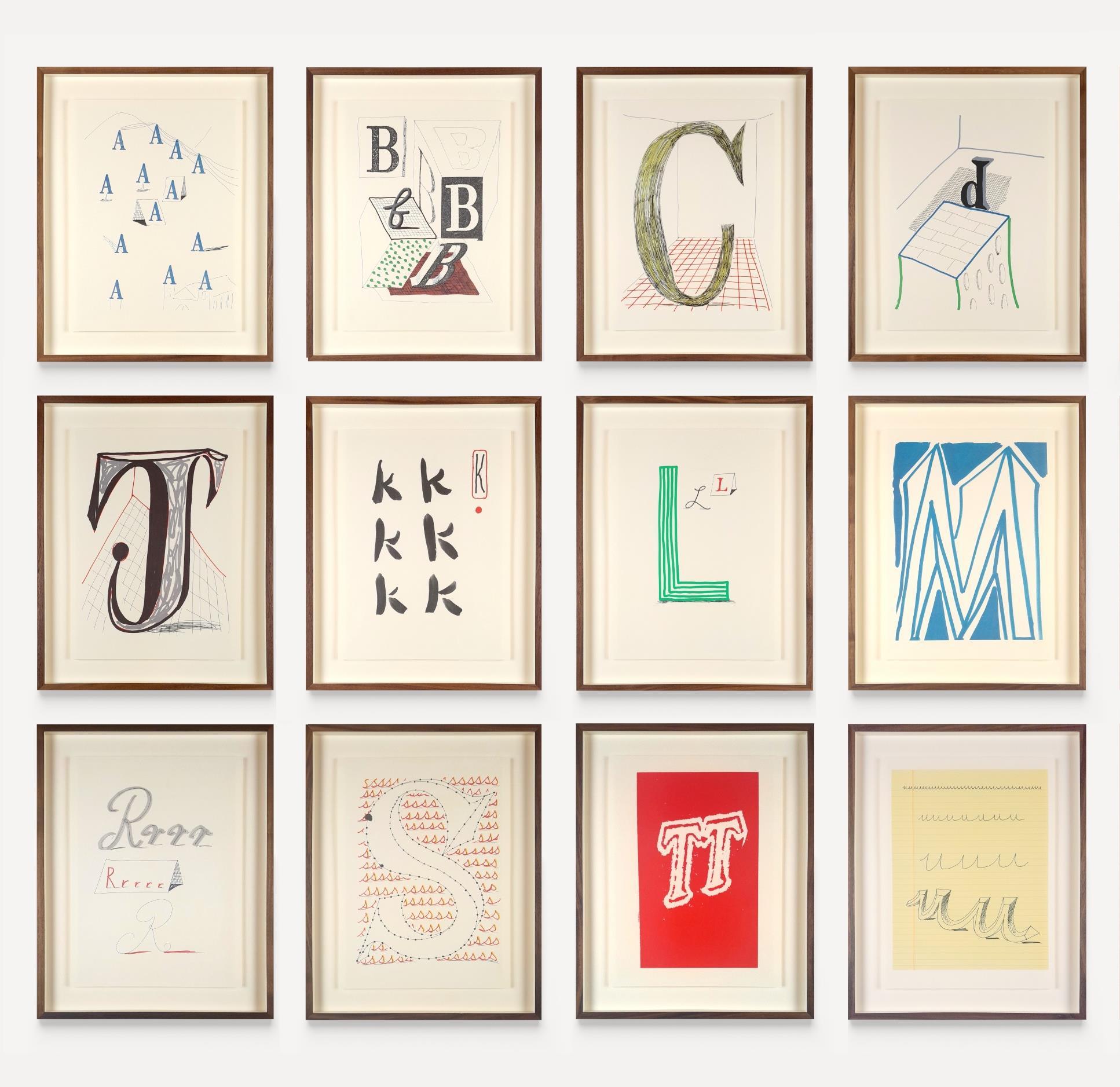GLOUCESTER ROOM

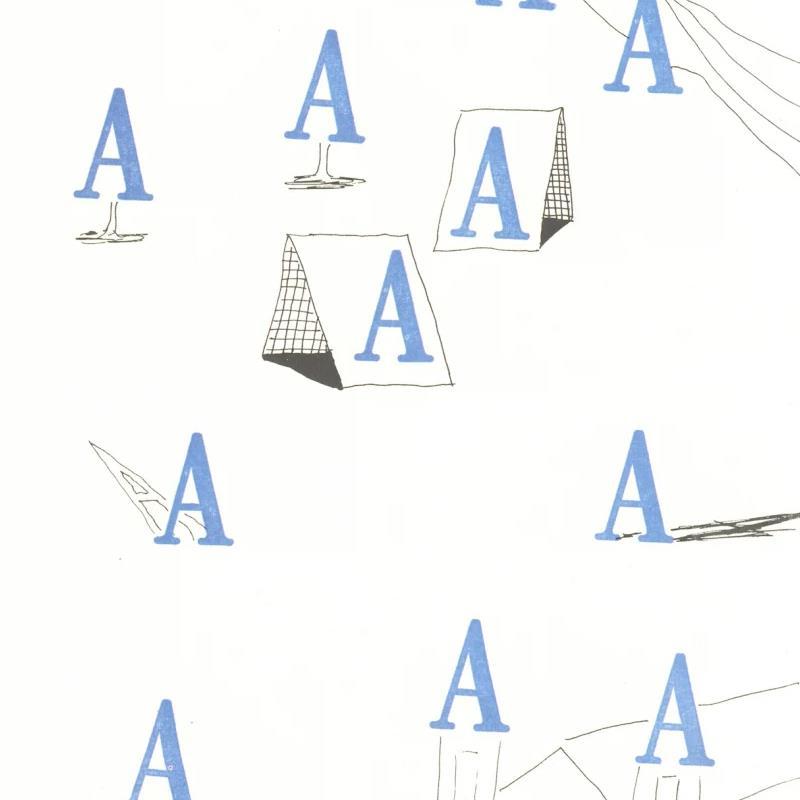
In 1991, on behalf of the Aids Crisis Trust in London, Sir Stephen Spender invited a number of distinguished writers in Britain and America to contribute original texts, prose or poetry, to accompany an alphabet of initial letters specially drawn for the Trust by David Hockney
The writers who have responded, in order of appearance, are Joyce Carol Oates, Irish Murdoch, Paul Theroux, Gore Vidal, Norman Mailer, Seamus Heaney, Martin Amis, Erica Jong, Ian McEwan, Nigel Nicolson, Margaret Drabble, Craig Raine, William Boyd, V.S.Pritchett, Doris Lessing, William Golding, Arthur Miller, Ted Hughes, Kazuo Ishiguro, Julian Barnes, John Updike, Susan Sontag, Anthony Burgess, Douglas Adams and Patrick Leigh Fermor. An unpublished letter by T S Eliot has been given by Mrs Valerie Eliot and Lord Norwich donated a 19th century alphabet poem.
GLOUCESTER ROOM
Mondays – Saturdays 10am – 6pm Sundays 11am – 5pm
5 New Cavendish Street London W1G 8UT
T: 020 7935 1114 info@gloucesterroom.com
DAVID HOCKNEY
Lithograph on cartridge paper
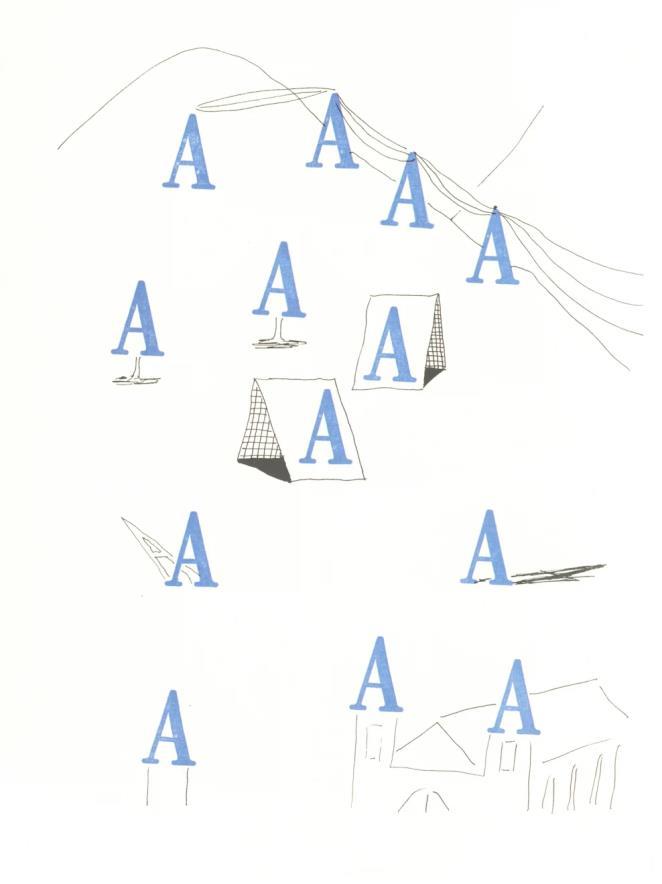
Sheet size: 24 x 32 cms | Frame size: 28 x 36 cms
Accompanied by the poem 'The Alphabet Tree' by Stephen Spender
Presented in a natural walnut box frame
Price framed: £850 | Price unframed: £550 SOLD
Contact us if you are interested in the letter ‘A’, so that we give you priority notice if another becomes available.
Enquire about this item
A
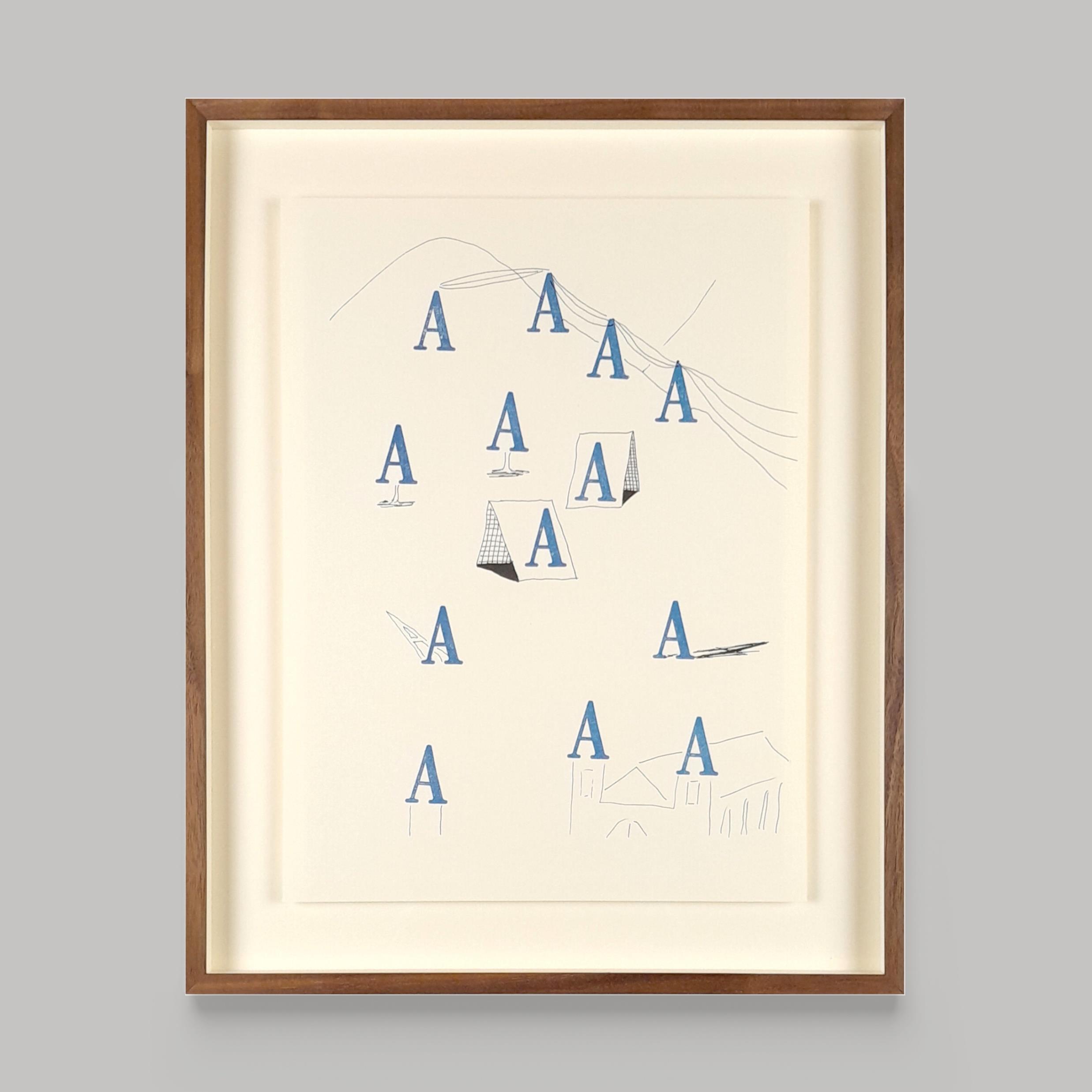
DAVID HOCKNEY
THE ALPHABET TREE by Stephen Spender
Today when I woke
Soon as dawn broke
I saw a tall ladder Set up against The Alphabet Tree.
From on high a Voice spoke:
‘Today you must climb
‘Up the rungs of this ladder
‘Each one a letter
‘Of words in a poem
‘That you must write, ‘Rhyme mirroring rhyme, ‘And complete by midnight
‘When, From A at the root, ‘Heaven-reaching, your head
‘Through the darkness will shoot, ‘To strike letter Z.’
So I climbed up A, B, C, D, E, F and G, H, I, J and K
(I was almost halfway!)
And then, L, M, N, O, P, Q, R and S
(Seven more to success!)
U, V, and W
(Bets on me double now!)
Until I was up At the Tree’s dizzy top.
So I struck letter Z!
Proud, I then read out loud
The poem in my head.
But ‘Alas!’ the Voice said
‘Your poem is a flower
‘Whose petals will scatter
‘On the breeze in an hour,
‘Zeroed by Zephyr
‘And unwept by Ziguener
‘Zizzing his zither
‘Or twanging guitar!
‘But behold, where on high
‘The whole in-black sky
‘Is diamonded
‘With stars of great poets
‘Whose language unfetters
‘Every Alphabet’s letters
‘Interweaving through Time
‘In rhythm and rhyme-
‘Where the living shall read
‘Those more living – the dead!’
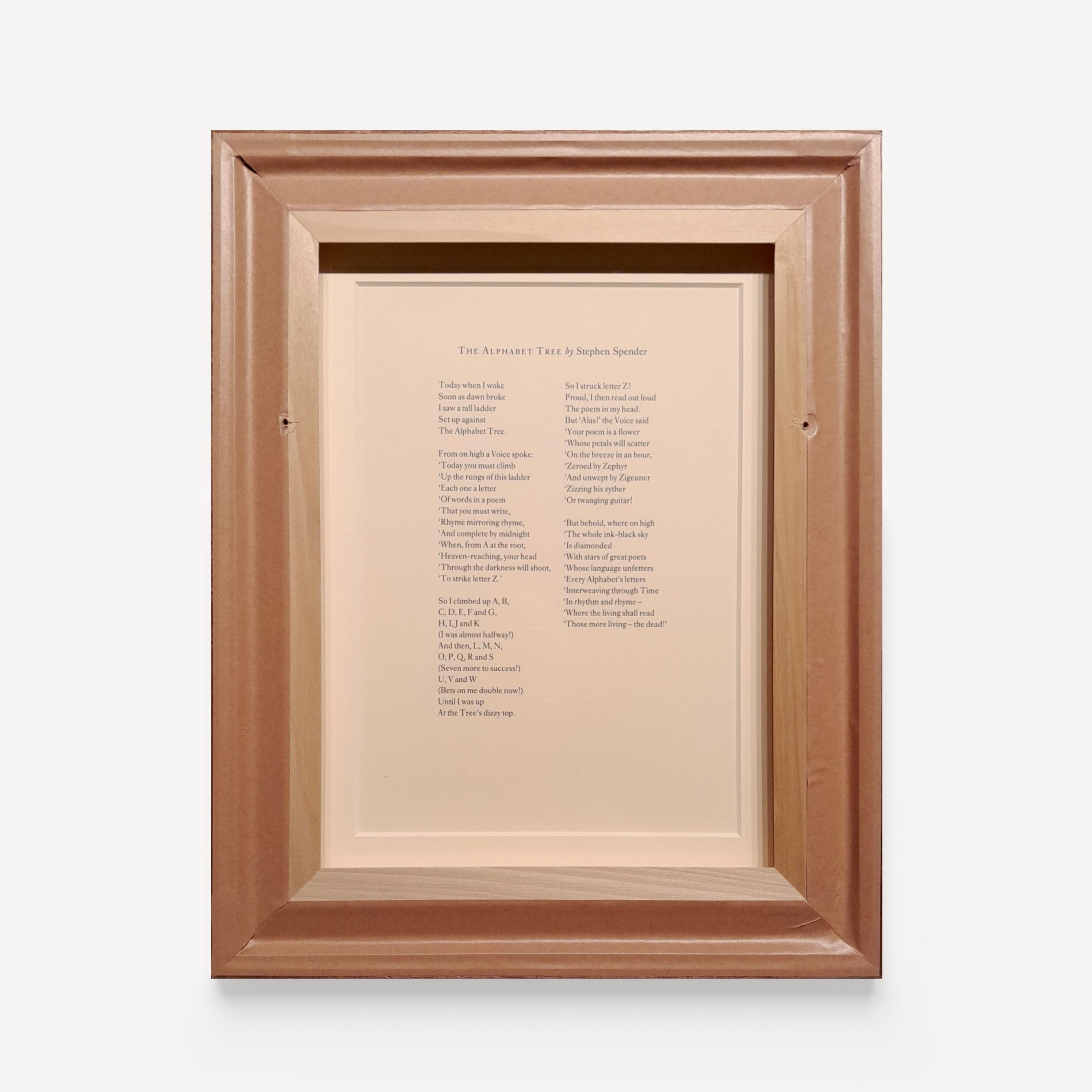
DAVID HOCKNEY
Lithograph on cartridge paper
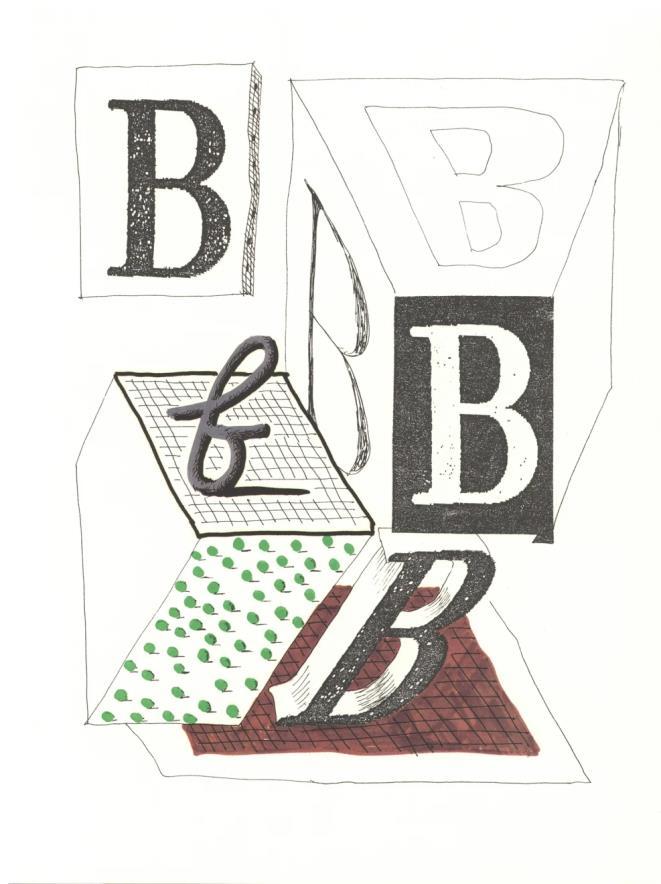
Sheet size: 24 x 32 cms | Frame size: 28 x 36 cms
Presented in a natural walnut box frame
Accompanied by the prose 'B' by Joyce Carol Oates
Price framed: £850 | Price unframed: £550
Contact us if you are interested in the letter ‘B’, so that we give you priority notice if another becomes available.
Enquire about this item
b
SOLD
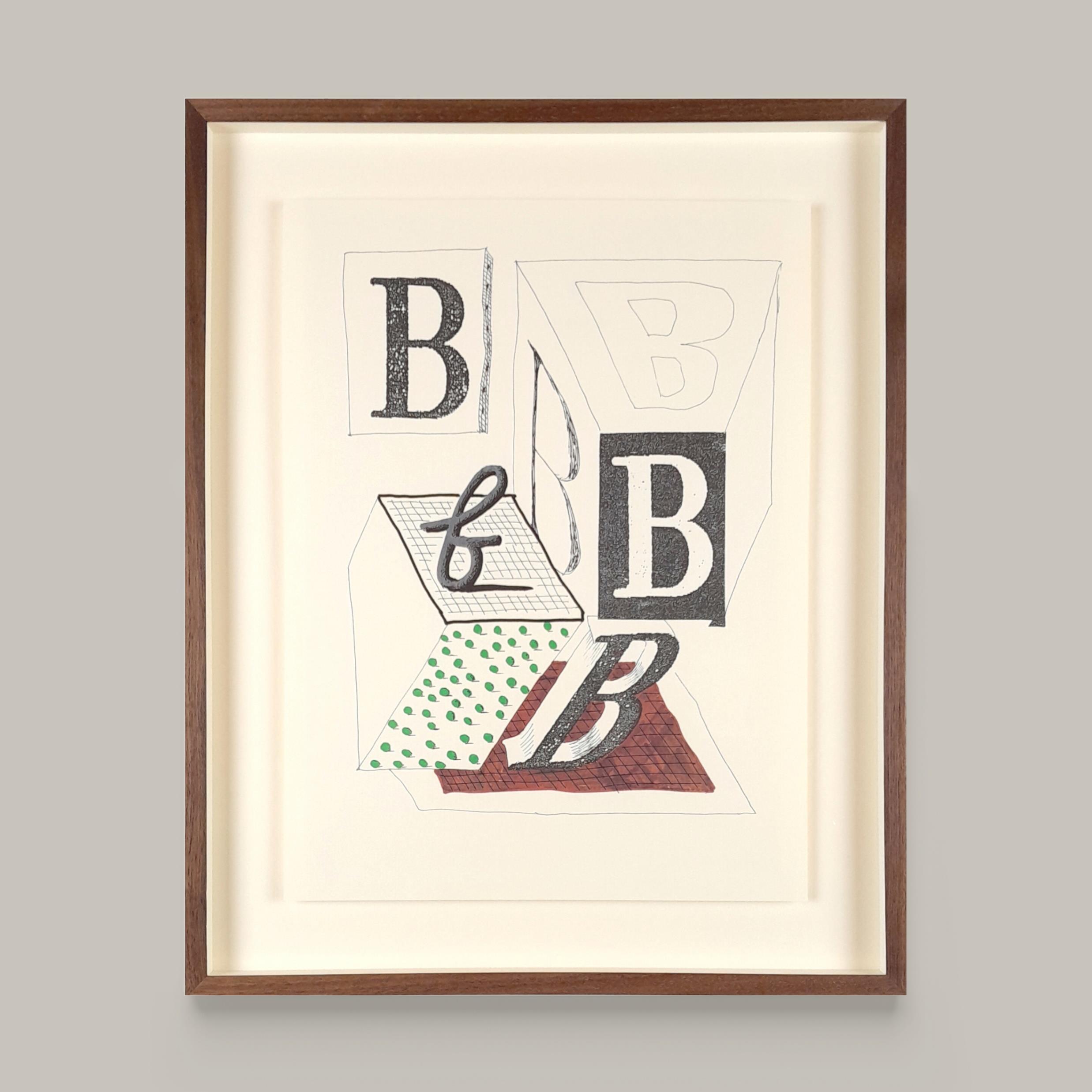
DAVID HOCKNEY
B by Joyce Carol Oates
Of all Bs surely BIRTH is the most profound. The most mysterious. BIRTH. BEGET. BEING. BEGINNING. BEFORE. Nothing is so intimidating, so elusive. No riddle so haunting. If death is decomposition, and (mere) decomposition is death, the disintegration of BEING, still we can grasp its principle: the shattering of a pane of glass, the melting of a snowflake, the shredding of a flower’s perfect petals by a fool’s nervous fingernails, so idle, so purposeless, so common. But BIRTH? BEGETTING? BEING? Who can grasp such principles, such phantasmagoria? Out of what void can BEING spring? – not non-BEING, surely. If there a time BEFORE time? Are we BEGOTTEN out of nothing? At a point equidistant from various nowheres? How I wish, before I die, I could know how, still less why, a seemingly undirected flow of energy washes life, consciousness, particularity, BEING into the universe!
Our BIRTHS are double. The human, historical BIRTHDAY. A time, a place; a mother, a father. The BIRTHDAY to be linked, eventually, with the deathday. But there is also the BIRTH of the idea of us; the BIRTH of the species, excruciatingly slow, apparently blind, groping, relentless; the BIRTH of all animate matter, out of the inanimate materials of stars; the mysterious composition of disparate elements out of the singularity of time zero. Our collective BIRTH out of a single BEGETTING, how many billions of years ago.
Thus BIRTH, of all Bs the most profound. The most mysterious.
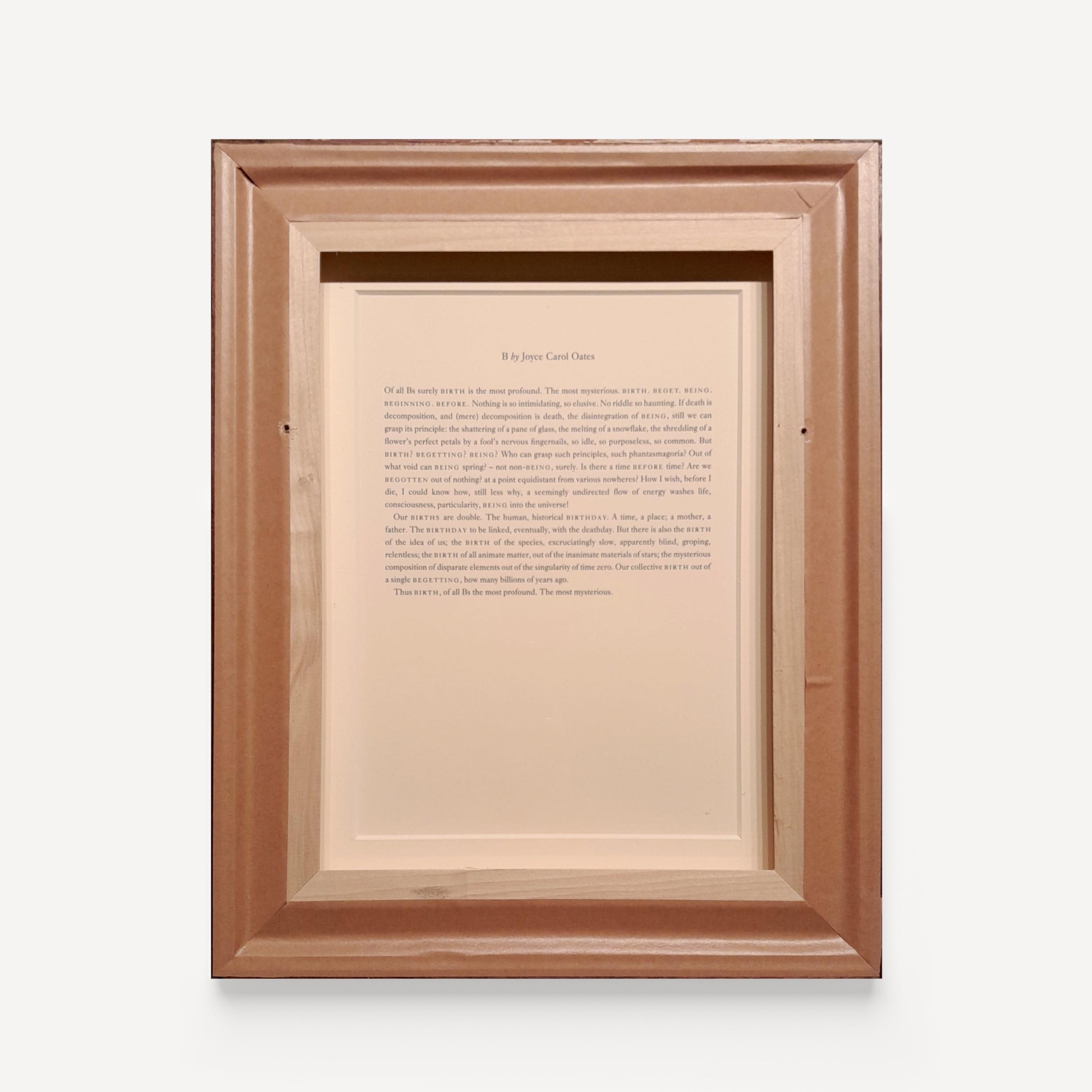
DAVID HOCKNEY
Lithograph on cartridge paper
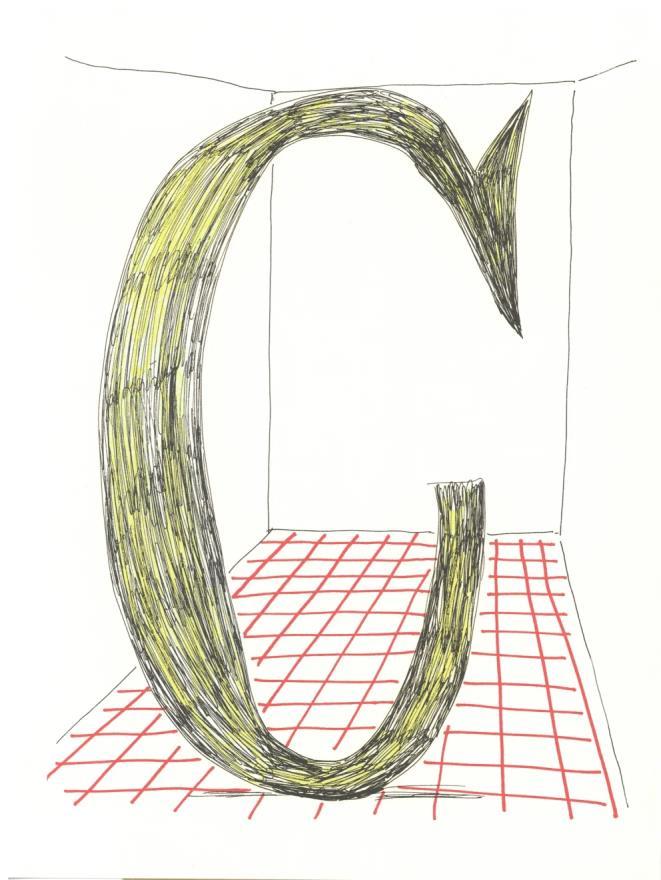
Sheet size: 24 x 32 cms | Frame size: 28 x 36 cms
Accompanied by the prose 'C' by Iris Murdoch
Presented in a natural walnut box frame
Price framed: £850 | Price unframed: £550
RESERVED
C
Enquire about this item
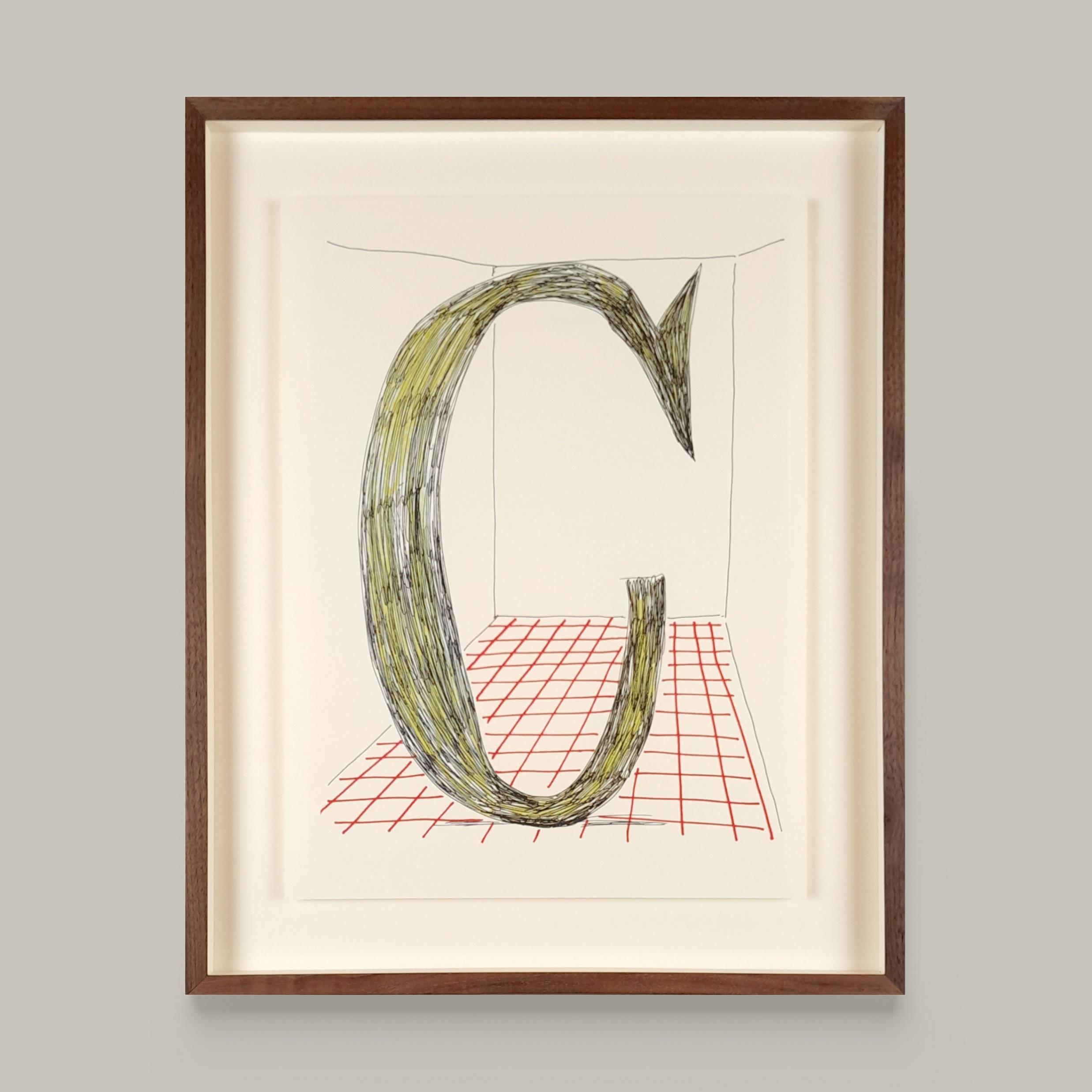
DAVID HOCKNEY
C by Iris Murdoch
I find the letter C a warm comforting friendly sort of letter, perhaps because I first came across it in action in the word CAT. However there is much to be said against it. It lacks authority. It is not interesting or imposing, certainly not self-assertive. When scrawled by hand it can be easily overwhelmed by its more prominent neighbours. It may even be described as a mean shadowy unattractive little sign, scarcely more than an enlarged comma. It is not elegant and comely to contemplate; by comparison, for instance, with A or M it lacks form, it cannot claim to be in itself a little work of art. (Aesthetically, surely the handsomest of letters is the Russian ж.) Moreover, a different charge, C may be said to be actually otiose. Some of our local languages do without it, leaving its tasks to unambiguous S and K signs, others persecute it almost to extinction or disfigure it with unseemly hats or tails. It suffers all sorts of bizarre pronunciations. Nevertheless, for the sake of that old friendship, I feel affection for the poor little letter. After all, who wants a kat.
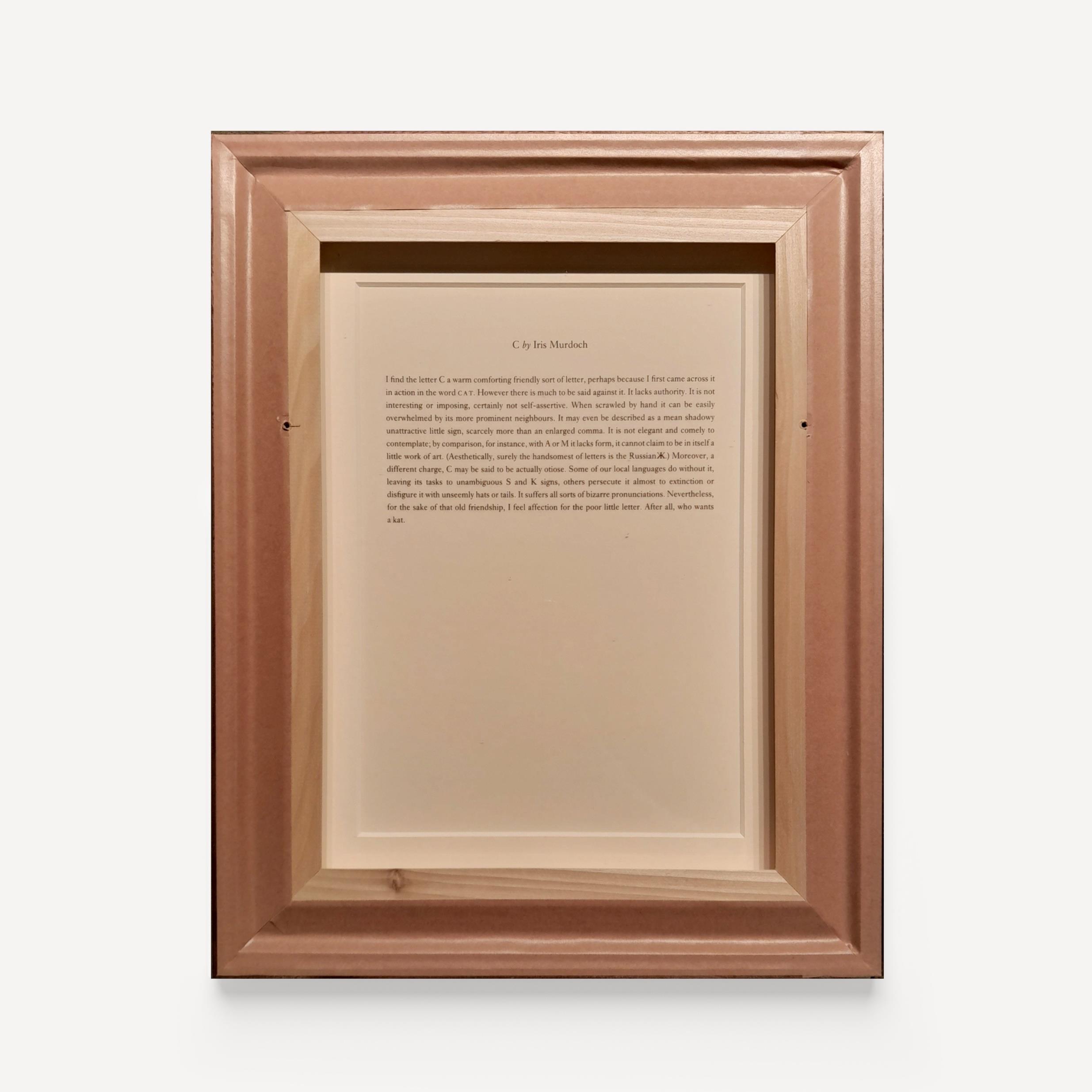
DAVID HOCKNEY
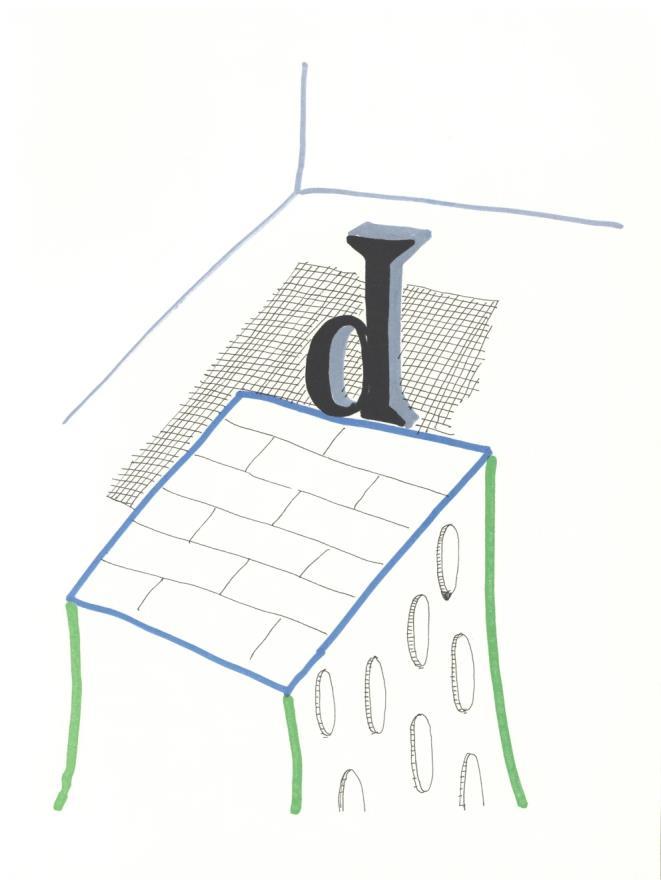
Lithograph on cartridge paper
Sheet size: 24 x 32 cms | Frame size: 28 x 36 cms
Presented in a natural walnut box frame
Accompanied by the prose 'D is for Death' by Paul Theroux
Price framed: £850 | Price unframed: £550
D
Enquire about this item
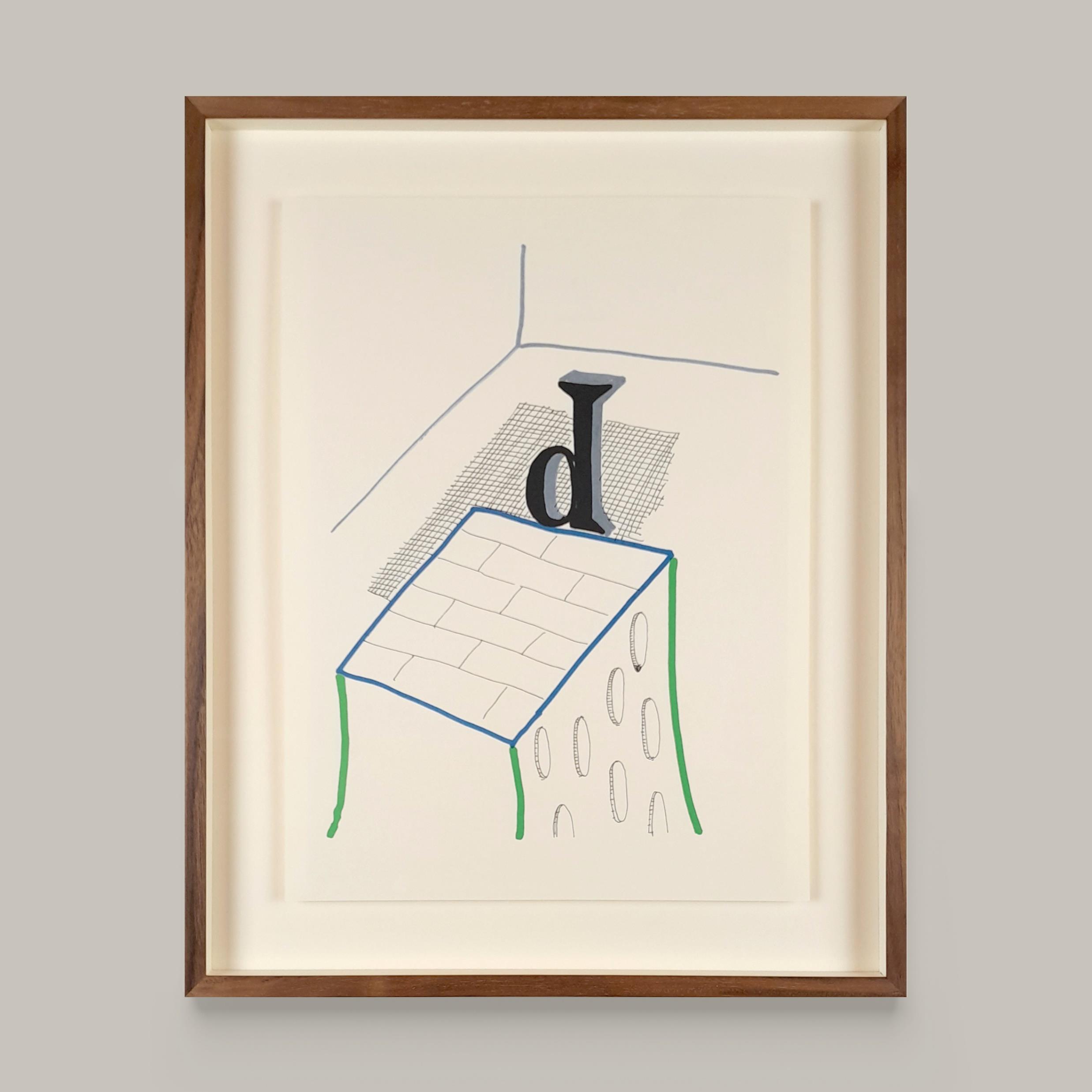
DAVID HOCKNEY
D IS FOR DEATH by Paul Theroux
Death is oblivion, the end of life. Sudden or slow, it is an impartial terror, respecting no one, visiting every being on earth, the old and the young, the sick and the healthy, the wise and the foolish, the innocent and the wicked.
We are dying every second and that unstoppable tick of our mortal clock can fill us with such anxiety that our fear may make us brilliant and ingenious. Throughout history people have invented ways to defy death, by creating works of art, imagining strange gods, taking risks, making sacrifices, attempting to appease its terror, even constructing a whole kingdom beyond death in order to bestow immortality on ourselves.
Death for some is a virus, for others a bullet, a dagger, an on-coming car. It can be a fatal dose of gas or water or fire. For most it is within, the age and decay of the body- struggle, then collapse.
Still death grins at us, omnipotent, god-like – often death is depicted as a fearless skeleton with no sex, a bony comedian wearing a lipless grin. Some see death as evil, a murderer, a revenger, because it is all-powerful. But why see death as a hangman when it is truer to see it as a harvester levelling the earth with its scythe.
Oddly, we take hope from the seasons – the rebirth of spring after the death of winter – or from the rising and setting of the sun. But no spring, no dawn beyond death has ever been proven. Death is an endless night so awful to contemplate that it can make us love life and value it with such passion that it may be the ultimate cause of all joy and all art.
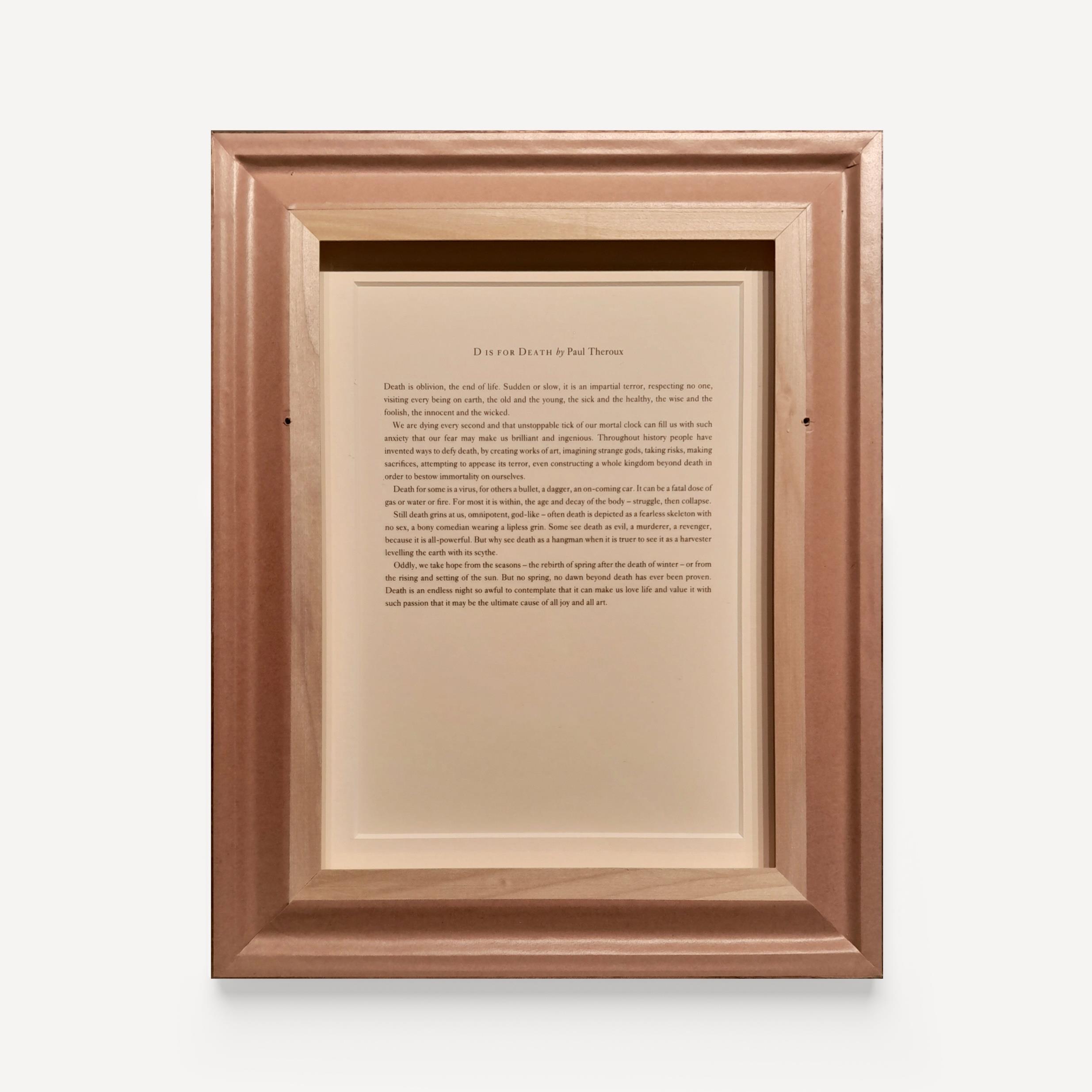
DAVID HOCKNEY
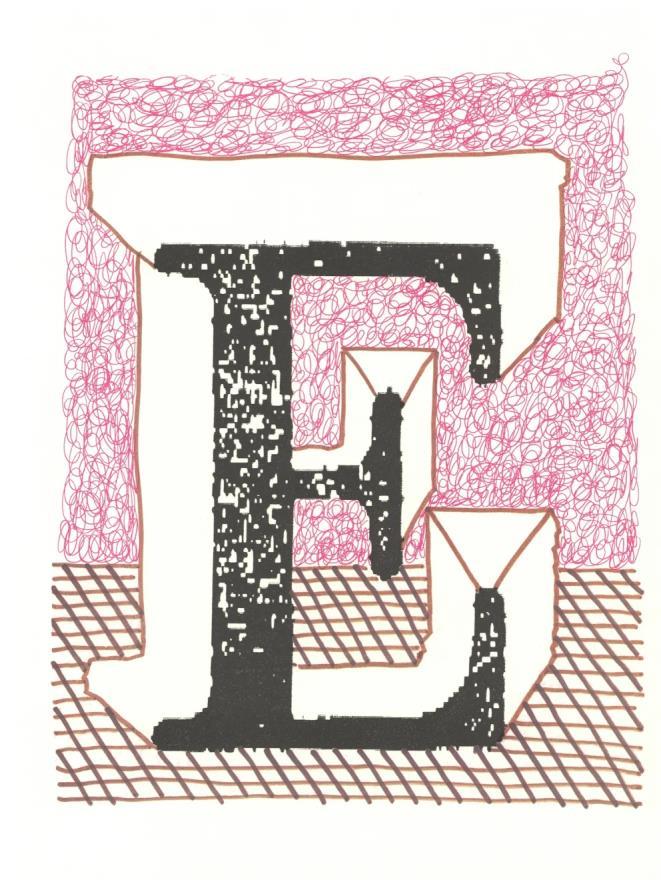
Lithograph on cartridge paper
Sheet size: 24 x 32 cms | Frame size: 28 x 36 cms
Presented in a natural walnut box frame
Accompanied by the prose 'E' by Gore Vidal
Price framed: £850 | Price unframed: £550
SOLD
Contact us if you are interested in the letter ‘E’, so that we give you priority notice if another becomes available.
E
Enquire about this item
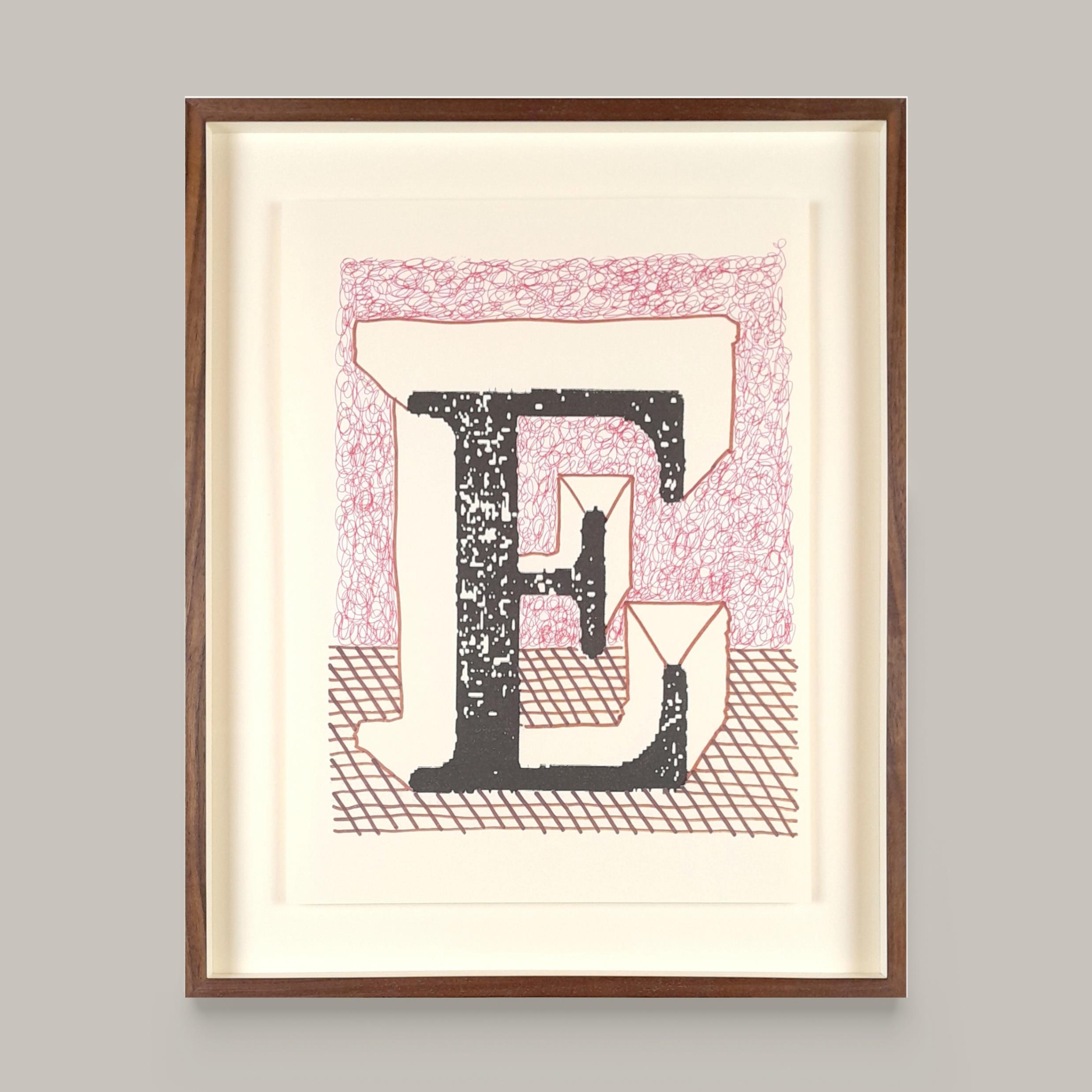
DAVID HOCKNEY
E by Gore Vidal
I have never liked the look of ‘E’. Yes, it is agreeably triune and if you place it on its back there is Neptune’s trident. But placed on its stomach you get a garden rake, gardener’s on-going guilt emblemized. Personally E reminds me of the Christian name that I long ago gave up along with the religion for which it stands – ‘Eugene’. Yes, Eugene means ‘one of noble birth’ but, to an American writer, Eugen is the name of Thomas Wolfe’s windy protagonist, as well as of a playwright whose second wind was even greater than his first. On the positive side, E is the first letter of many Greekderived words – euphonious and euphemistic (Faulkner always mixed up their meanings) and ectomorph. This last is preferable, obviously, to endomorph but then neither can hold a candle (or even an ‘i’) to our old buddy mesomorph, further along in the alphabet. Naturally ‘E’ carried weight as a vowel but for a resident of a Latin country, which I am, the candle ‘i’ is really enough and the confusion that ‘i’ and ‘e’ (together or separately) causes Romancelanguage speakers when they take on English is hardly worth the trouble. But now I’ve written the word ‘English’ and one can move to high happy ground. Nothing wrong with our beautiful vast complex unknowable (by one person) language which so significantly begins with an E. The fact it should be I only adds duplicitous lustre to the vowel letter, so very like a comb, unsnarling hyacinthine locks, taming Medusan curls – E – a cry! The sadness of the Housman sort – Eheu!
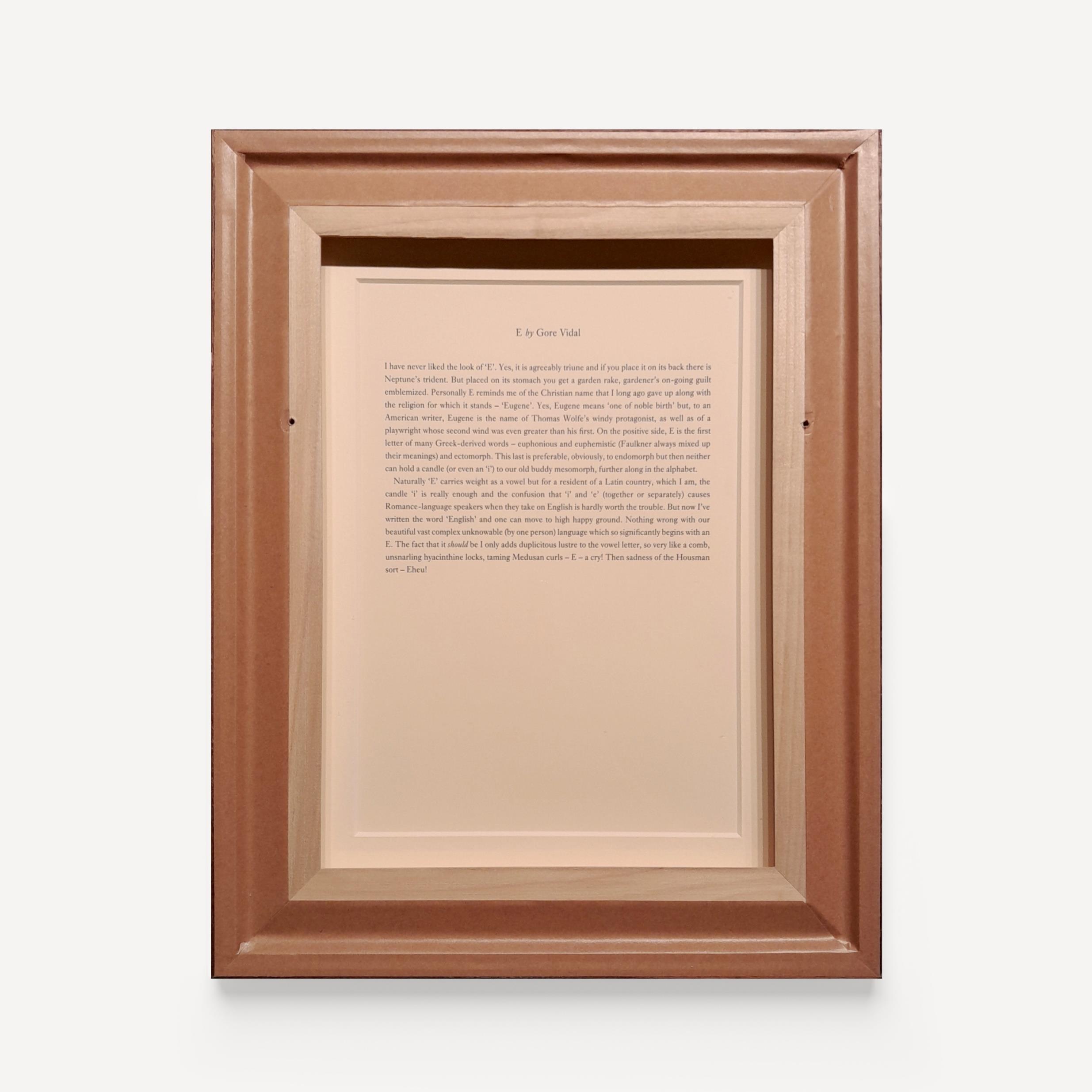
DAVID HOCKNEY
Lithograph on cartridge paper
Sheet size: 24 x 32 cms | Frame size: 28 x 36 cms
Presented in a natural walnut box frame
Accompanied by the letter 'F: a letter' by Norman Mailer
Price framed: £850 | Price unframed: £550
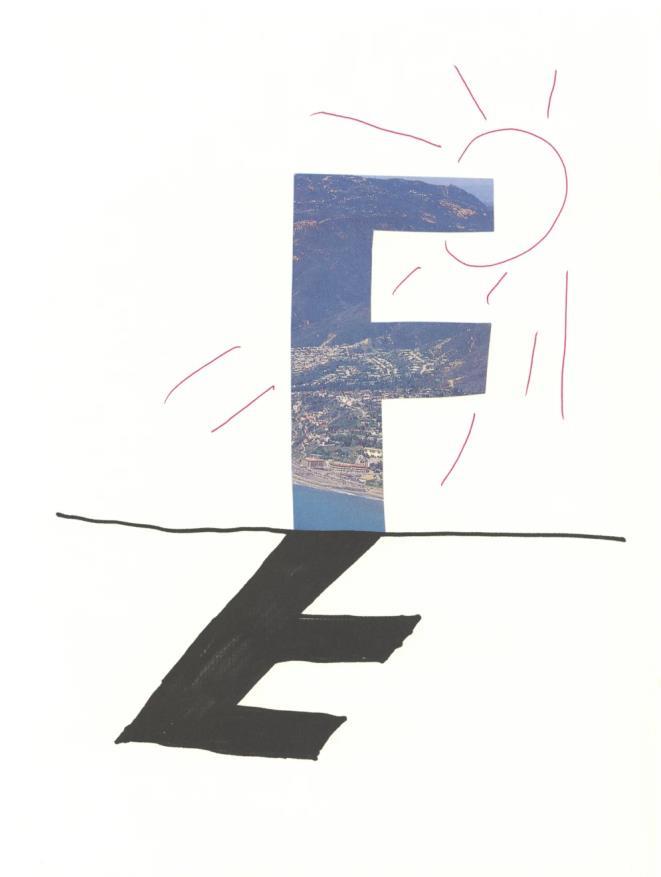
F
Enquire about this item
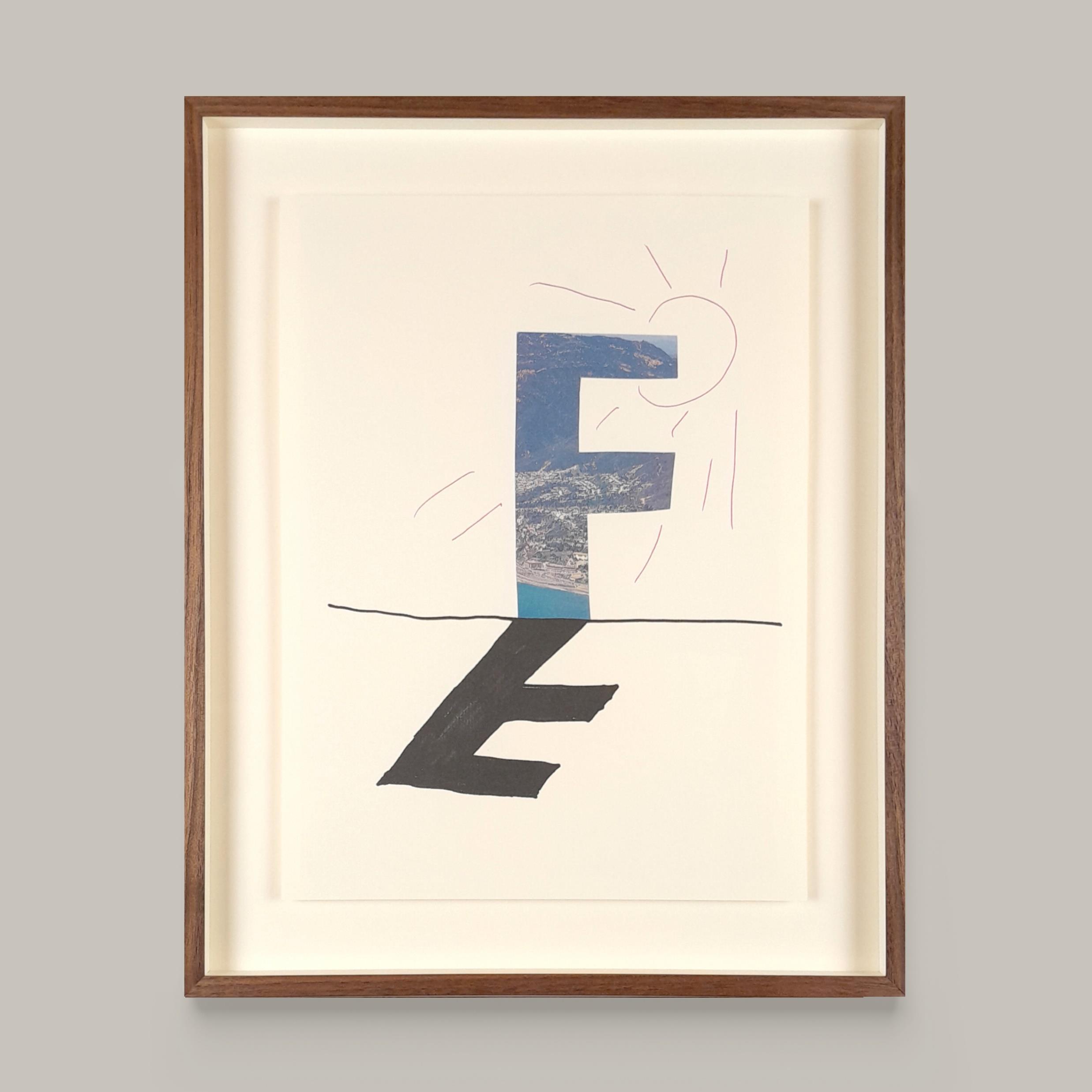
DAVID HOCKNEY
F: a letter from Norman Mailer
23 June 1989
Dear Stephen,
The idea for the book sounds like a lot of fun but I can’t join you. I’m working on a novel and it’s acting like most such creatures – insists upon being a wife. You poets don’t know how lucky you are with your one-night stands. This novel is a most possessive matrimonial partner and won’t let me out of her sight for even two days to let me have some fun with the letter F. Incidentally, I am sure you are aware what a compliment you are paying me with that letter – ahhh, the fonts of fucking. Ah, well, some pleasures one must wave to from afar. Give my best to Marguerite Littman when you talk to her next.
Cheers, Norman Mailer
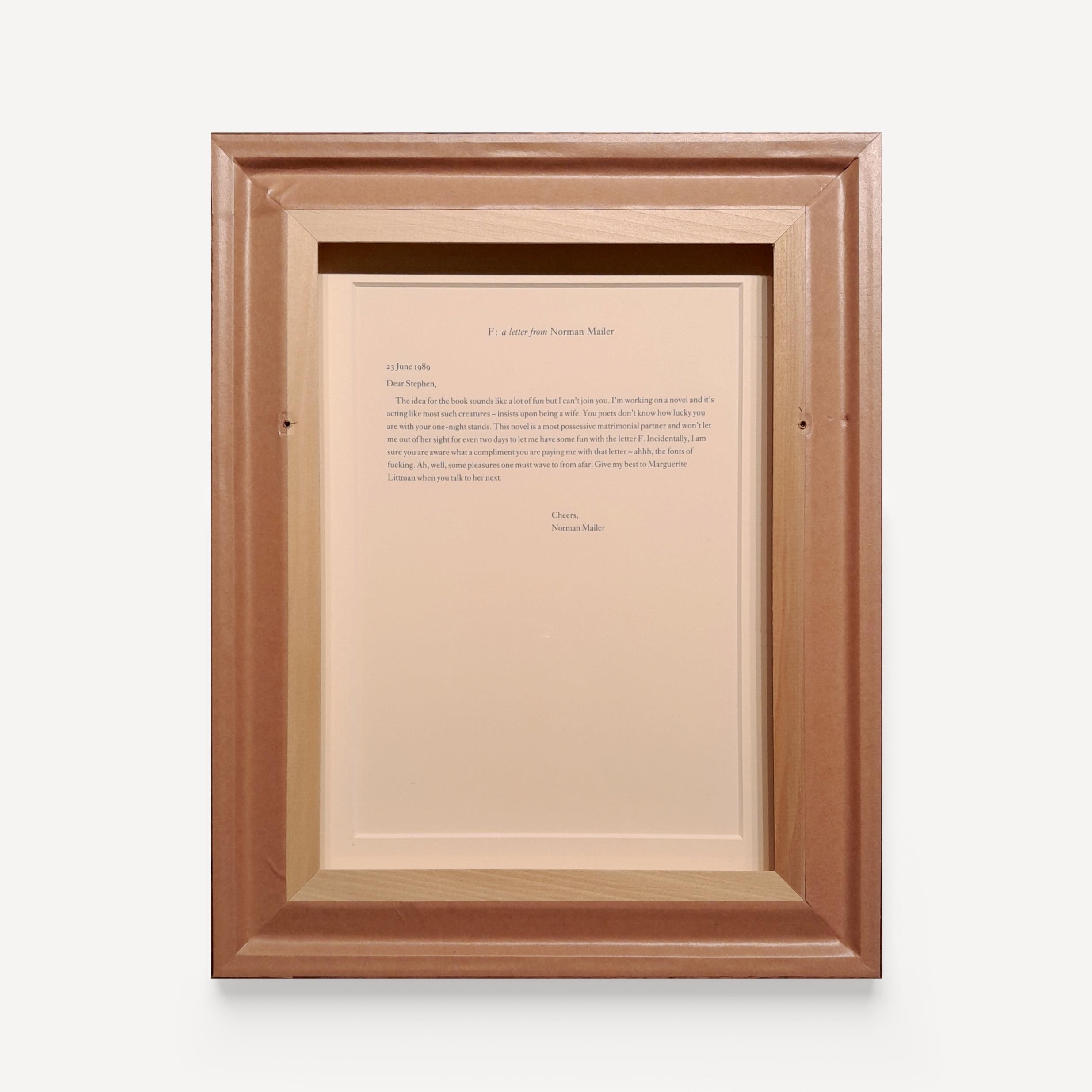
DAVID HOCKNEY
Lithograph on24 cartridge paper

Sheet size: 24 x 32 cms | Frame size: 28 x 36 cms
Presented in a natural walnut box frame
Accompanied by the poem 'G as in Gaelic' by Seamus Heaney
Price framed: £850 | Price unframed: £550 RESERVED
Enquire about this item
G

DAVID HOCKNEY
G AS IN GAELIC by Seamus Heaney
Guh. Guh. Like breath being shunted. The sound of the Gaelic word for voice –written as guth and in the plural having the sense of vowels and rhymes. Another, different voice is glór, voice of the river, say voice of the wind that shakes the barley in gort, a cornfield. And gort is the Irish name for the letter: field full of guh-grain, granary of G-ness.

DAVID HOCKNEY
Lithograph on cartridge paper
Sheet size: 24 x 32 cms | Frame size: 28 x 36 cms
Presented in a natural walnut box frame
Accompanied by the prose H is for Homosexual by Martin Amis
Price framed: £850 | Price unframed: £550
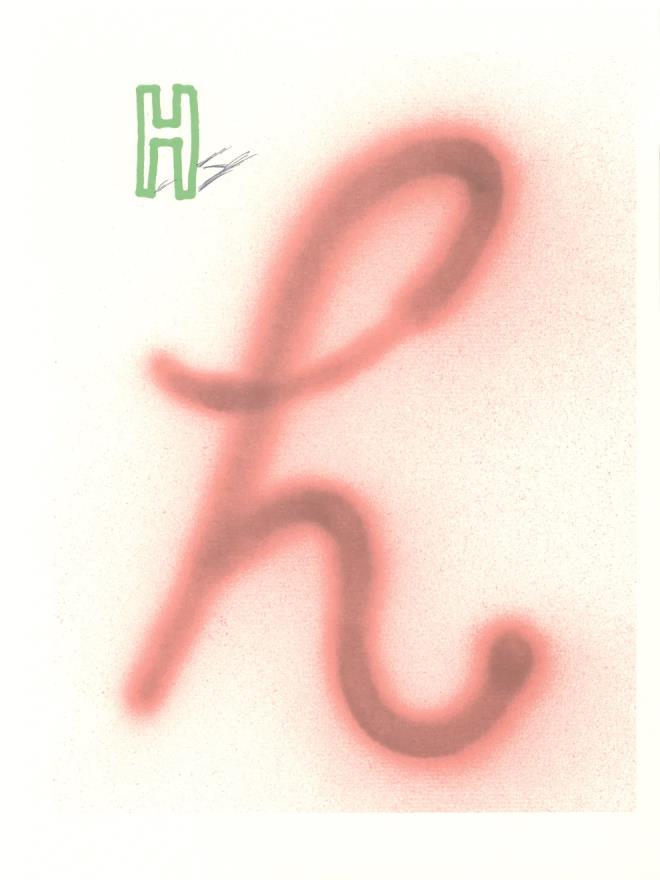
Enquire about this item
H
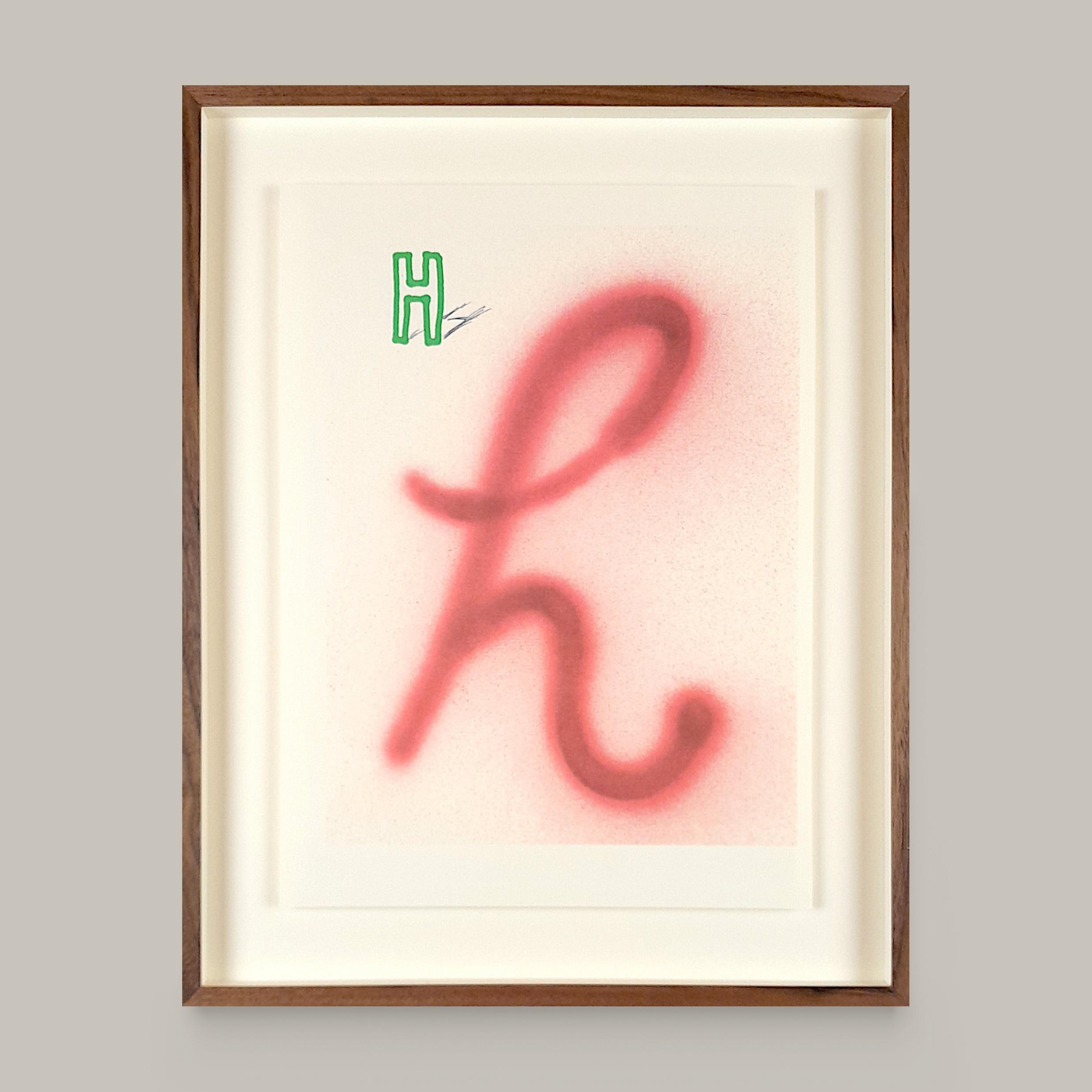
DAVID HOCKNEY
H IS FOR HOMOSEXUAL by Martin Amis
When I was nine or ten, my brother and I obliged a slightly older boy – Billy – on a deserted beach in South Wales. It didn’t last very long, and my brother and I took turns, but our wrists ached all day. These few minutes – later totemized by a friend as ‘Martin’s afternoon of shame with Billy Bignall’ – represent my active homosexual career in its entirety. But the memory leads on to another memory: the nausea and despair I experienced when, at the age of thirteen, I saw my Best Friend walking from the games field with his arm over the shoulders of another boy.
I wish I understood homosexuality. I wish I could intuit more about it, the attraction to like, not to other. Is it nature or nurture, a predisposition, is it written in the DNA? When I think about it in relation to myself, it is not the memory of Billy Bignall that predominates, but the other memory, somehow expanded, so that its isolation and disquiet become something lifelong. In my mind I call homosexuality not a ‘condition’ (and certainly not a ‘preference’). I call it a destiny. Because all I know for certain about homosexuality is that it asks for courage. It demands courage.
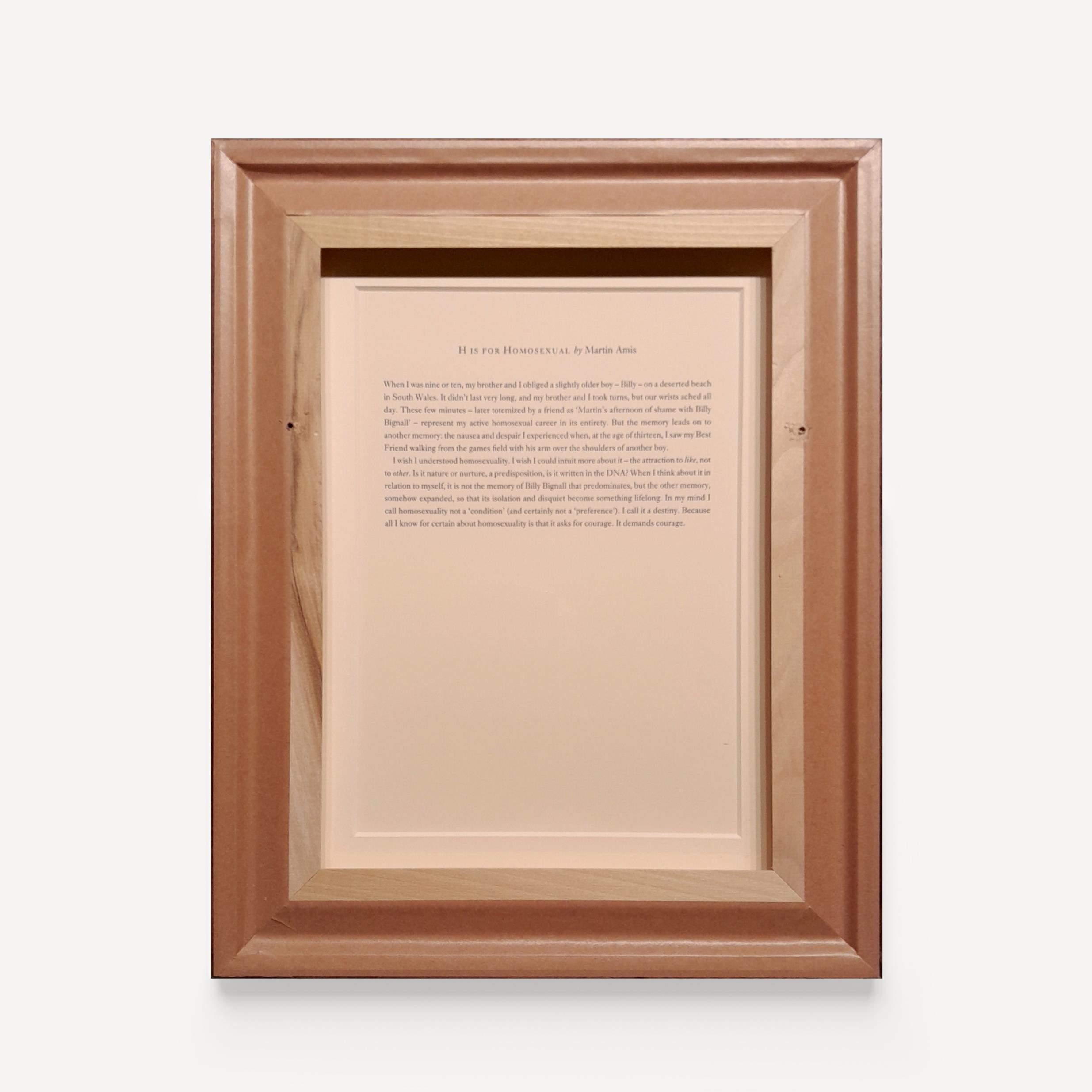
DAVID HOCKNEY
Lithograph on cartridge paper
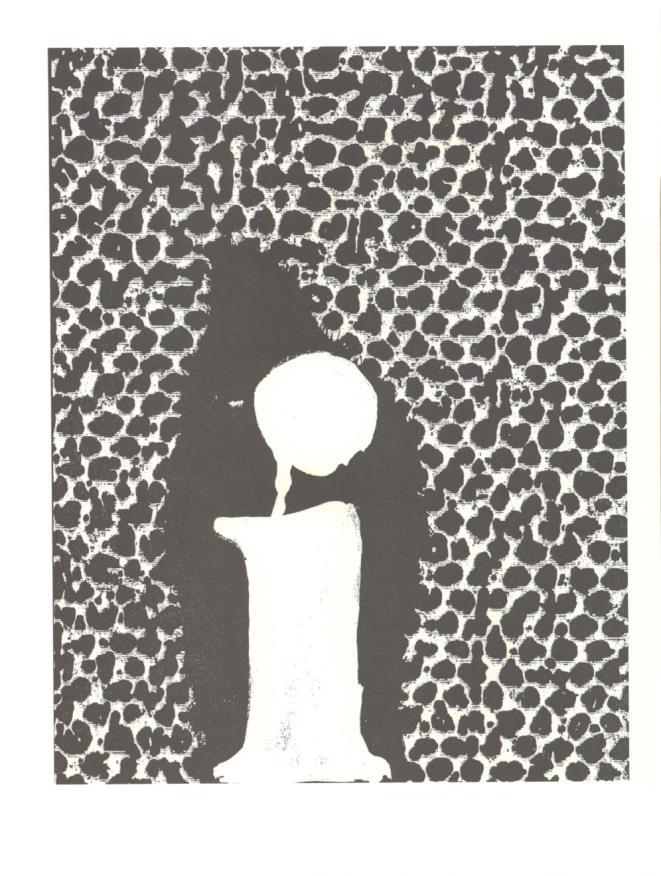
Sheet size: 24 x 32 cms | Frame size: 28 x 36 cms
Presented in a natural walnut box frame
Accompanied by the poem Alphabet Poem to the Letter I by Erica Jong
Price framed: £850 | Price unframed: £550
Contact us if you are interested in the letter ‘I’, so that we give you priority notice if another becomes available.
Enquire about this item
I
SOLD
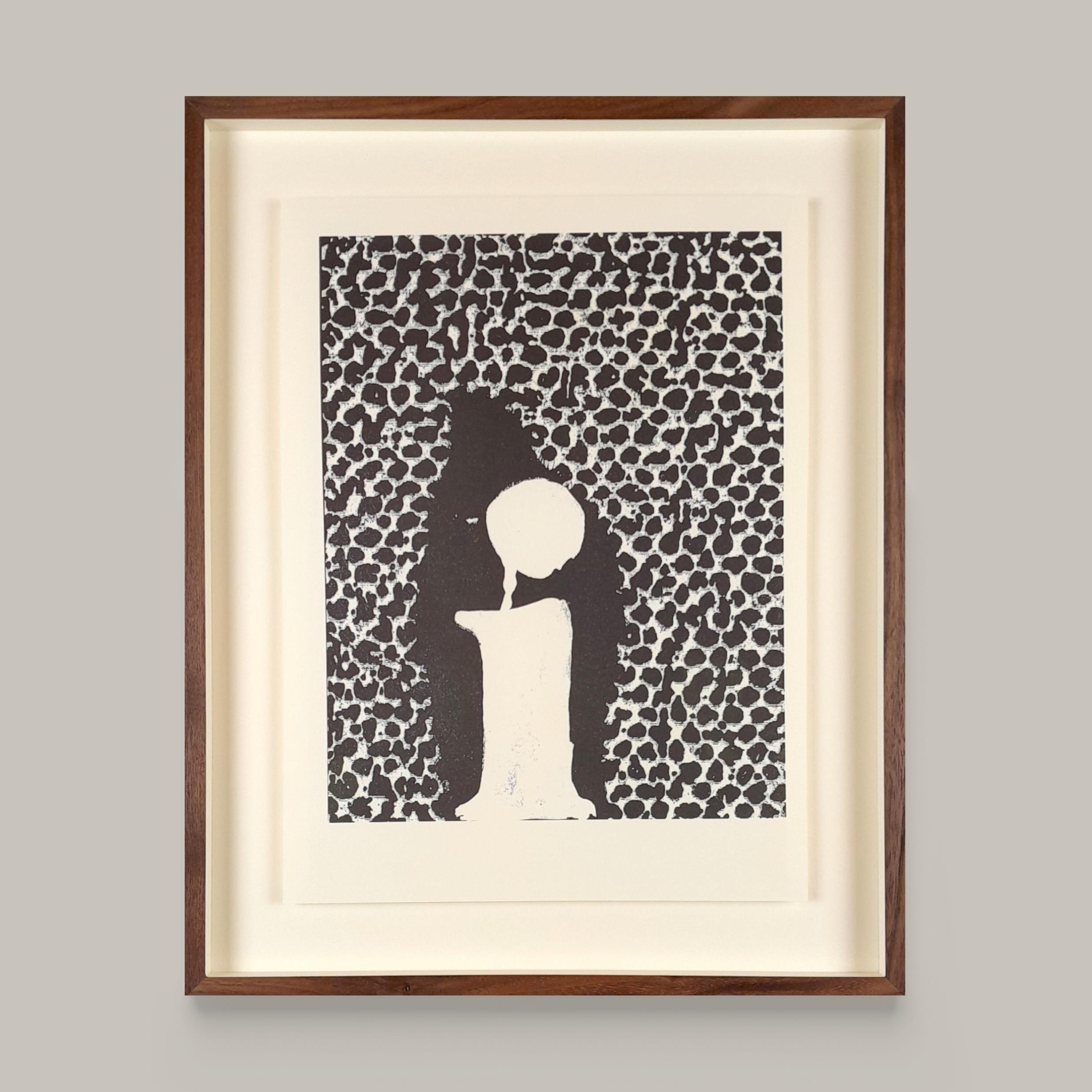
DAVID HOCKNEY
ALPHABET POEM: TO THE LETTER I by Erica Jong
I, io, ich, yo, Я, uppercase, lowercase, sometimes confused with love which starts with L, but could easily be I, with a foot, a pseudopod facing the future, or at least the righthand margin of the page –all we know of life and all we need to know.
The poet must abolish I, said Keats; have no identity, be as water flowing around a rock –a voice for all the unsaid waves within, antenna of the deep.
‘Here lies one whose name was writ in water,’ he would have graven on his gravestone had he but world enough and time –but the harpstring broke, and his dearest friends would not deny his I –(they could not for they still believed themselves).
Ich, I, io, yo, Я turned from lettres majuscules to miniscule
by cummings (ee, I mean)
to droplets of vapor condensed along a blade of grass (by Whitman), to Blake’s tiger, to Dickinson’s buzzing fly (we so insist on having names, then die).
For the poet whoever he (or she) may be is always beneath the violets singing like wind or water…
To become a natural thing, eye of the cosmos, sans i’s, sans teeth, sans everything, to see the rock the hand, the water, rippling around the thrown pebble as part of the same art, the art of the possible, life passing into death and death to life –poetry not politics.
The abolition of the I, eye, eye, the end of i,
so that even the dot becomes a flyspeck, morse code of infinity…
The alphabet is poetry’s DNA; what sperm and egg are to our progeny, the alphabet is to the poet, germ-cells, single, yet dividing like a zygote, characters encompassing the world.
We are all one poet and always we have one communal name, god’s name, nameless, a flame in the heart, a breath, a gust of air, prana whistling in the dark.
i dies –but the breath lingers on through the medium of the magic alphabet and in its wake death is no more than metaphor.
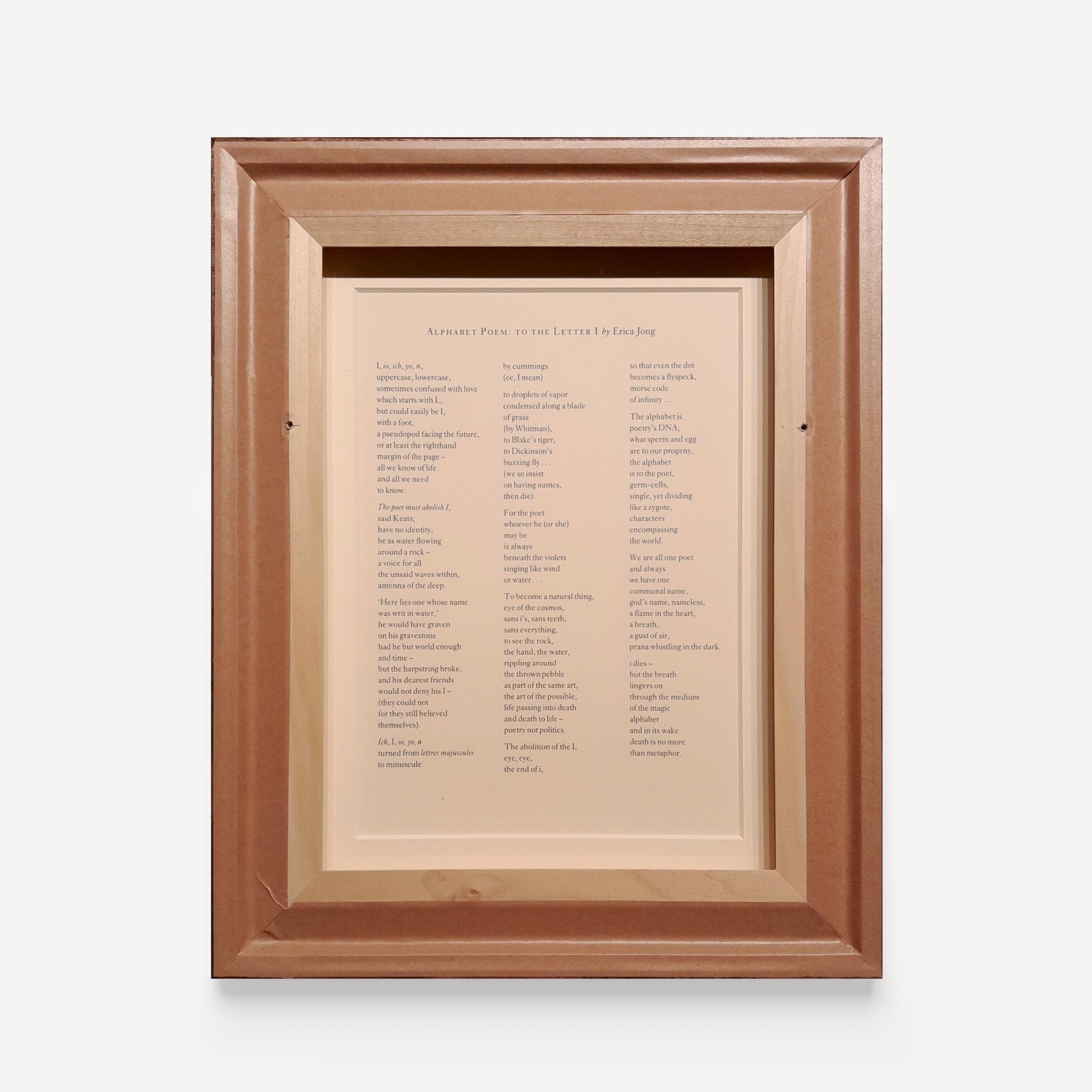
DAVID HOCKNEY
Lithograph on cartridge paper
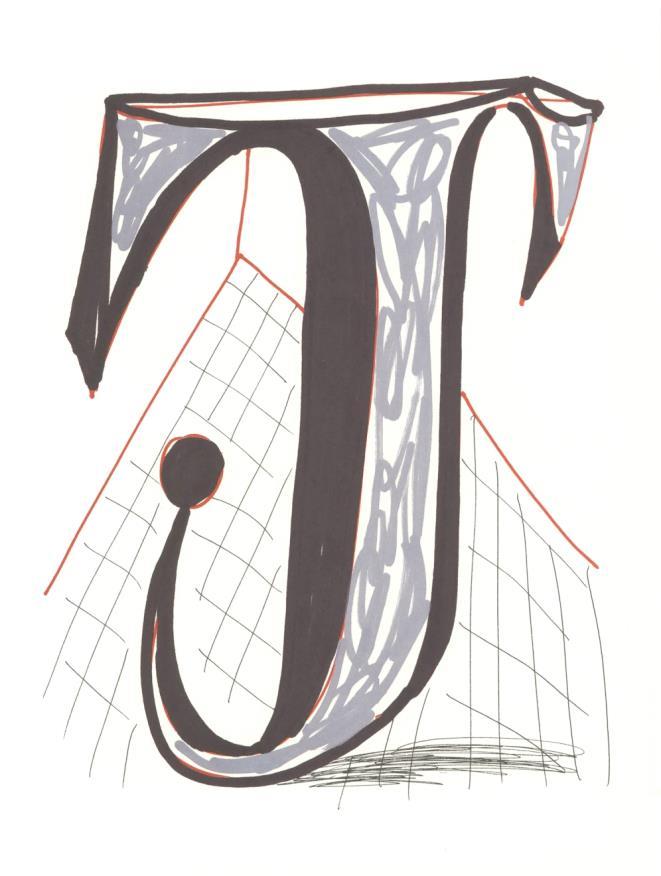
Sheet size: 24 x 32 cms | Frame size: 28 x 36 cms
Presented in a natural walnut box frame
Accompanied by the prose Joy by Ian McEwan
Price framed: £850 | Price unframed: £550 SOLD
Contact us if you are interested in the letter ‘J’, so that we give you priority notice if another becomes available.
Enquire about this item
J
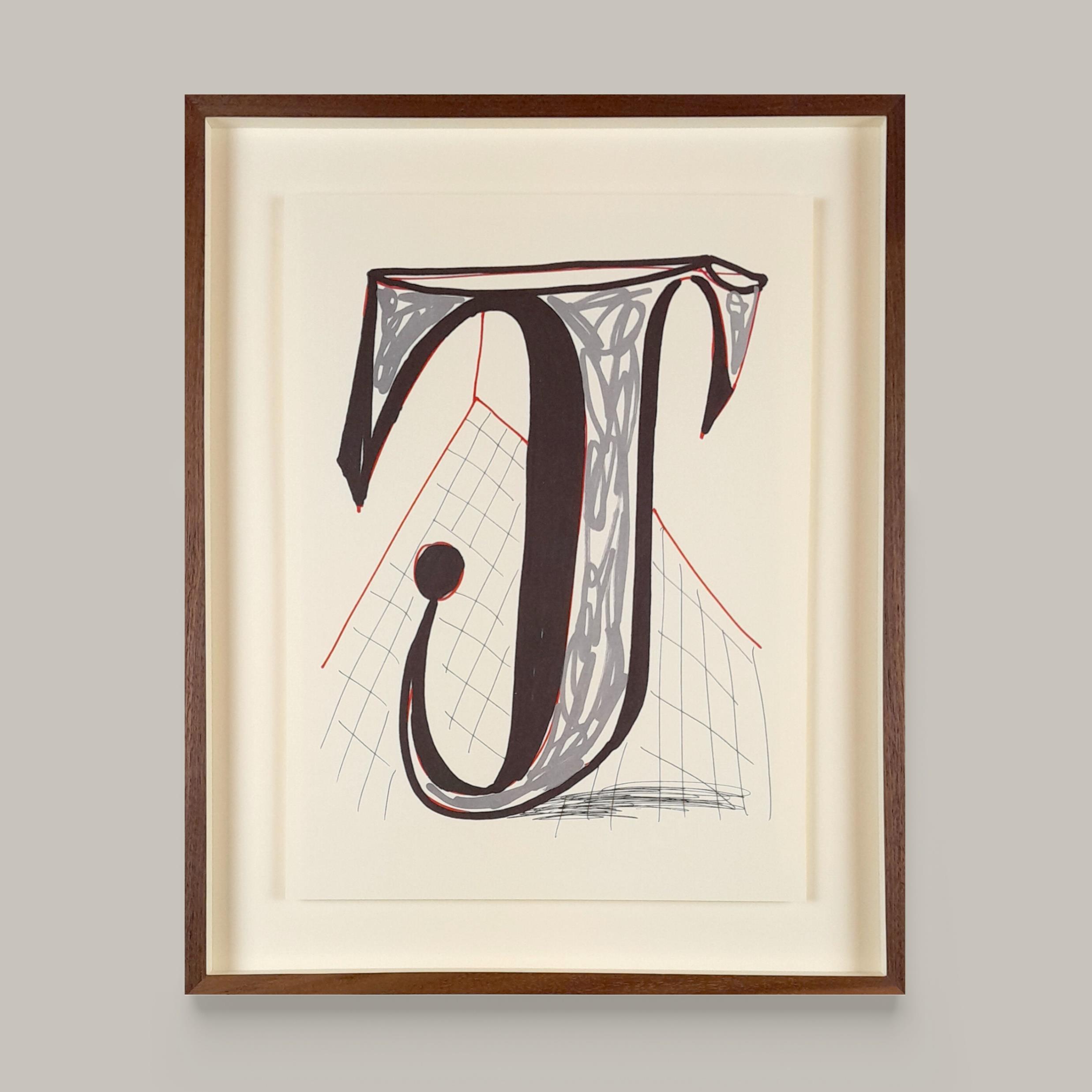
DAVID HOCKNEY
JOY by Ian McEwan
When I was nine and living in Tripoli, Libya, I had an experience of joy, thirty seconds or so that I count as the real beginning of my conscious life.
One early morning during the summer holidays my mother dropped me off at the local beach on her way into work. I was to spend a few hours there alone. I had a packed lunch and some piastas to spend on a fizzy drink.
It was probably seven thirty when I stood at the top of a low cliff by a set of wooden stairs. The tranquillity of the Mediterranean a cleaner, brighter sea then – seemed inseparable from a sweetness in the air and the sound of small waves breaking. The beach of white sand was deserted. It was all mine. The space which separated me from what I saw sparkled with significance.
Everything I looked at – yesterday’s footprints in the sand, an outcrop of rock, the wooden rail beneath my hand – seemed overpoweringly unique, etched in light, and somehow to be aware of itself, to ‘know’. At the same time, everything belonged together, and that unity was knowing too and seemed to say, Now you’ve seen us. I felt myself dissolving into what I saw. I was no longer a son or a schoolboy or a Wolf Club. And yet I felt my individuality intensely, as though for the first time. I was coming into being. I murmured something like, ‘I am me,’ or ‘This is me. ’ Even now, I sometimes find this kind of formulation useful.
The rest of that day is lost. As soon as I moved from where I stood, the memory fades. I suppose I must have run down the steps and across the sand to the water to begin…

DAVID HOCKNEY
Lithograph on cartridge paper
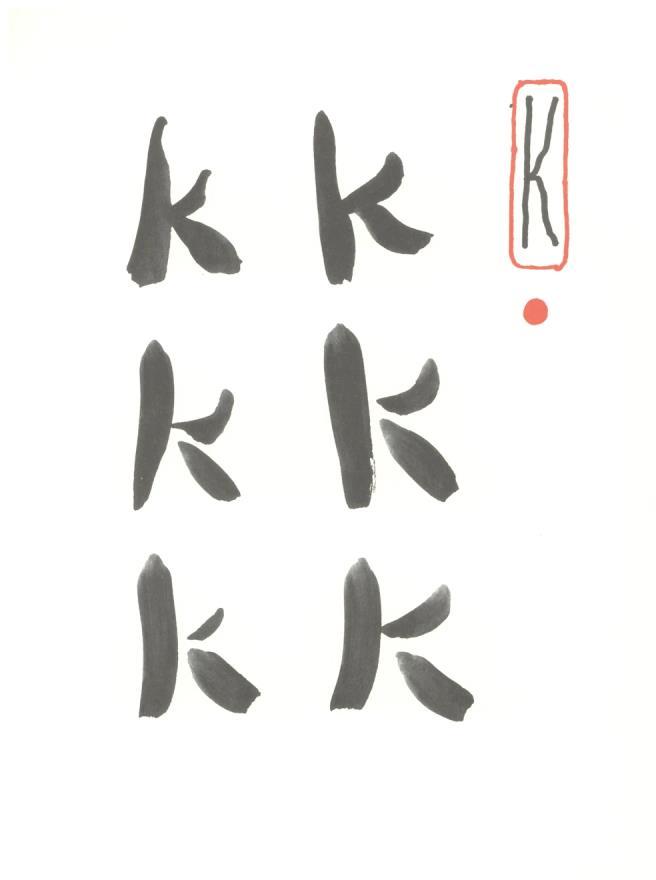
Sheet size: 24 x 32 cms | Frame size: 28 x 36 cms
Presented in a natural walnut box frame
Accompanied by the prose K by Nigel Nicolson
Price framed: £850 | Price unframed: £550
Enquire about this item
K
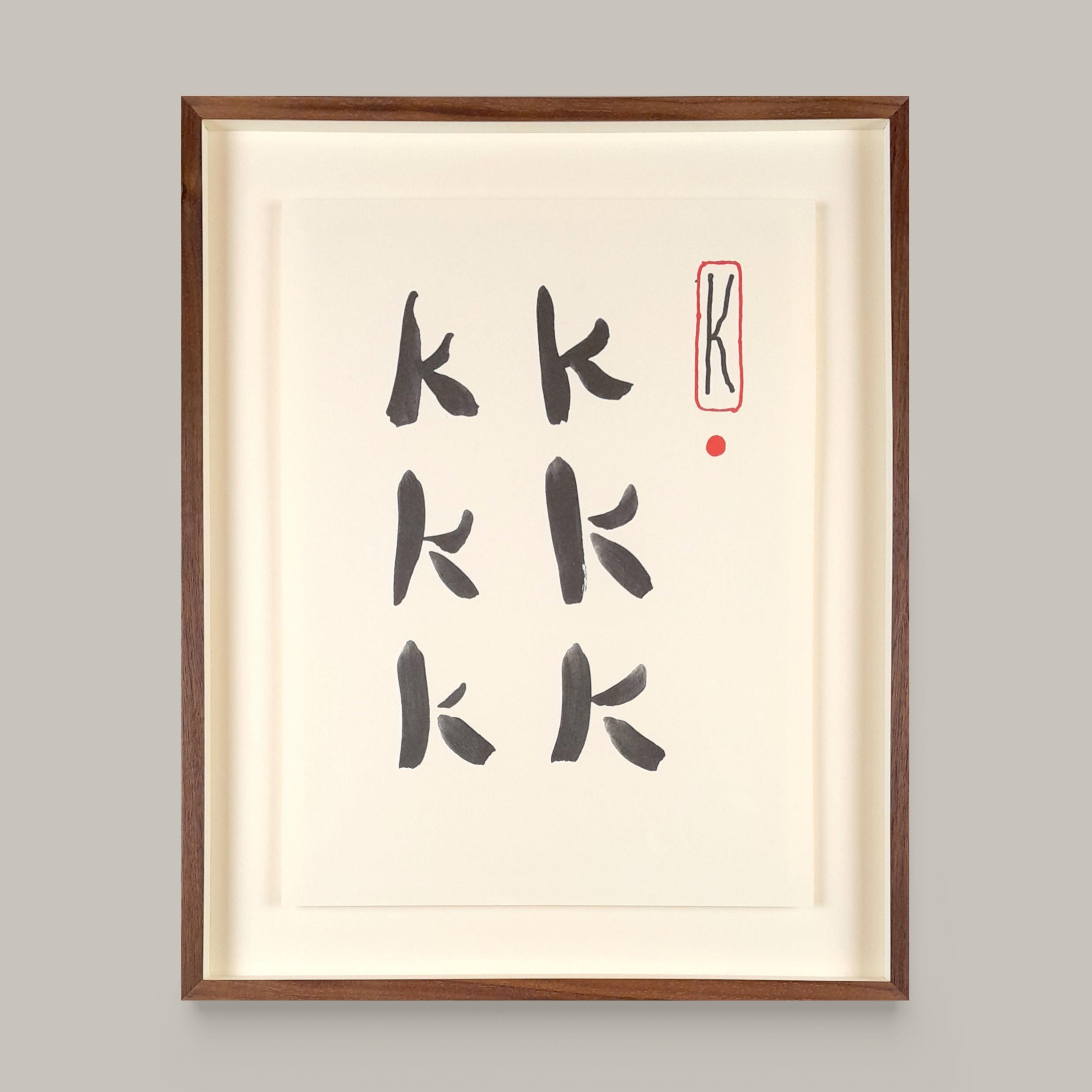
DAVID HOCKNEY
K by Nigel Nicolson
K for me is Kay – and Kay is a girl and an intersection of small streets named after her. Let me explain.
It was April 1944. The front line ran through the middle of Cassino, and we were sitting in (preferably under) the ruins facing the Germans at a distance that varied between 200 yards and the thickness of a wall.
The town had been pulverized by bombardment, and only from air-photographs could one distinguish its original plan. From these we could make out quite distinctly a criss-cross of roads near the centre, in the unmistakable shape, odd for a grid-patterned town, of the letter K. So it was code-named Kay, like a hurricane.
The girl? She worked for the American officers’ club in Naples, which was immensely popular with the British, since the food was better than in our club, and the girls prettier.
I think she was called Kay Summers – anyhow, Kay. We loved her. We told her about her eponymous road-junction, and said that we had it named after her. She asked to see it, and one quiet night we led her, dressed as a Grenadier Guardsman, to stand for fifteen seconds on the spot where the downstroke of the K meets the diagonal. She was illuminated by a sudden parachute flare – but that was by a happy chance.
Kay has been obliterated by the rebuilding of Cassino. Kay has been rebuilt too, slightly stouter, but has not been obliterated. She teaches a class of juniors in Tulsa, Oklahoma.
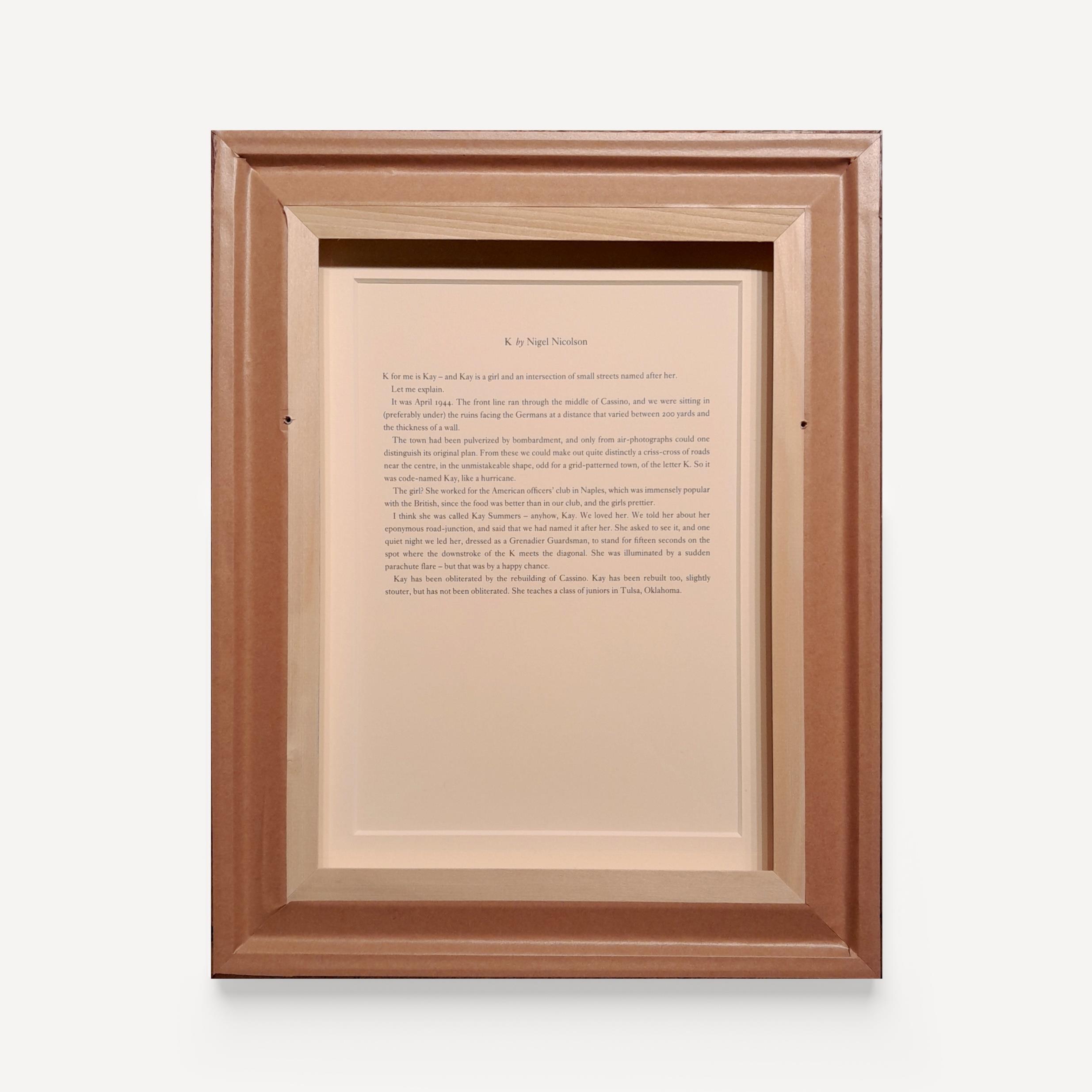
DAVID HOCKNEY
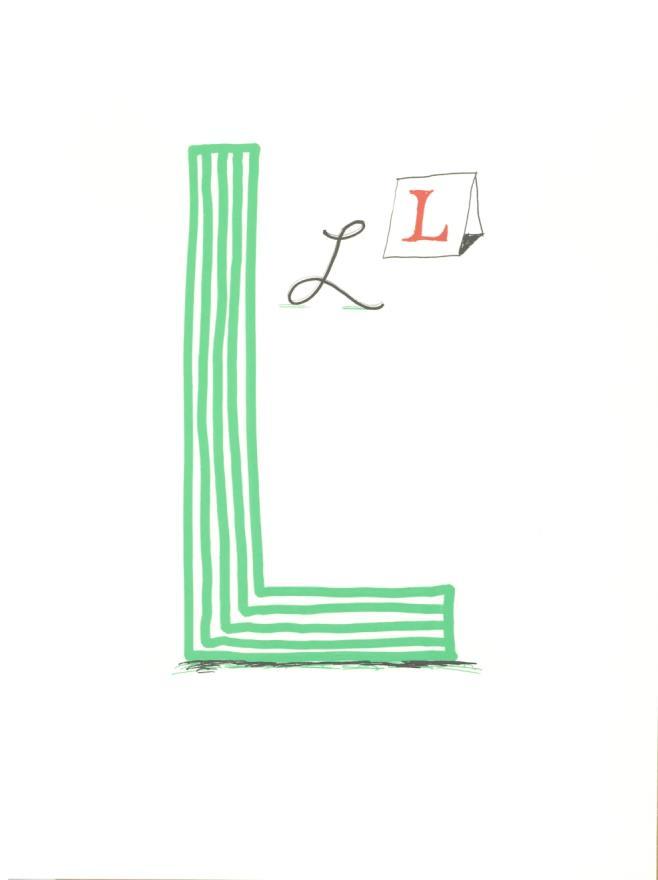
Lithograph on cartridge paper
Sheet size: 24 x 32 cms | Frame size: 28 x 36 cms
Presented in a natural walnut box frame
Accompanied by the prose L for Laughter by Margaret Drabble
Price framed: £850 | Price unframed: £550
Contact us if you are interested in the letter ‘L’, so that we give you priority notice if another becomes available.
Enquire about this item
L
SOLD
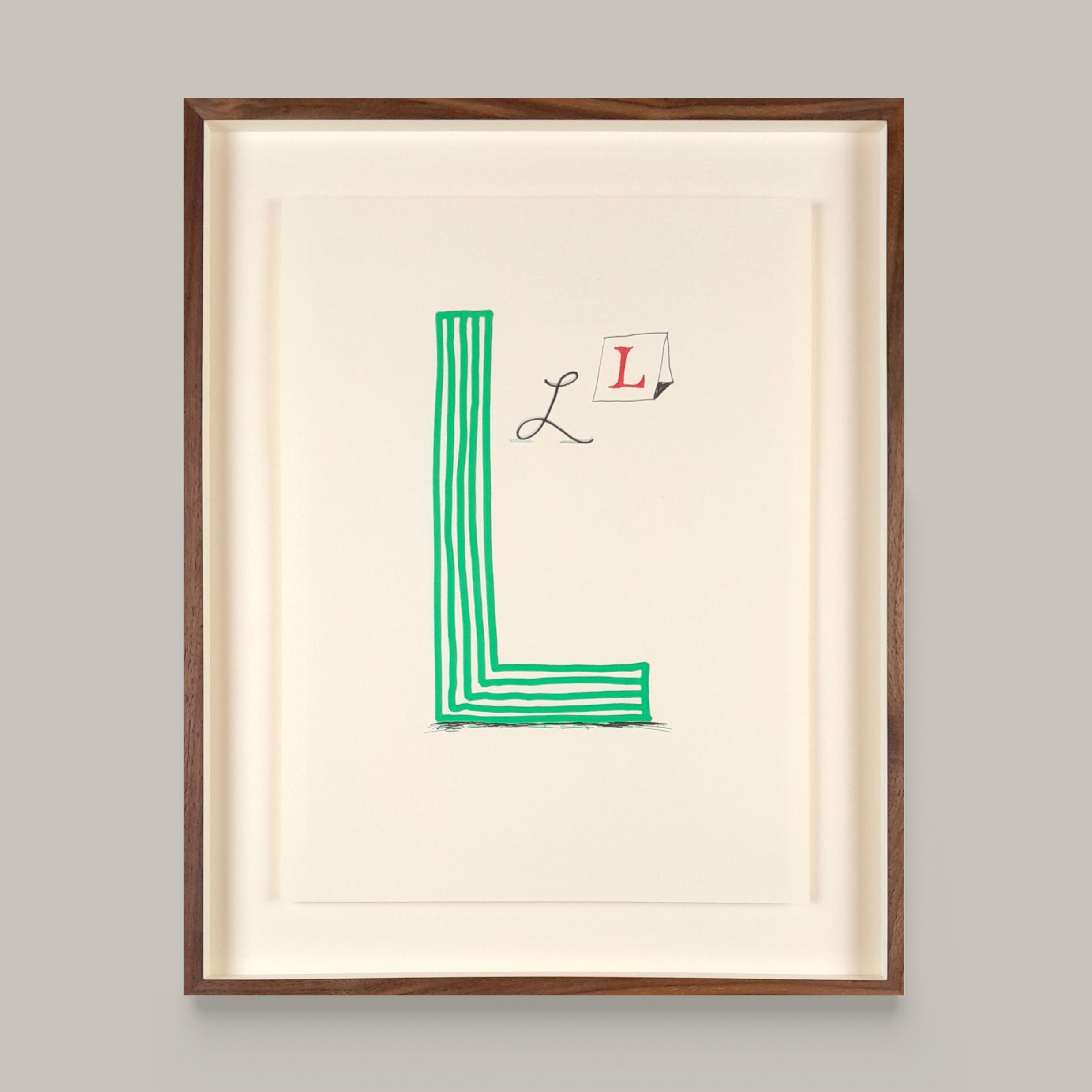
DAVID HOCKNEY
L FOR LAUGHTER by Margaret Drabble
L is for Laughter, which has been well considered one of the strangest and most glorious of human faculties. Some say it is a uniquely human gift, and that animals do not have a sense of humour. This, despite the smile of the Cheshire Cat and the grin of many a dog I have known, may well be true. What is laughter? The dictionary tells us it is the ‘spasmodic utterance, facial distortion, shaking of the sides, etc.’ which expresses ‘mirth, amusement, sense of the ludicrous,. etc.’ Is it common to all cultures, and when did it originate, in what dark palaeolithic joke or double entendre or prattfall? These are questions at least as well worth pondering as the carnivorous or cannibalistic instincts of our ancestors, but I suppose the evidence, being perishable, is inevitably hard to uncover.
Why do we laugh at some jokes, and merely smile at others? When is our laughter most spontaneous, most sincere? Some writers make us laugh aloud to ourselves when we are alone in a room – P.G. Wodehouse, Evelyn Waugh, Michael Frayn, Marcel Proust. Are we then laughing to share our mirth with others?
Theatre laughter is another matter, and there are several varieties of it. Canned laughter, corpse laughter, catching laughter. These are some London laughs so distinctive that we can recognise them in any auditorium. (I speak feelingly, because I used to be married to one of them and the sister-in-law of the other: both belong to fine comic actors, who are generous with their recognition of the skills of others.) Sometimes we laugh to demonstrate our understanding, sometimes we cannot help it. At children’s parties in the 1940s we used to laugh so much at those creaky old Laurel and Hardy movies that we helplessly wet our pants as we bounced around on the old three-piece settee. Rarely comes now that spirit of delight, which perhaps is just as well. Do modern children laugh as wildly, as indecorously?
They say that laughter is cruel, that the heart of comedy is cruelty. We laugh in contempt and scorn. We laugh at the misfortunes of others. All that is true. But we can also laugh at ourselves, and in this we become double human. And do we not, in looking back on friendships, holidays, parties, good times, remember the laughter even when the jokes are forgotten?
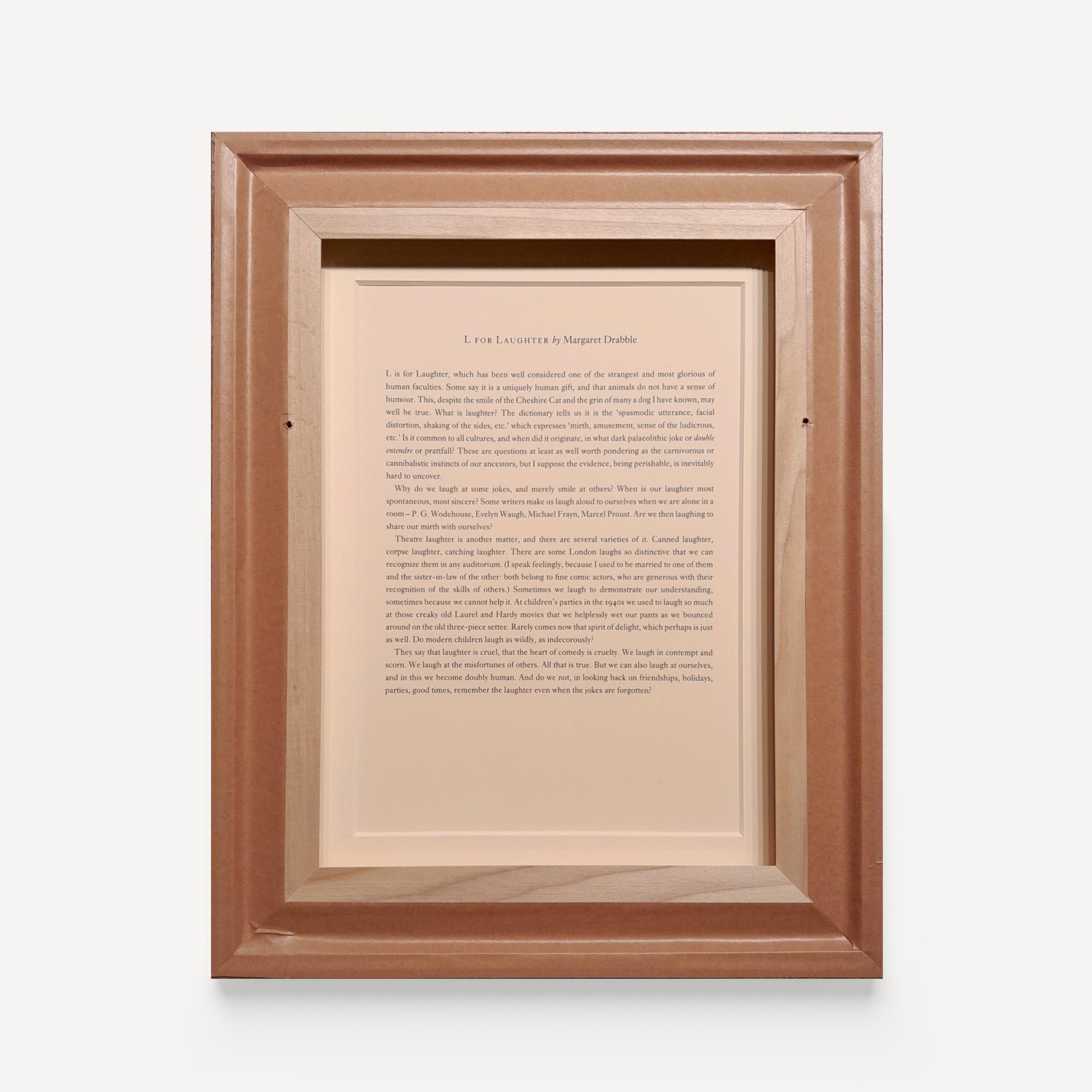
DAVID HOCKNEY
Lithograph on cartridge paper
Sheet size: 24 x 32 cms | Frame size: 28 x 36 cms
Presented in a natural walnut box frame
Accompanied by the poem Muybridge by Craig Raine
Price framed: £850 | Price unframed: £550
Contact us if you are interested in the letter ‘M’, so that we give you priority notice if another becomes available.
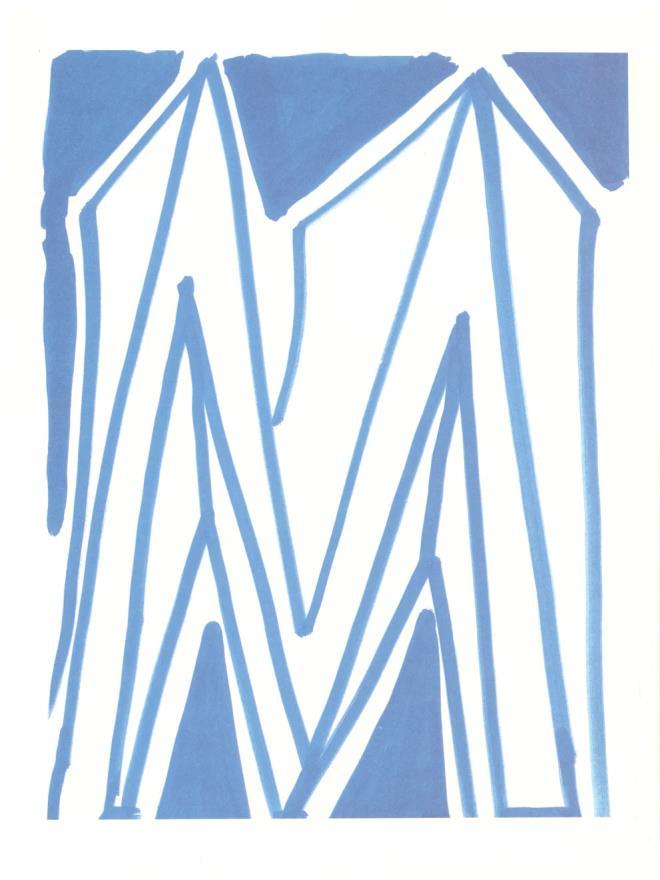
Enquire about this item
M
SOLD
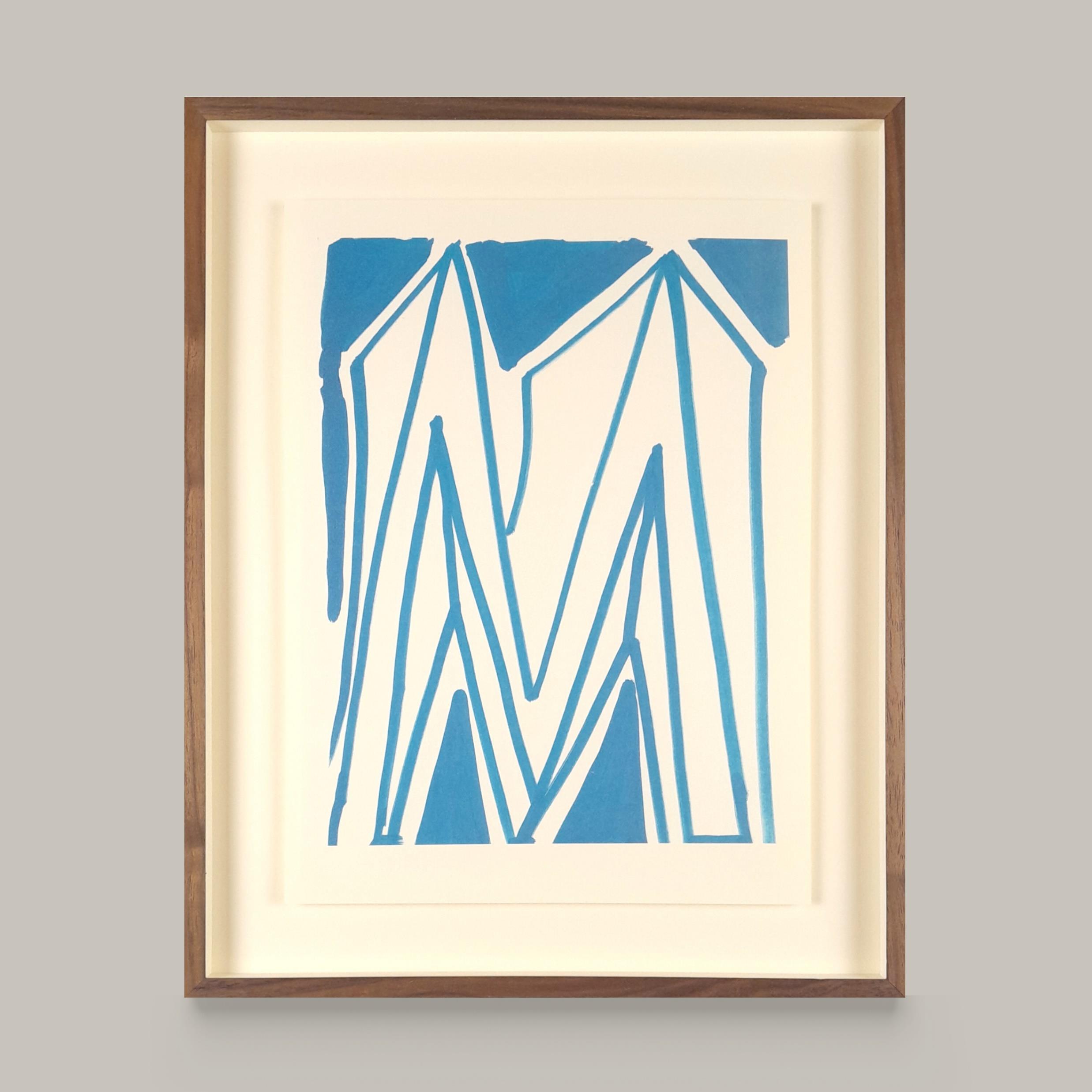
DAVID HOCKNEY
MUYBRIDGE by Craig Raine
A dirty sheet of contacts circled numbered smeared of the letter M
the squat of the letter M taking her antibiotics (flesh disintegrates)
in suppository form hands waxworks in surgical gloves
on the lavatory paper mortal remains read like a kidnap demand knees drawn up the letter M exhausted gorilla arms defeated by stairs the hollow rustle of breath a dinghy inflating but water filling her mouth flooding her body with death
the huddle of letter M
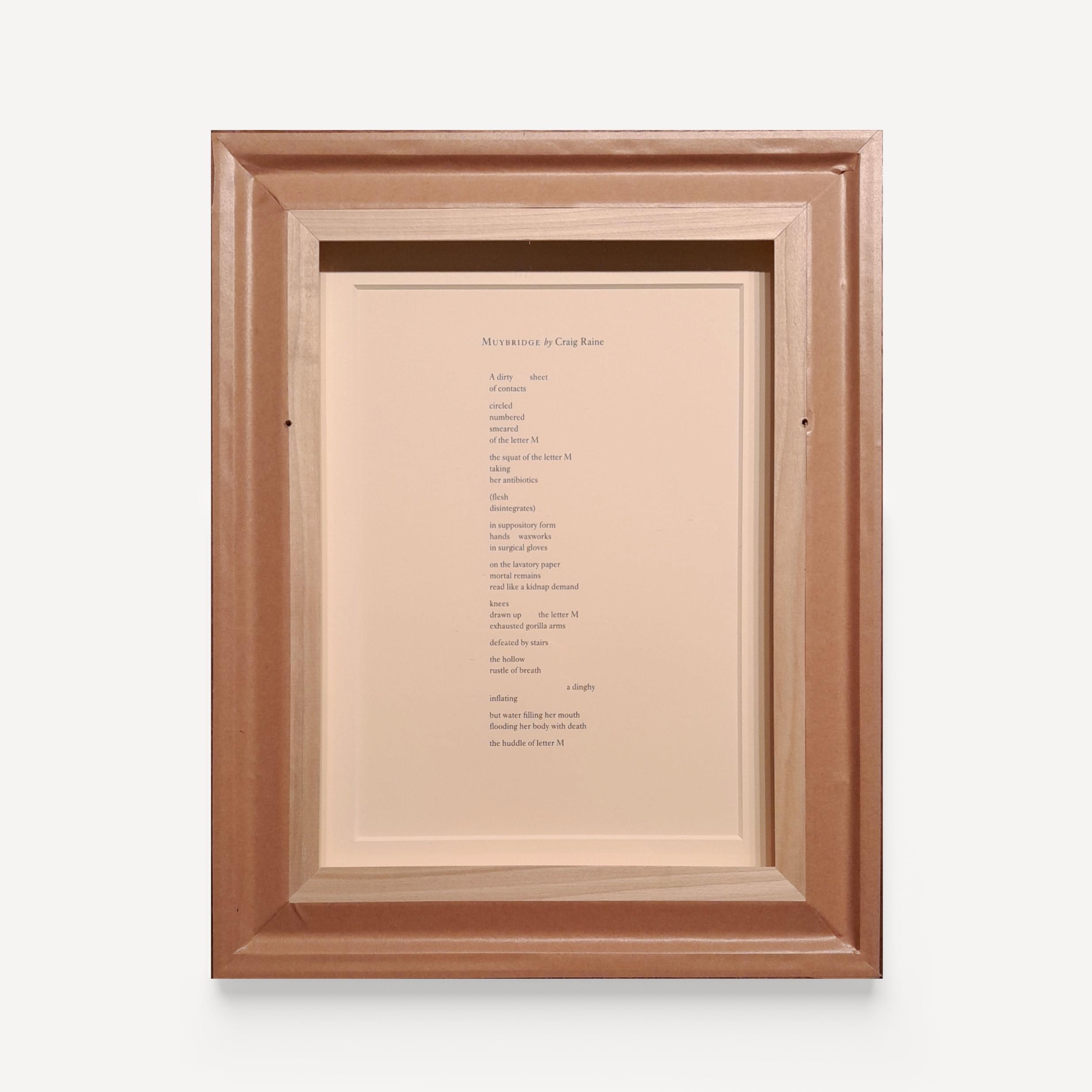
DAVID HOCKNEY
Lithograph on cartridge paper
Sheet size: 24 x 32 cms | Frame size: 28 x 36 cms
Presented in a natural walnut box frame
Accompanied by the prose N is for... by William Boyd
Price framed: £850 | Price unframed: £550 SOLD
Contact us if you are interested in the letter ‘N’, so that we give you priority notice if another becomes available.
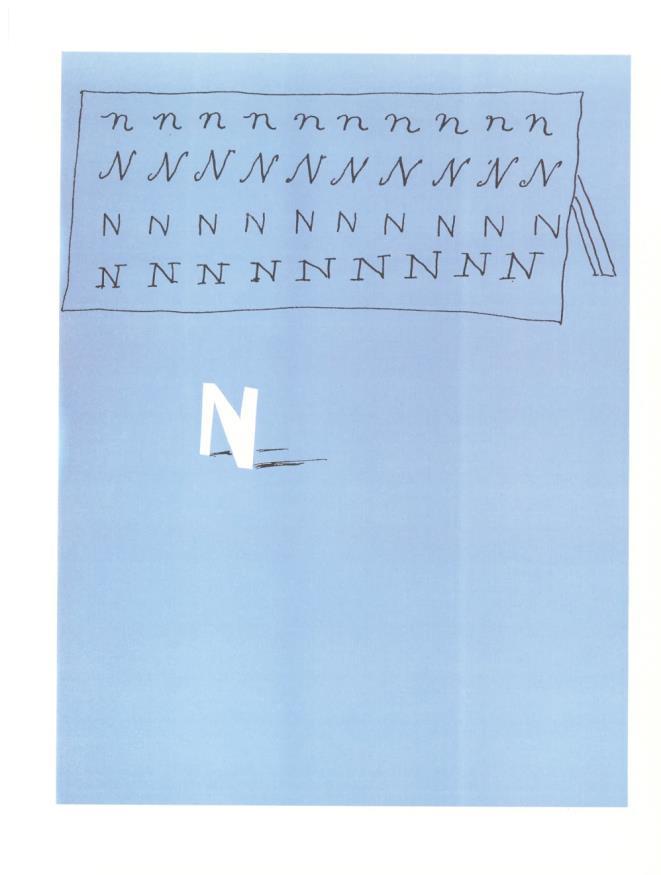
Enquire about this item
N
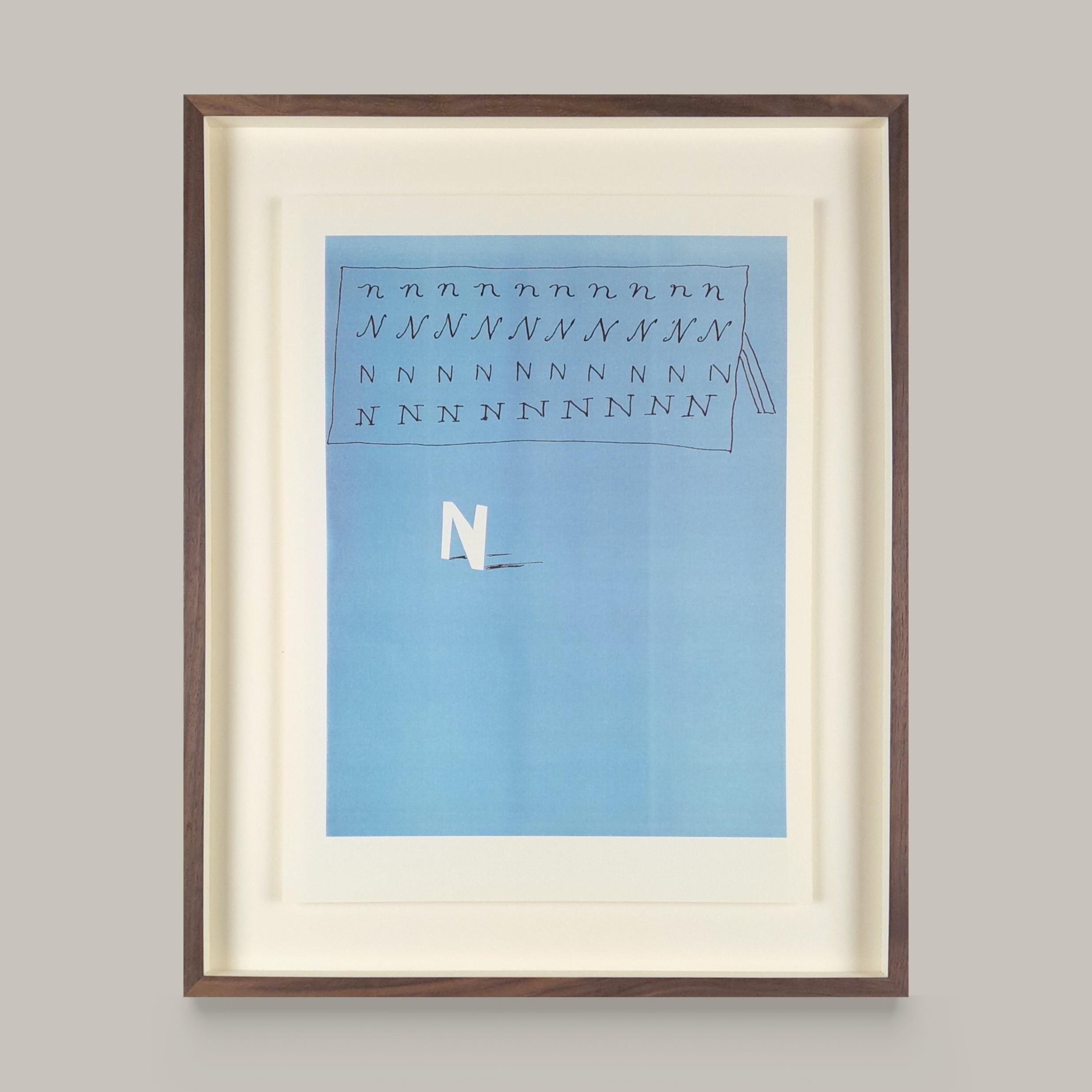
DAVID HOCKNEY
N IS FOR. . . by
William Boyd
Nguyen N, Laotian belle-lettrist and amateur philosopher. Born in Vientiane, Laos, 17 April 1885; died Paris, France, 22 February 1942. N’s family was of bourgeois stock, comparatively wealthy, francophone and Francophile. Nguyen, a precocious but somewhat unhealthy youth, yearned for Paris, but World War I delayed his arrival there until he was twenty-four.
But after humid Vientiane Paris proved noisome and frustrating. The severe winter of 1920 caused his health to fail (something cardiovascular) and he went south to recuperate, to the Côte d'Azur. Strengthened, he decided to settle there. He earned his living as a maths tutor and semi-professional table-tennis player, participating in the short-lived ping-pong leagues that briefly flourished on that sunny littoral in the 1920s.
And it was there that he wrote his little masterpiece, Les Analectes de Nguyen N (Monnier, Toulon, 1928), a copy of which I found last year in Hyères, its cerise wrapper dusty and sunbleached, its pages uncut. A sequence of epiphanic images and apophthegms, its tone is fragile and nervy, balancing perilously between the profound and the banal. ‘Somewhere snow is gently falling,’ Nguyen writes amidst the mimosa and umbrella pines, ‘and I still feel pain.’ English cannot do their tender sincerity full justice.
After the book’s success Nguyen N was taken up by the cultural salons of Paris, where he returned permanently in 1931. He is a tenant of the footnotes of literary history; the unidentified face as the café table; a shadowy figure on the perimeter of many a memoir and biography.
He wrote once to André Gide, who had taxed him on his unusual surname, which is not common in Laos. ‘ … It is properly pronounced unnnnhhhh, effectively three syllables, the final ‘hs’ being as plosive as possible, if you can imagine that. Ideally, after introducing me, you should be very slightly out of breath.’
The war brought penury. Nguyen went to work in the kitchen of Paris’s largest Vietnamese restaurant, where he discovered a talent for the decorative garnish. His lacy carrot carnations, scallion lilies and translucent turnip roses were miniature works of art. In between shifts he wrote his short autobiography, Comment Ciseler Les Legumes (Plon et Noël, Paris, 1943 – very rare), which was published posthumously.
Nguyen N was run over in the blackout one gloomy February night by a gendarme on a bicycle. He died instantly.
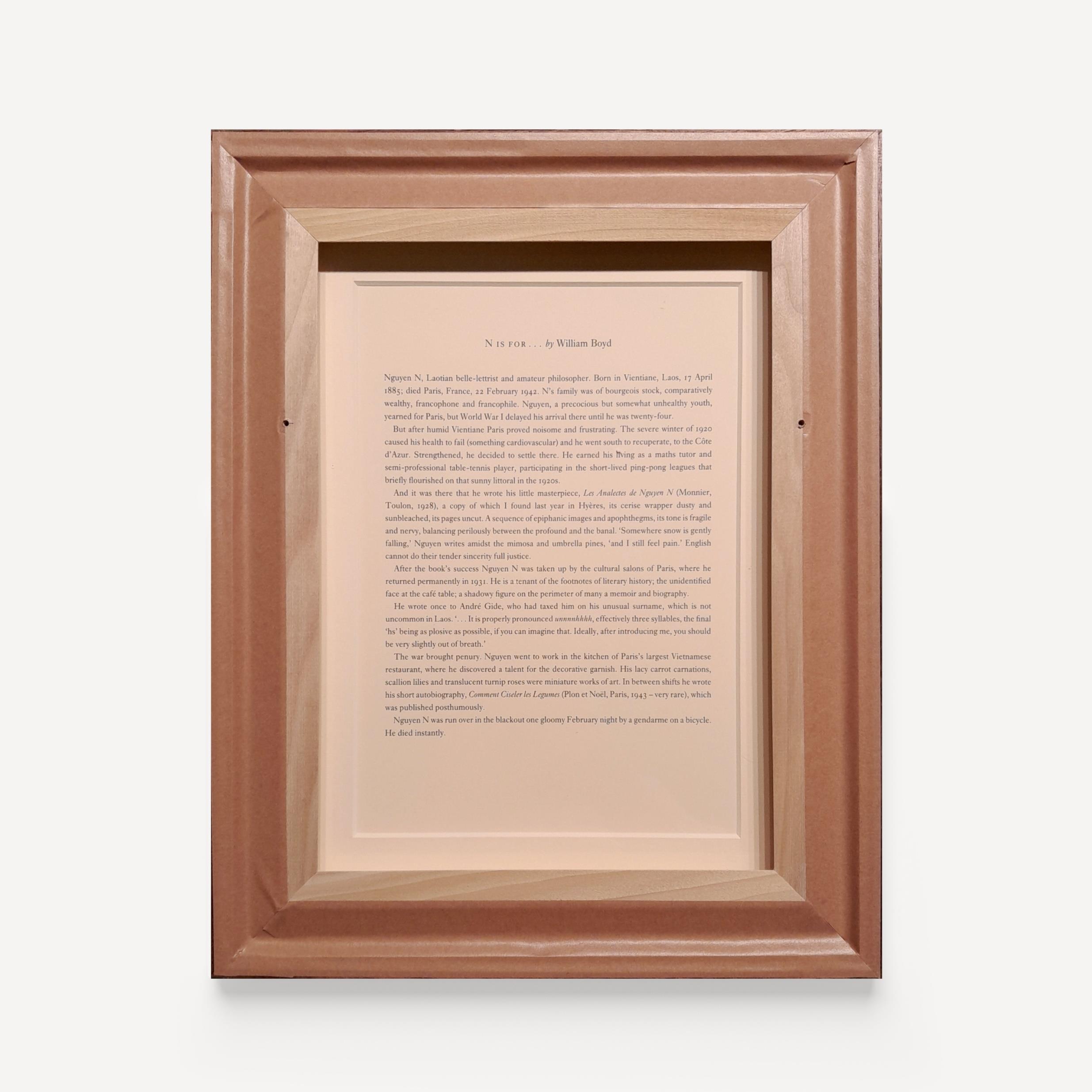
DAVID HOCKNEY
Lithograph on cartridge paper
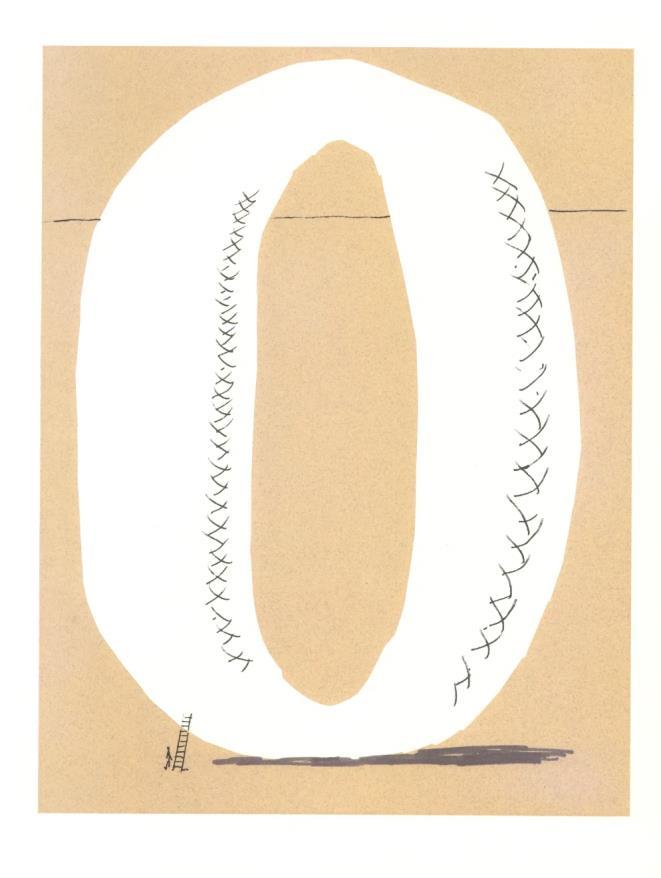
Sheet size: 24 x 32 cms | Frame size: 28 x 36 cms
Presented in a natural walnut box frame
Accompanied by the prose O by V. S. Pritchett
Price framed: £850 | Price unframed: £550
Contact us if you are interested in the letter ‘O’, so that we give you priority notice if another becomes available.
Enquire about this item
O
SOLD
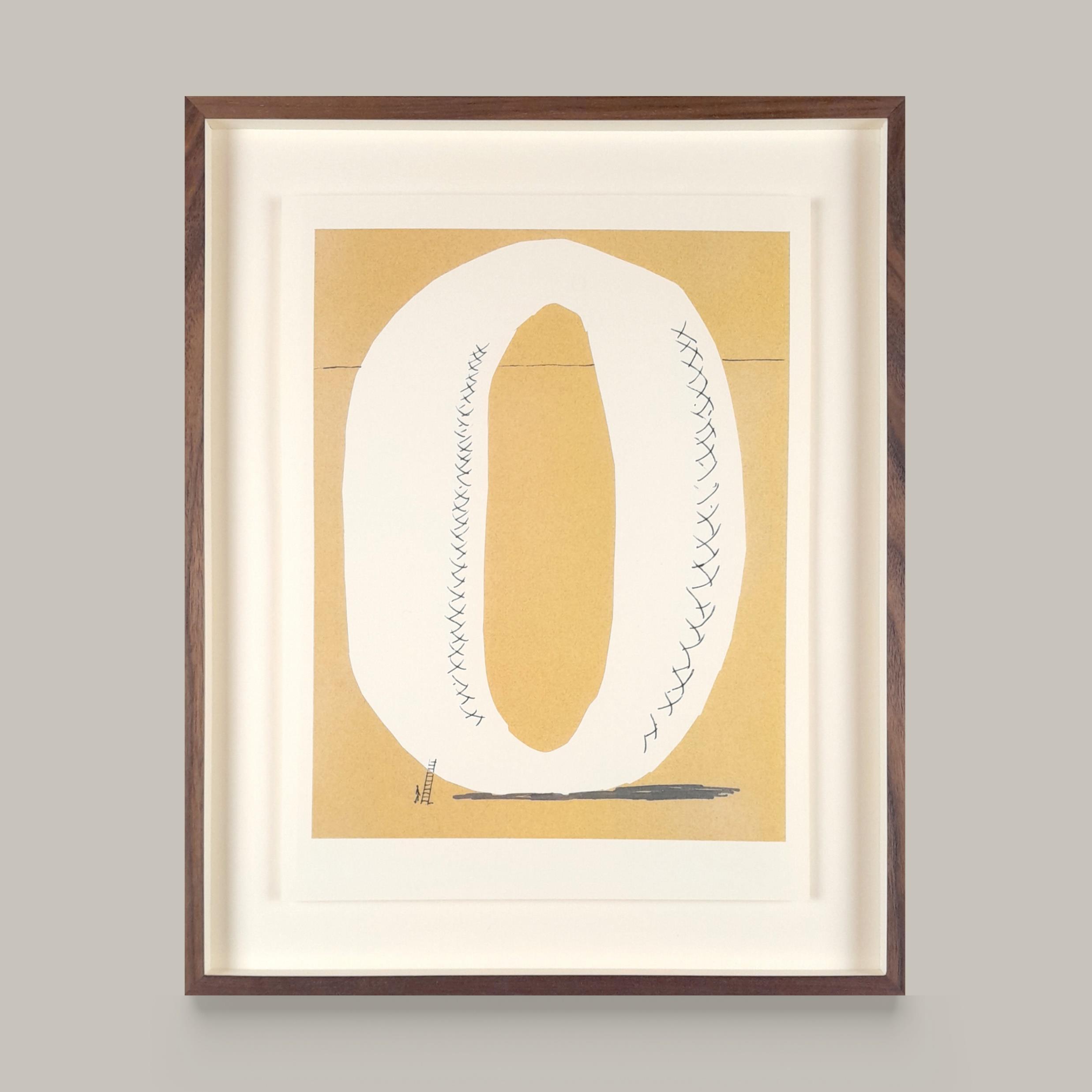
DAVID HOCKNEY
O by V.S. Pritchett
O is for Oblomov, one of the most sublime comic characters in the Russian novel of the nineteenth century and a splendid example of the character who outgrows and even contradicts the author’s intention. His creator, Goncharov, was the son of one of the new, shrewd, hardworking merchant class, angered by the idleness of the ruling landowners. He set out to write a social tract, but by some freak of the unconscious the story became a hymn to sleep and idleness, to a man who cannot even get up in the morning. ‘Other people’, his servant shouts at him, ‘get up and go to work.’ Oblomov’s answer is sublime. ‘How dare you compare me to Other People.’ He prefers to dream and indeed his wife and children adore him for his indolence and his gift for going downhill. The story intended to be a tract turns into a delightful comedy in which people and animals doze through the days. The curious fact is that Goncharov himself was a cantankerous man, unlike the sainted Oblomov, and was intensely jealous and litigious.
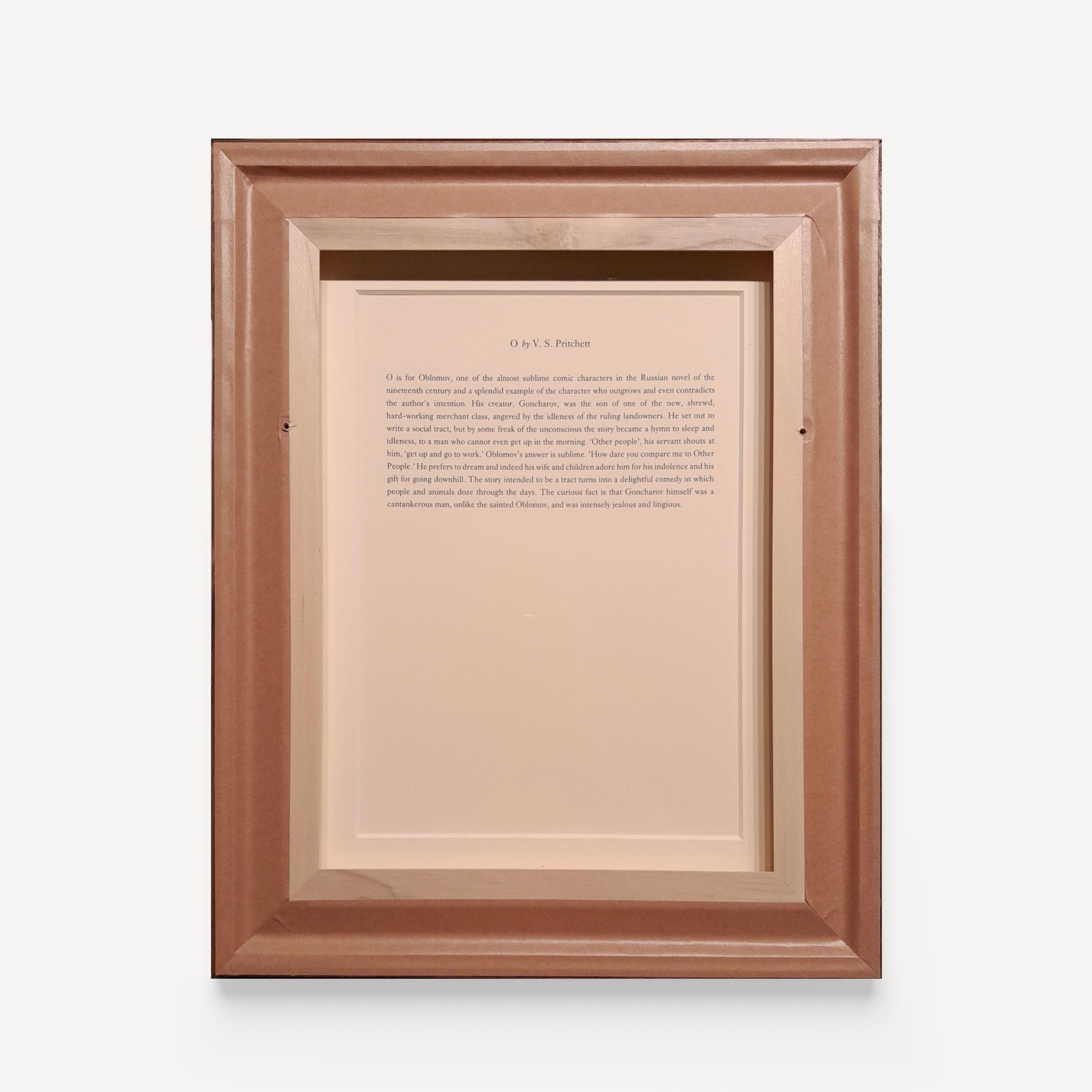
DAVID HOCKNEY
Lithograph on cartridge paper
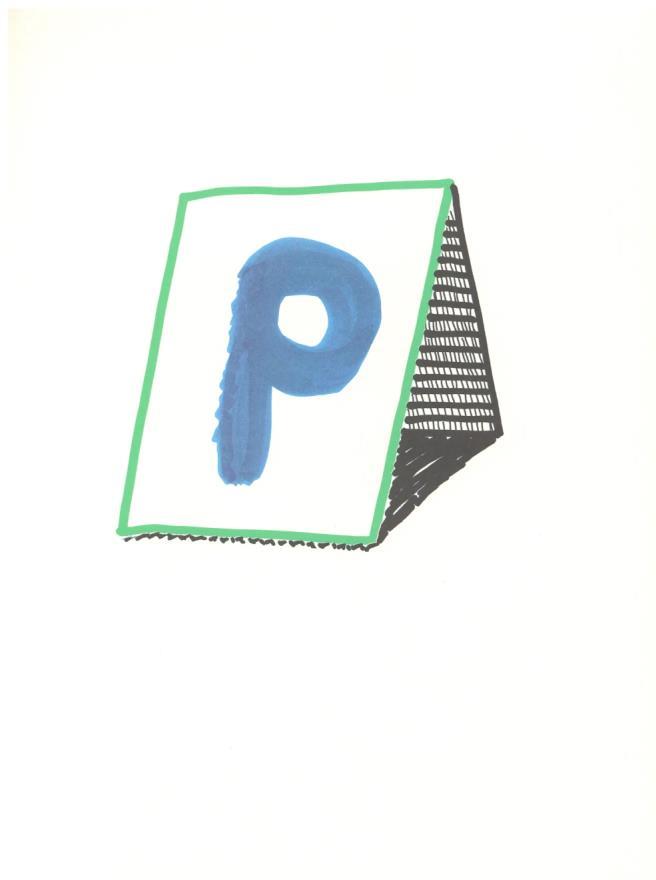
Sheet size: 24 x 32 cms | Frame size: 28 x 36 cms
Presented in a natural walnut box frame
Accompanied by the prose P by Doris Lessing
Price framed: £850 | Price unframed: £550
RESERVED
Enquire about this item
P

DAVID HOCKNEY
P by Doris Lessing
P is for pumpkin, because I making pumpkin soup, one of the joys of autumn. You need a good pumpkin that has had real sun, for the taste. You can’t use English pumpkins if we have had a bad summer, most years they are all right. You make a purée of it. Then you sweat chopped onions in a little butter. You can use a good chicken stock, but some people think a stock deadens the subtle and earthy pumpkin taste, and prefer water. A little cinnamon, just enough ginger to tang it, and then, when you serve it, a dollop of sour cream on top, sprinkled with finely chopped parsley.
P is for roast pumpkin because it is a wonderful accompaniment to roast meats, or as the basis of a vegetarian meal, since it is rich and filling. It should be cut in generous slices, and each slice well scored and sprinkled with butter, salt, a little sugar, cinnamon, a dusting of coriander and cardamom. This is put into a medium oven till the surfaces begin to caramelize.
P is for pumpkin the way the French do it, very finely diced and then seasoned with parsley and finely chopped garlic – quite a lot of garlic – then dredged with flour until each little cube is coated. This is spread in a gratin earthenware dish that has been well wiped with olive oil, and the dish goes into a quiet oven, above 350°F for 2½ hours. It should then have a dark brown crust, but underneath the pumpkin is making a rich purée.
P is for pumpkin fritters – but we all know how to make fritters. They are delicious, tangy and seductive. And, of course, very fattening.
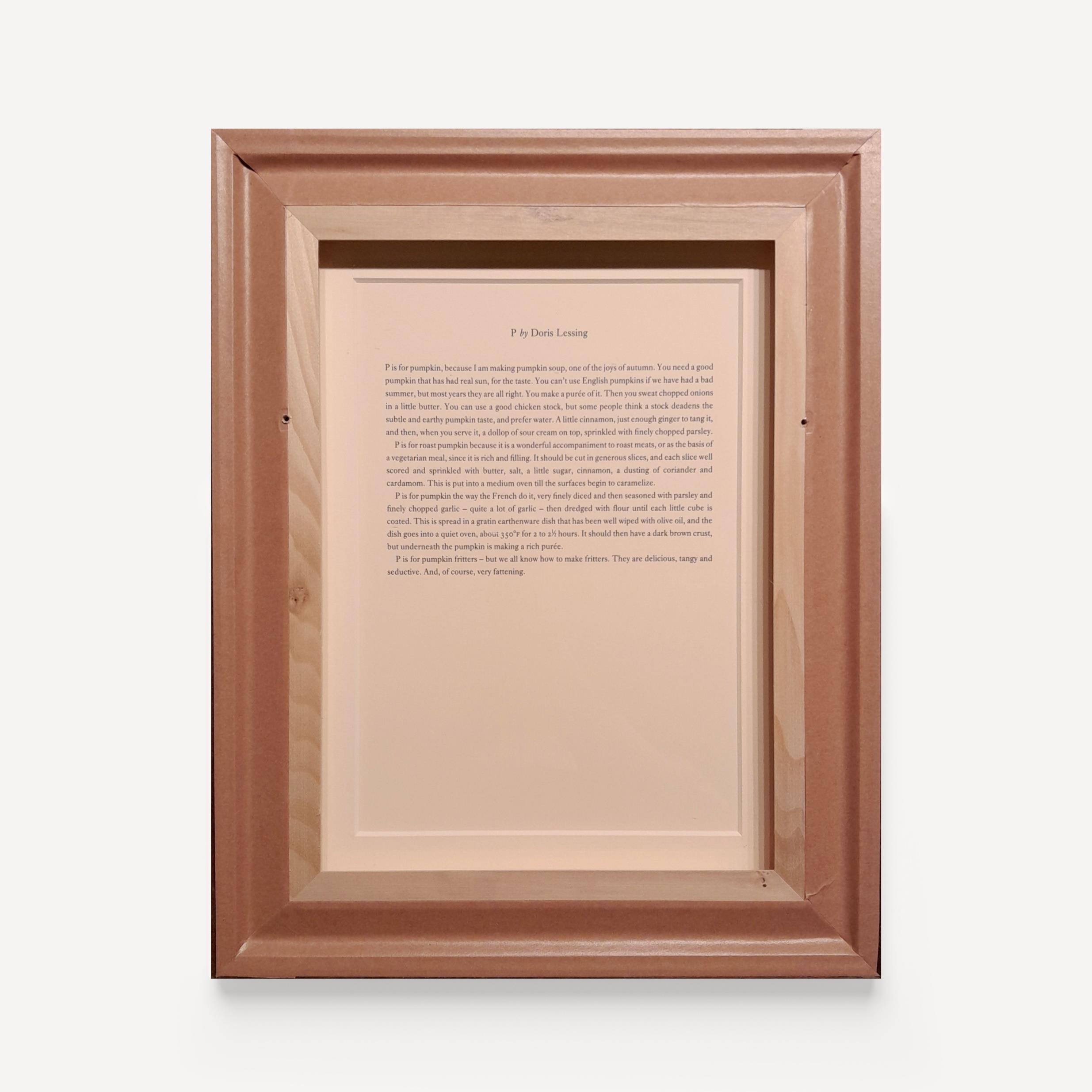
DAVID HOCKNEY
Lithograph on cartridge paper
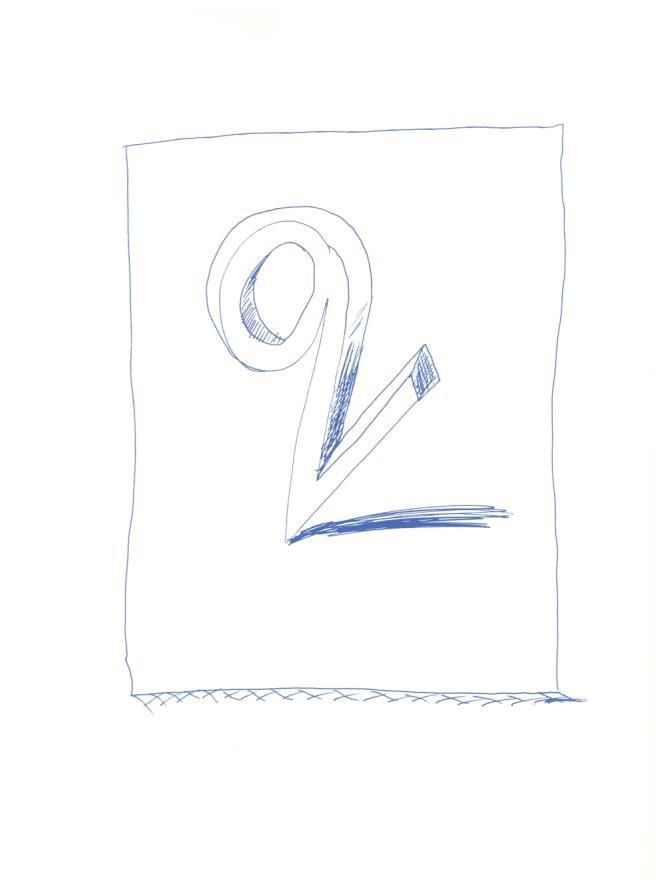
Sheet size: 24 x 32 cms | Frame size: 28 x 36 cms
Presented in a natural walnut box frame
Accompanied by the prose Q by William Golding
Price framed: £850 | Price unframed: £550
Enquire about this item
q
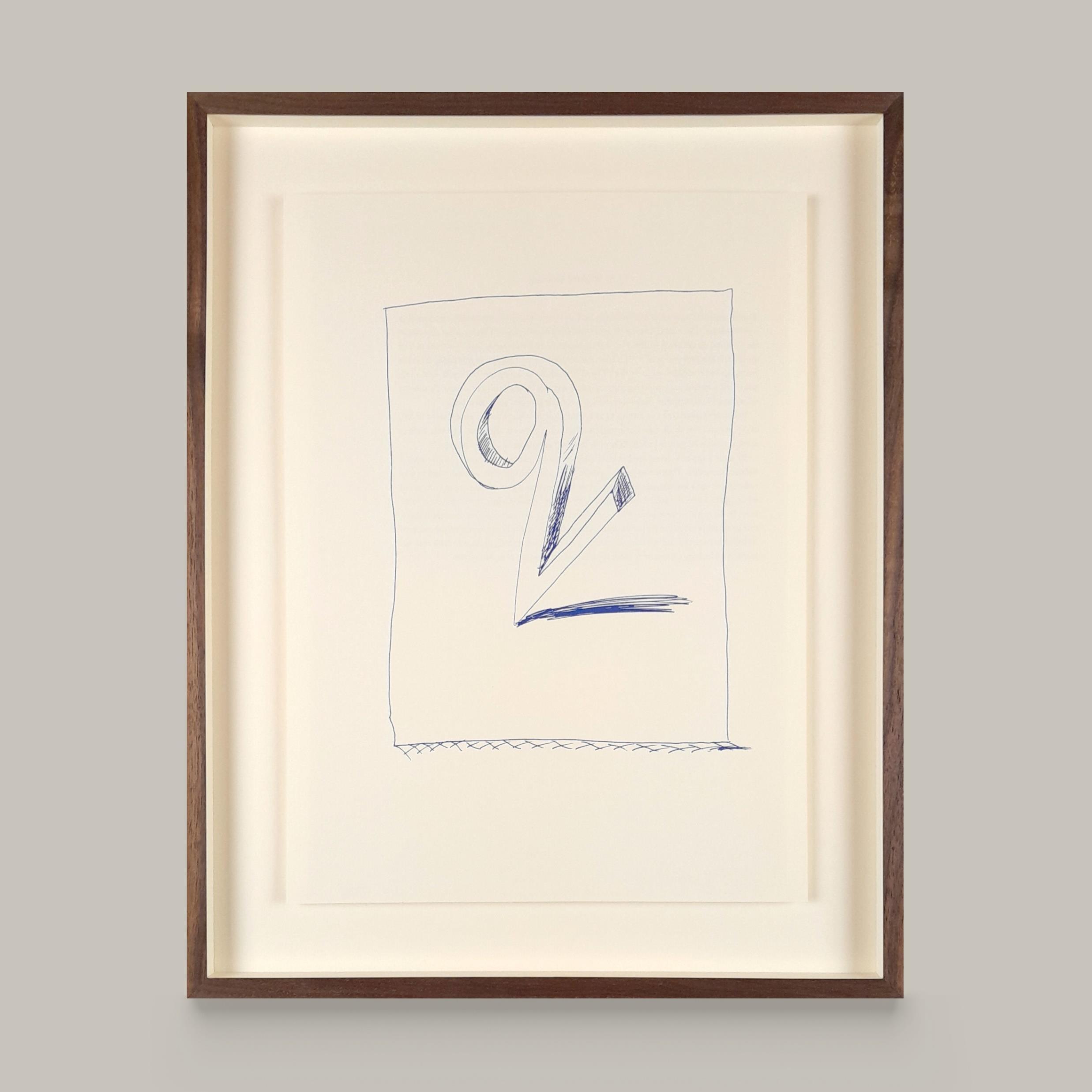
T.S. Eliot: A LETTER TO MISS ALICE QUINN (AGED 16)
19 February 1952
Dear Miss Alice Quinn,
I do not often answer letters, because I am too busy; but I liked your letter, and I am glad that you are at a Catholic school.
I cannot tell you how to concentrate, because that is something I have been trying to learn all my life. There are spiritual exercises in concentration, but I am not the person to teach what I am trying to learn. All I know is that if you are interested enough, and care enough, then you concentrate. But nobody can tell you how to start writing. The only good reason for writing is that one has to write. You ask seven questions. No one event in one’s childhood starts one writing: no doubt a number of ‘events’ and other causes. that remains mysterious. My advice to ‘up and coming writers’ is, don’t write at first for anyone but yourself. It doesn’t matter how many or how few universities one goes to, what matters I what one learns, either at universities or by oneself. My favourite essay, I think, is my essay on Dante, not because I think I know much about Dante, but because I loved what I wrote about. The Waste Land is my most famous work, and therefore perhaps will prove the most important, but it is not my favourite. I am interested to hear that Kunitz and Haycraft say that I prefer to associate with Nobility and Church Dignitaries, but I like to know every sort of person, including Nobility and Dignitaries. I also like to know Policemen, Plumbers, and People. One does not always need to know a subject very well in order to teach it: what one does need to know is How to Teach Anything. I went to a very good school (which no longer exists) in St Louis, Missouri, where I was well taught in Latin, Greek, French, and elementary Mathematics. Those are the chief subjects worth learning at school; and I am glad that I was well taught in these subjects, instead of having to study such subjects as T.S. Eliot. At the University I studied too many subjects, and mastered none. If you study Latin, Greek, French, Mathematics, and the essentials of the Christian Faith, that is the right beginning.
I like living in London, because it is my City, and I am happier there than anywhere else. With best wishes,
T.S.
Eliot
DAVID HOCKNEY
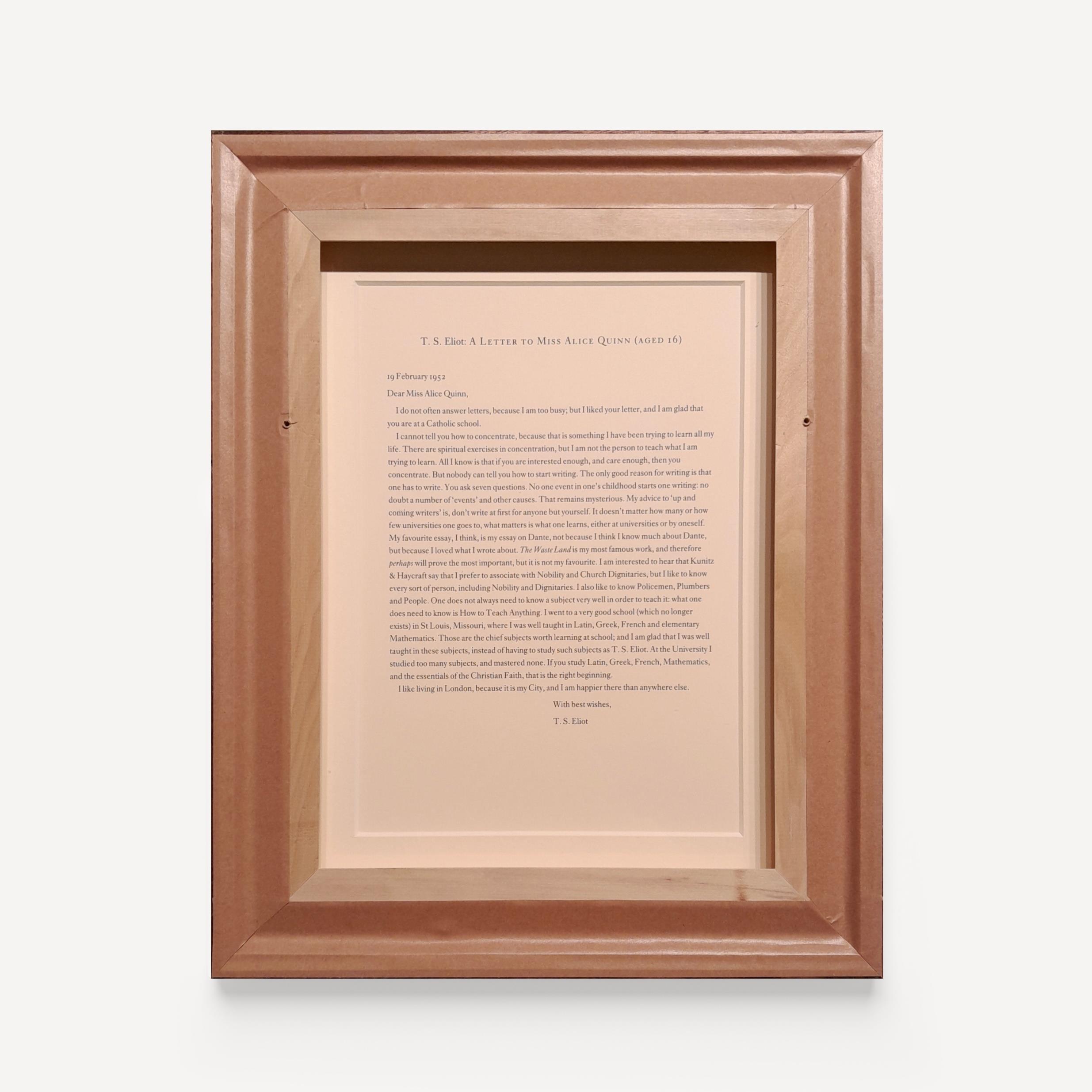
DAVID HOCKNEY
Lithograph on cartridge paper
Sheet size: 24 x 32 cms | Frame size: 28 x 36 cms
Presented in a natural walnut box frame
Accompanied by A Letter to Miss Alice Quinn (Aged 16) by T.S. Eliot
Price framed: £850 | Price unframed: £550
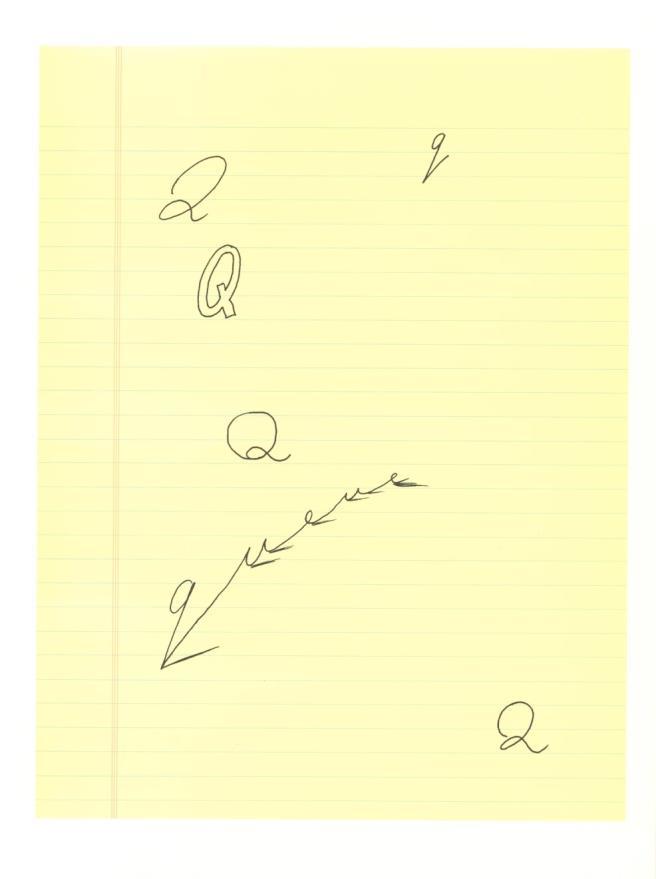
Enquire about this item
Q
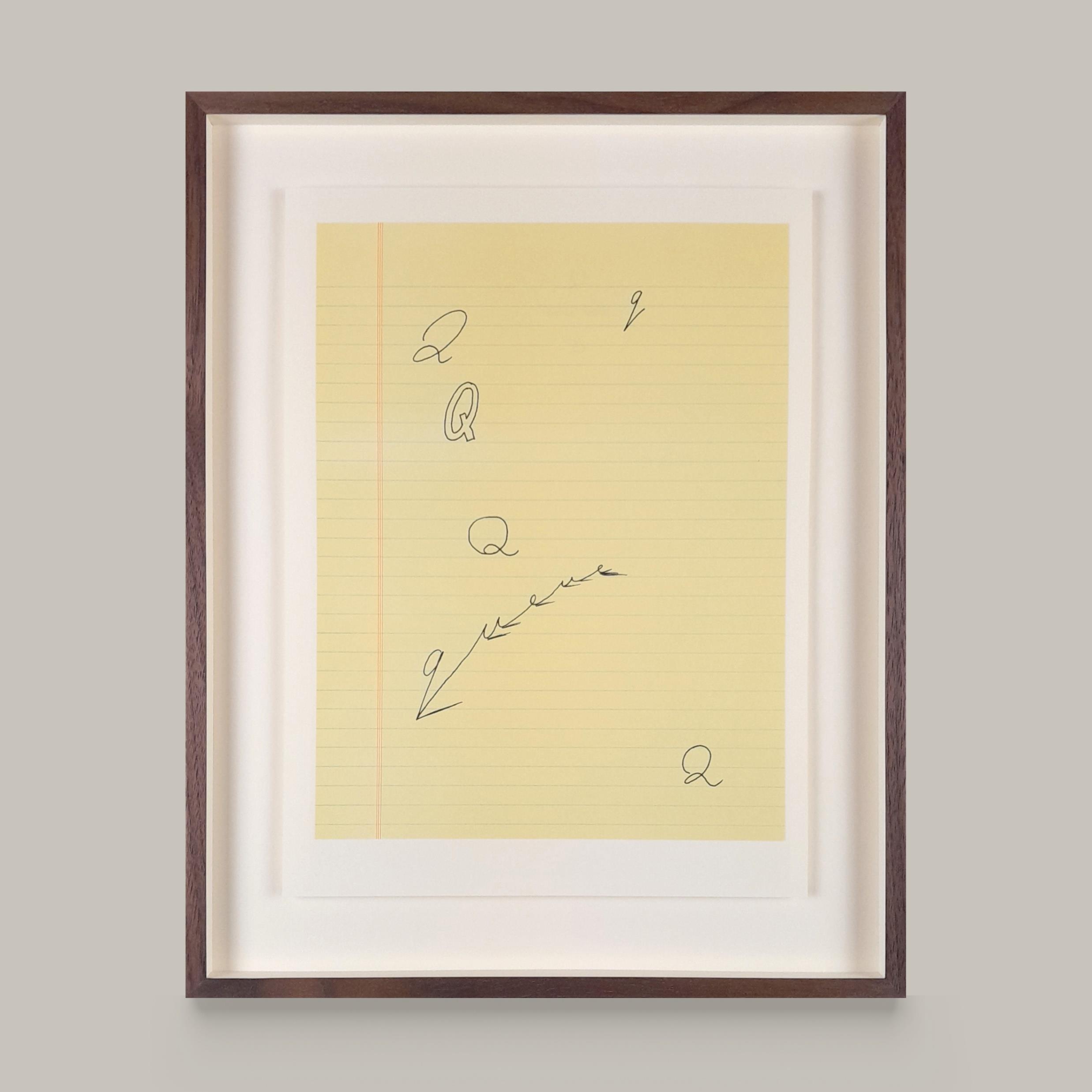
DAVID HOCKNEY
Q by William Golding
The top capital Q looks to its left, turning its back on the small q which is more like a weapon than a decent letter. The next Q down is obviously paddling its own canoe. This is a great pleasure to the Qin-the-street which suffers from having always to push a U (rarely ‘an U’) in front of it all the time. It can only get ride of ‘U’ if it takes the desperate step of going into translation from the Arabic and who would want to do that? The Q beneath the paddling one is a sessile kind of Q, rather self-satisfied and wondering whether it is an apple or the hindquarters of a cat. Few things are more self-satisfied than the hindquarters of a cat. It triumphed as I shall explain.
The next Q down is not so much a Q as a Quarrel (a short heavy, square-headed arrow or bolt, OUP 2nd ed.), the shock waves of supersonic flight clearly shown. After that we come back to another version of our left-looking Q but this time bolt upright and a classical Marxist.
All these I can now reveal are but sorry attempts on the part of the young Q to give itself a defined personality. They are its prentice pieces. The young Q had literary ambitions and its true masterpiece was a masquerade (which it kept up for more than eighty years) as a Cornish man of letters, going under the unlikely pseudonym of Sir Arthur Quiller-Couch, in which guise it wrote many books and gave some pleasure to many. Indeed, it acquired such a degree of celebrity that it was at last able to abandon the pseudonym and even the intolerable U and appear on the covers of its books in its naked and self-satisfied purity. This one, the fourth Q, the sessile apple/cat was surely Mr Hockney’s favourite to judge from the tender elegance of its delineation.
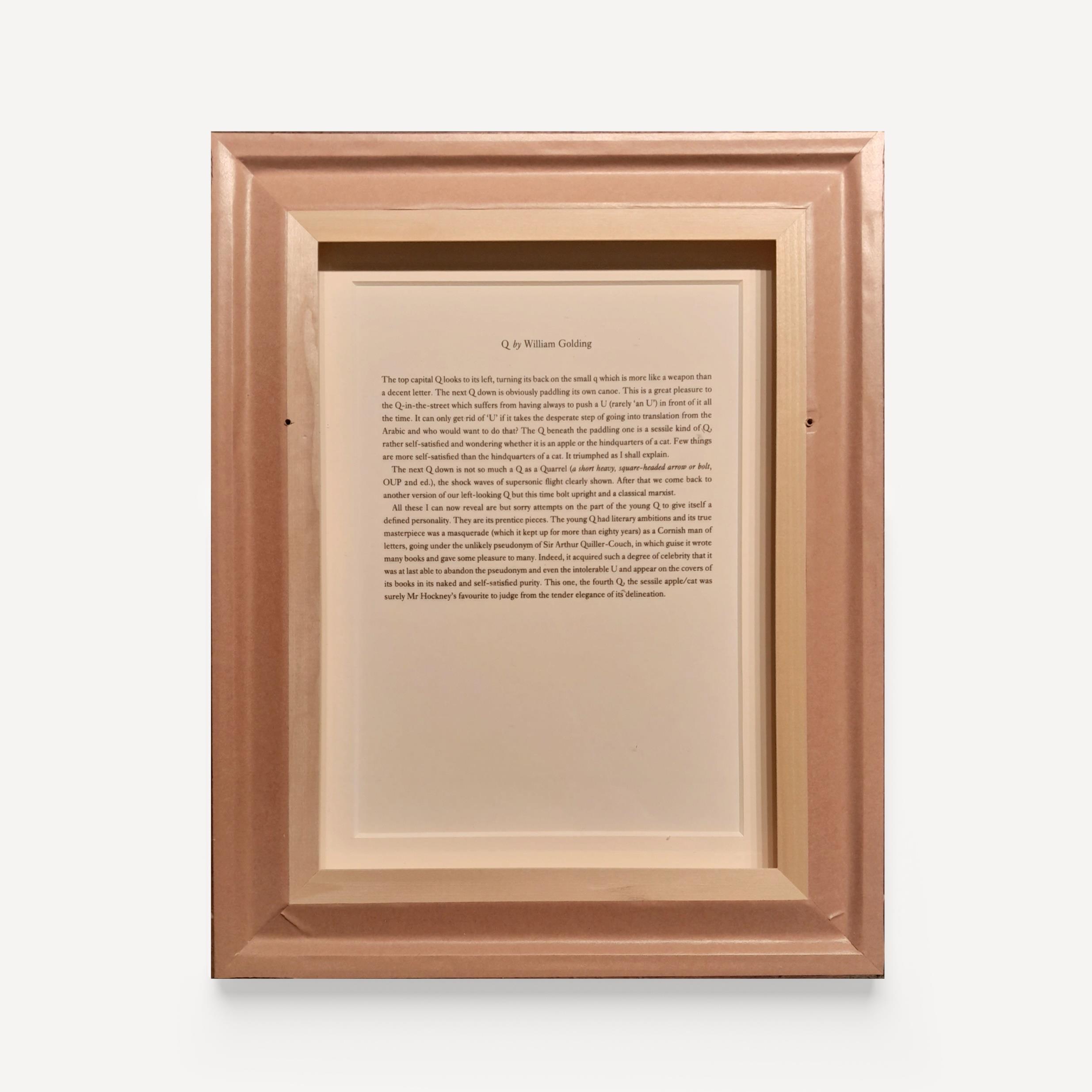
DAVID HOCKNEY
Lithograph on cartridge paper
Sheet size: 24 x 32 cms | Frame size: 28 x 36 cms
Presented in a natural walnut box frame
Accompanied by the prose 'R' by Arthur Miller
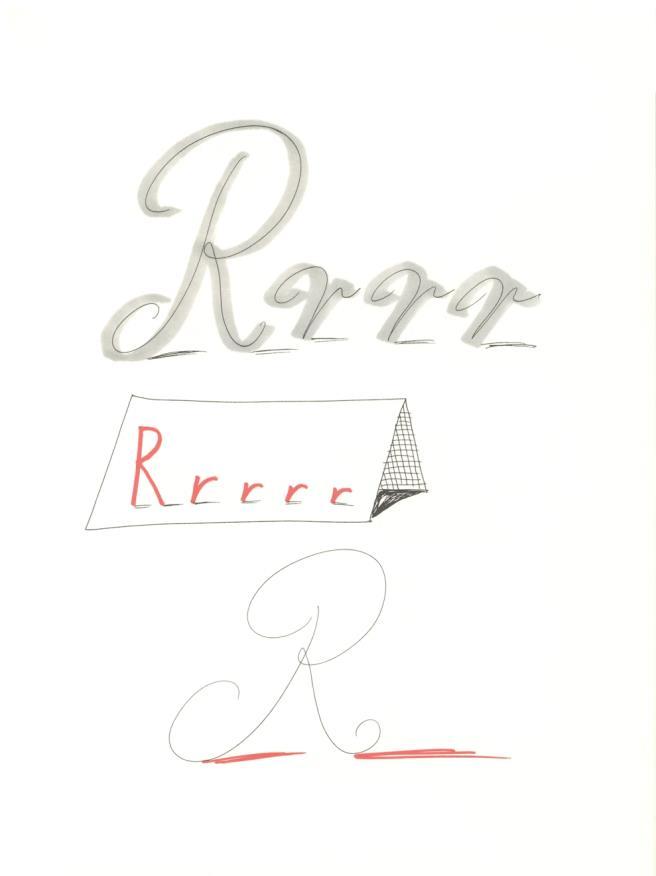
Price framed: £850 | Price unframed: £550
Contact us if you are interested in the letter ‘R’, so that we give you priority notice if another becomes available.
Enquire about this item
R
SOLD
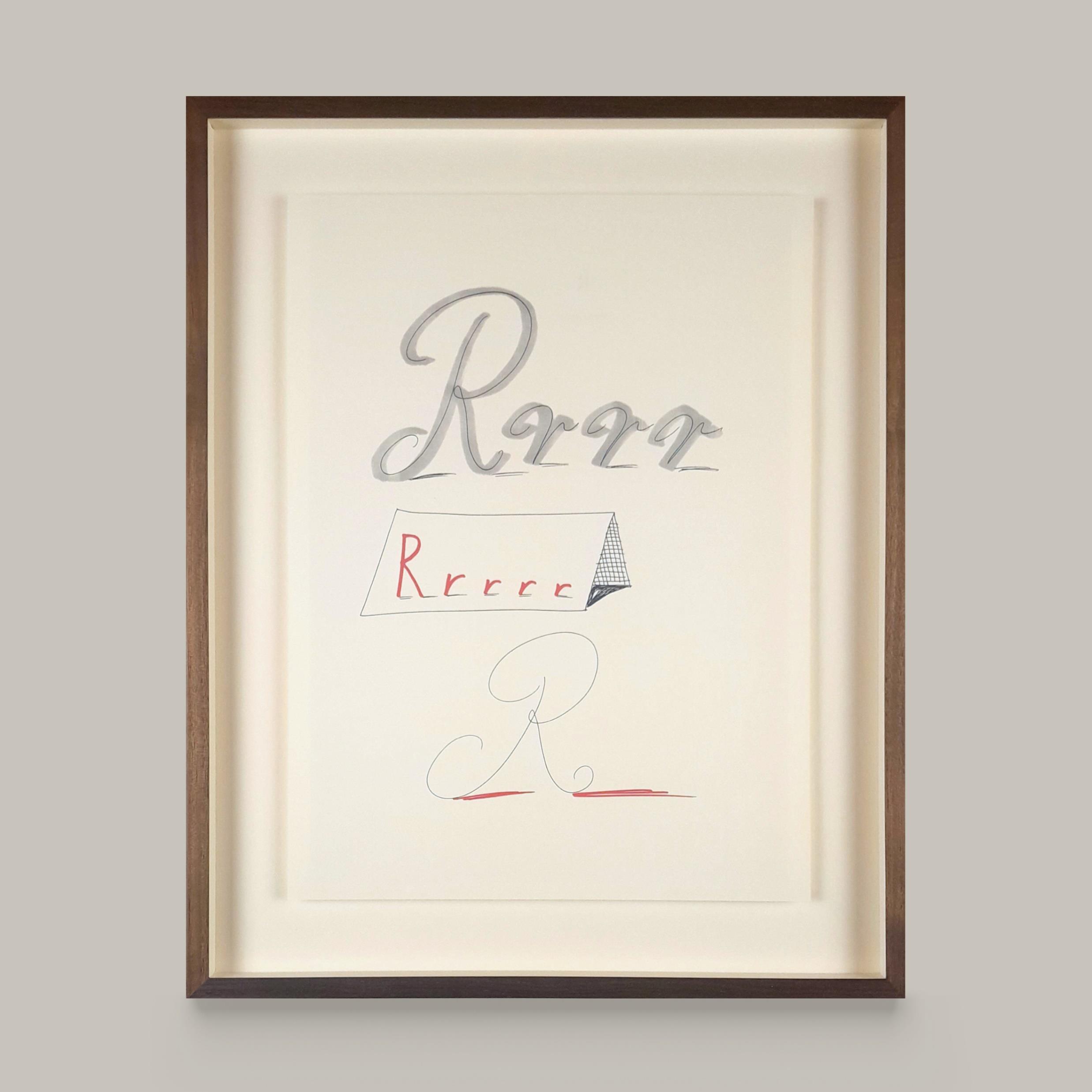
DAVID HOCKNEY
R by Arthur Miller
Remarkably, the disease called AIDS is so unwelcome as to move many people to deny its existence, especially in their own bloodstreams. Otherwise intelligent and perceptive folk are still refusing to credit the statistics which show that AIDS is no longer confined to Haitians, homosexuals, drug users through infected needles, and other no-account people.
Of course this denial process is not at all new. I can recall as a young boy how ashamed people were to have to admit that a member of the family had tuberculosis. I suppose this was due to the common idea that the disease came from poverty, with which decent people were in no hurry to be associated if they could help it.
Clearly, AIDS must be contained somehow, and it won’t be, obviously, until everyone feels that he or she is not immune because of social station, culture, or any other seeming barrier to infection. But human denial is probably the toughest barrier to any progress and the way will doubtless be hard.

DAVID HOCKNEY
Lithograph on cartridge paper
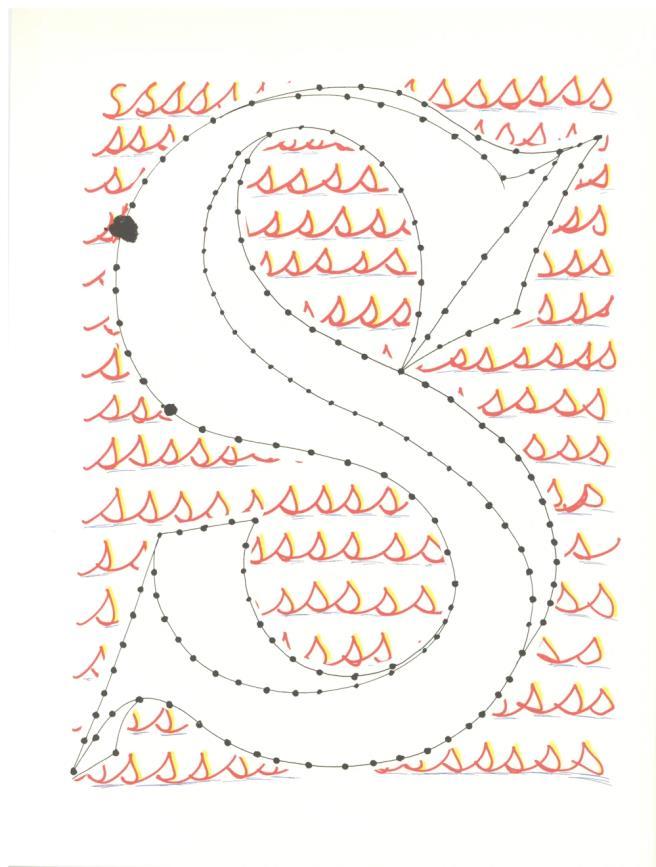
Sheet size: 24 x 32 cms | Frame size: 28 x 36 cms
Presented in a natural walnut box frame
Accompanied by the poem 'S' by Ted Hughes
Price framed: £850 | Price unframed: £550 SOLD
Contact us if you are interested in the letter ‘S’, so that we give you priority notice if another becomes available.
Enquire about this item
S
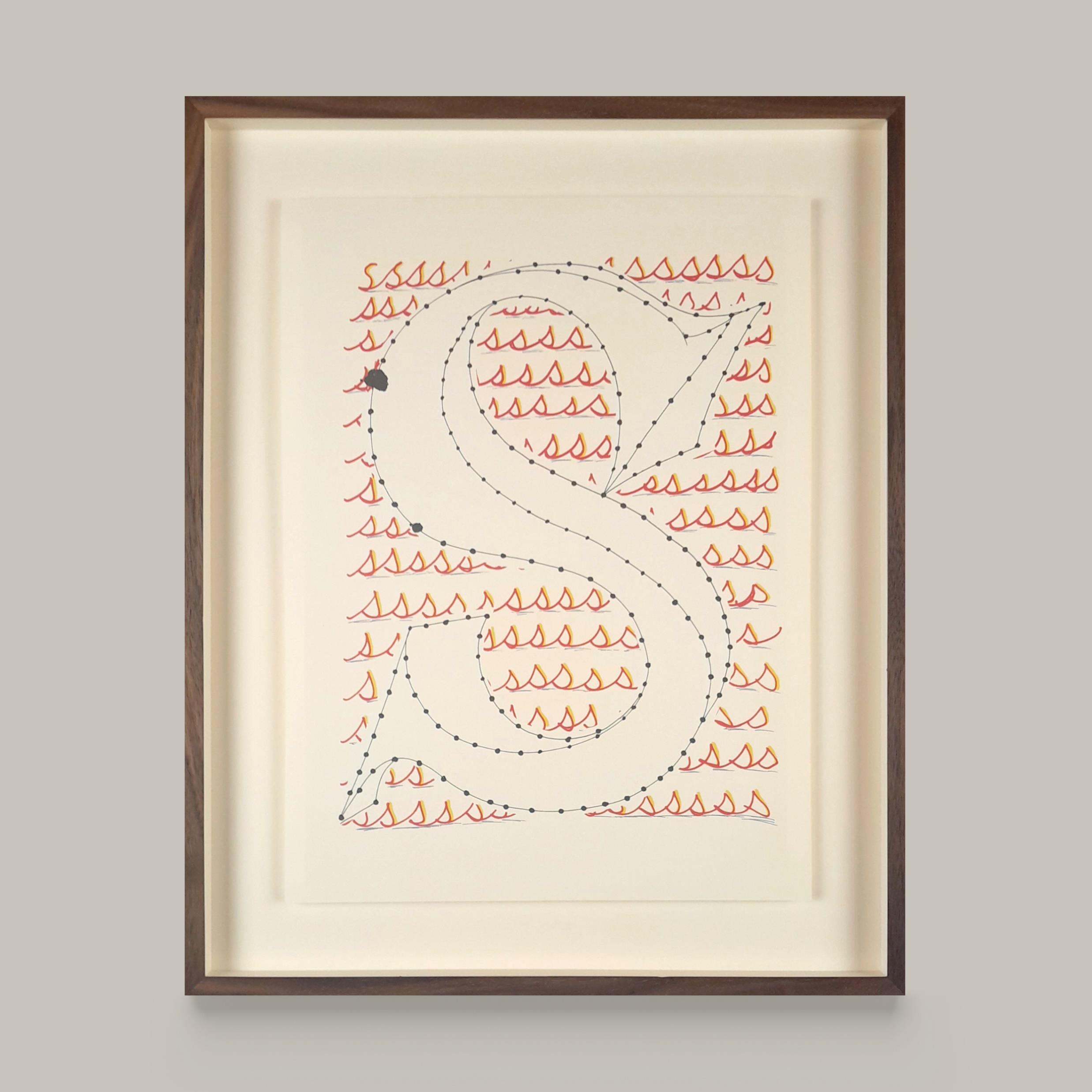
DAVID HOCKNEY
S by Ted Hughes
Started an eel
Of strangest flesh.
Nor snake nor fish
So sheer to feel, So live, so lithe
As when she slid
Out of her hole
In purest soul
On a spiral. Corkscrewed into a shock of nostril, the sneeze of glair. Squirmed flex and reflex into saliva. The slug of speech, she lubricates the shapes of air. L’onde s’enfle dessous. Sashays across the surges of perspective. Swan of vision, she shakes light bare. Singular sex of plural and the supplest of strange tails. Thirst for her ghost keenest, the ice’s wound. Sound-waves abandoned the Lusitania. Depth-charged, a sea-worm, struggling, surfaced, stares and there
In a lens of ocean where happiness doubles
Opening the purse
Of lips for a kiss
With a human sigh
The wordless eye
Of end and beginning
Rears its hiss.
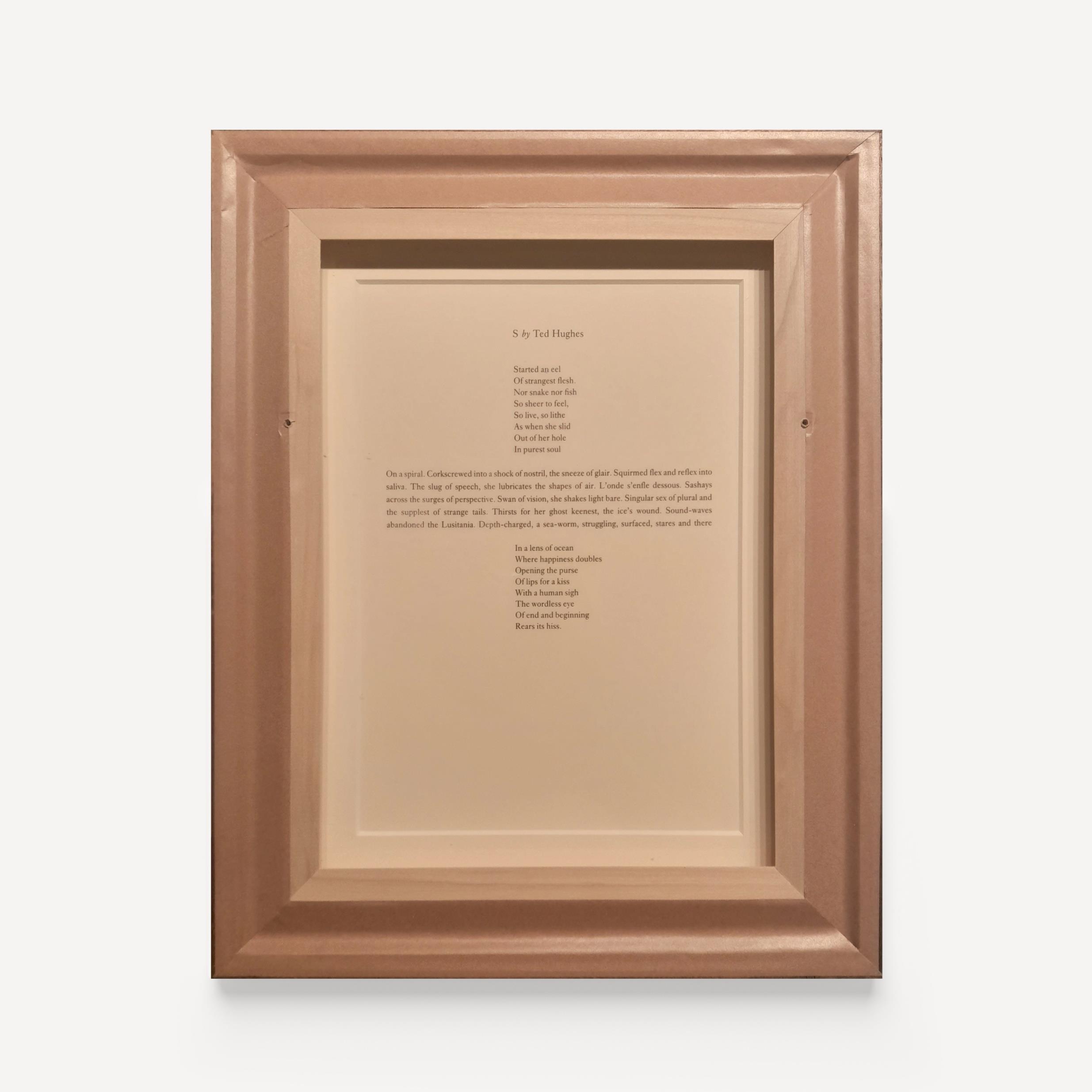
DAVID HOCKNEY
Lithograph on cartridge paper
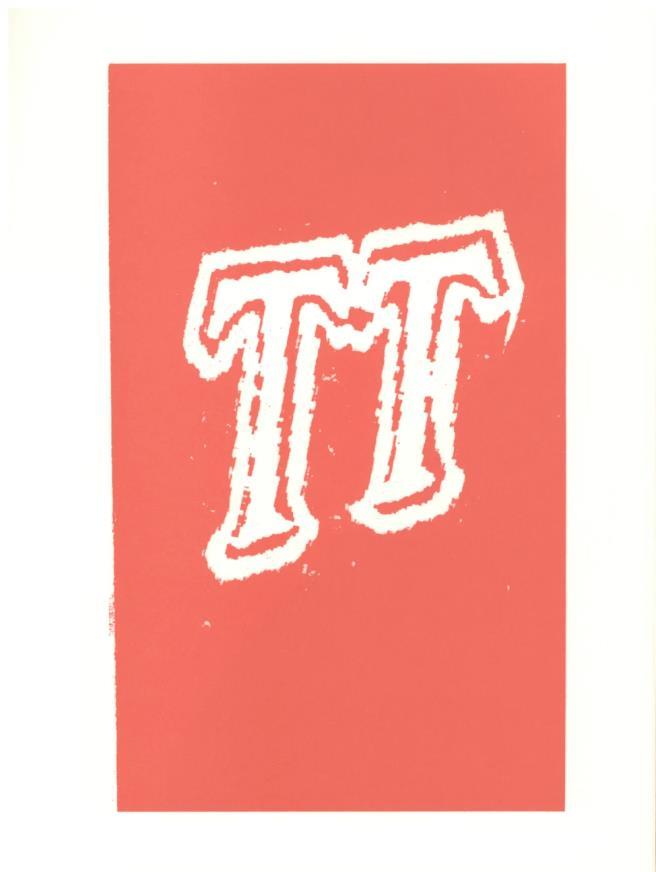
Sheet size: 24 x 32 cms | Frame size: 28 x 36 cms
Presented in a natural walnut box frame
Accompanied by the prose 'T' by Kazuo Ishiguro
Price framed: £850 | Price unframed: £550
Contact us if you are interested in the letter ‘T’, so that we give you priority notice if another becomes available.
Enquire about this item
T
SOLD
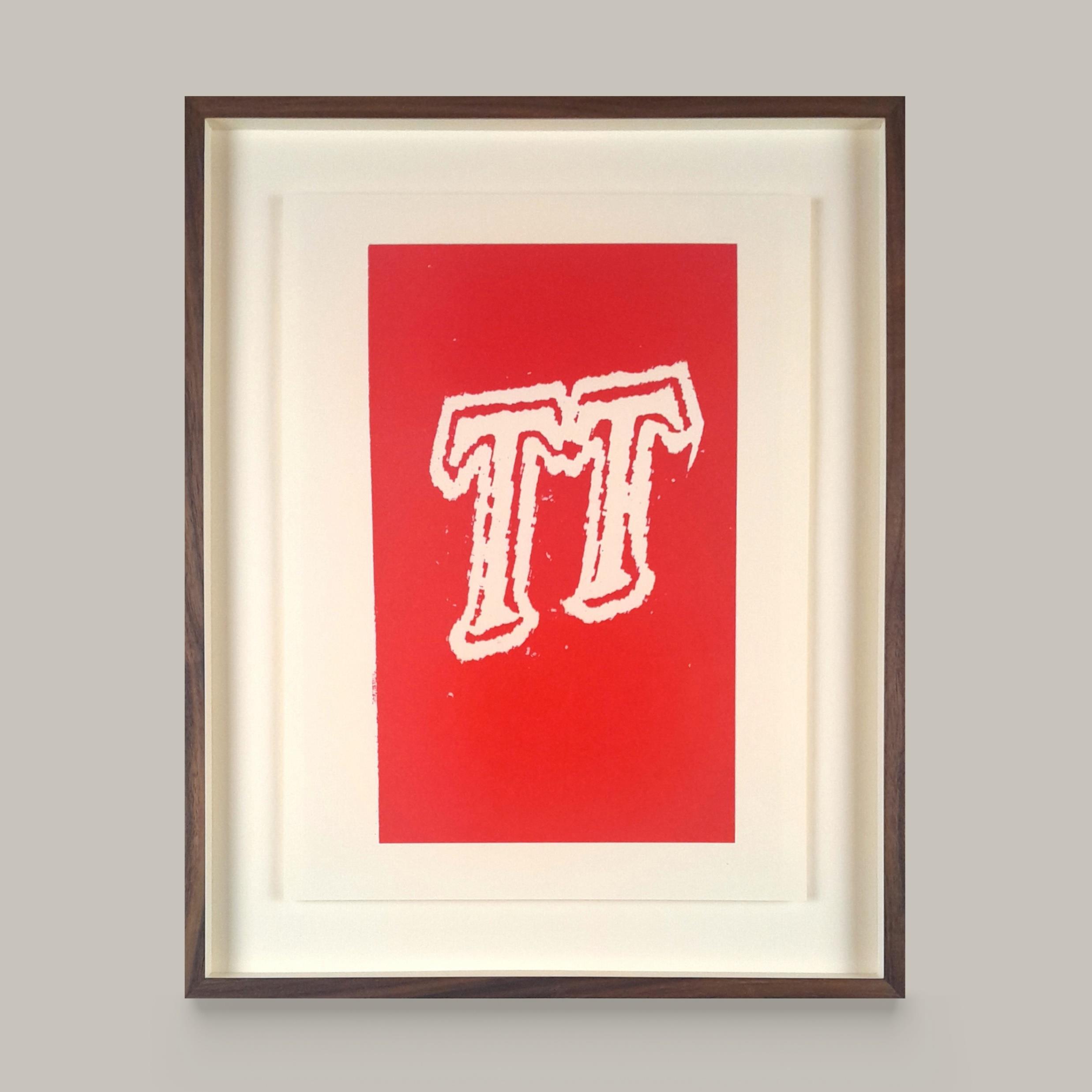
DAVID HOCKNEY
T by Kazuo Ishiguro
T is for T-Bone Steak, a dish renowned for its directness and simplicity. Much loved by veteran blues singers who go weeks without seeing daylight. Heartbroken cowboys, especially during divorce, may consume four or five a day without noticing. In its bloodier versions, this dish is capable of awakening atavistic dining instincts in the most urbane of us. It is said to attract closet cannibals. It would appeal to ageing vampire aristocrats but for the dread of exposing one’s own canines, in the very ecstasy of devourment, the crucifix of bone buried in the flesh.
I have rarely partaken of this dish myself. But once in my student days, on a bleak morning in the Pennines of northern England, I stopped to rest in an abandoned wooden bus-shelter and found one such steak, well-cooked but soiled, discarded on the ground beneath my seat. Another time, hitch-hiking in the windswept emptiness of Alberta, on a lonely highway at sunset, someone cruelly threw one at me from a solitary passing car whose approach had raised such hopes. I was, I remember, too exhausted to react until the steak was lying there at my feet in the mud and the vehicle was just a diminishing dot in the distance.
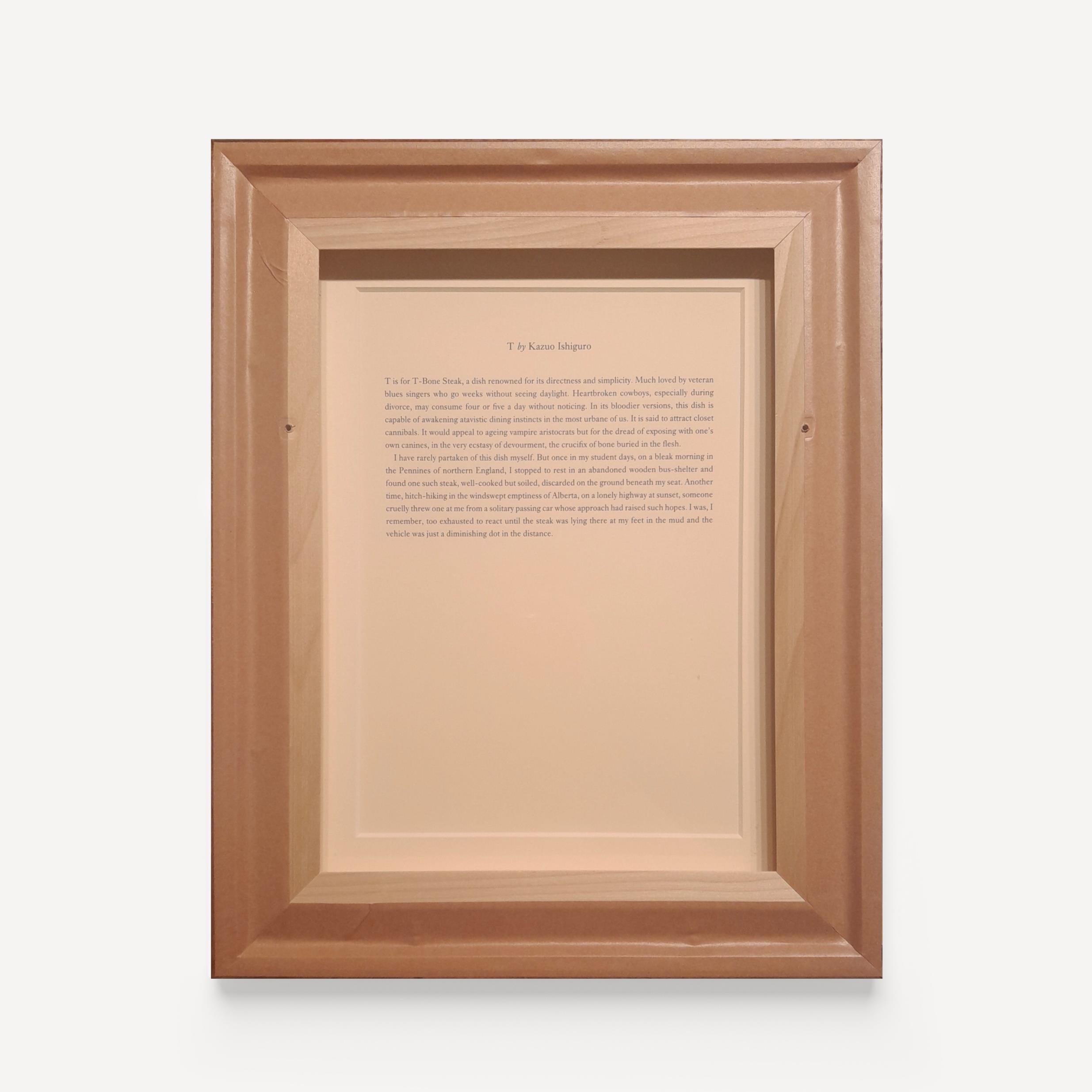
DAVID HOCKNEY
Lithograph on cartridge paper
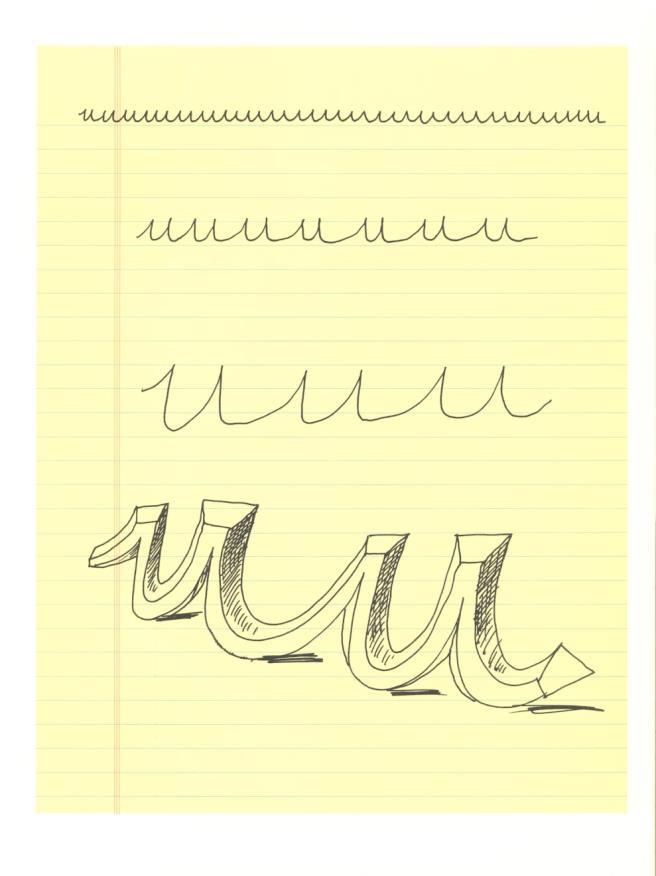
Sheet size: 24 x 32 cms | Frame size: 28 x 36 cms
Presented in a natural walnut box frame
Accompanied by the prose 'U' by Julian Barnes
Price framed: £850 | Price unframed: £550
Enquire about this item
U
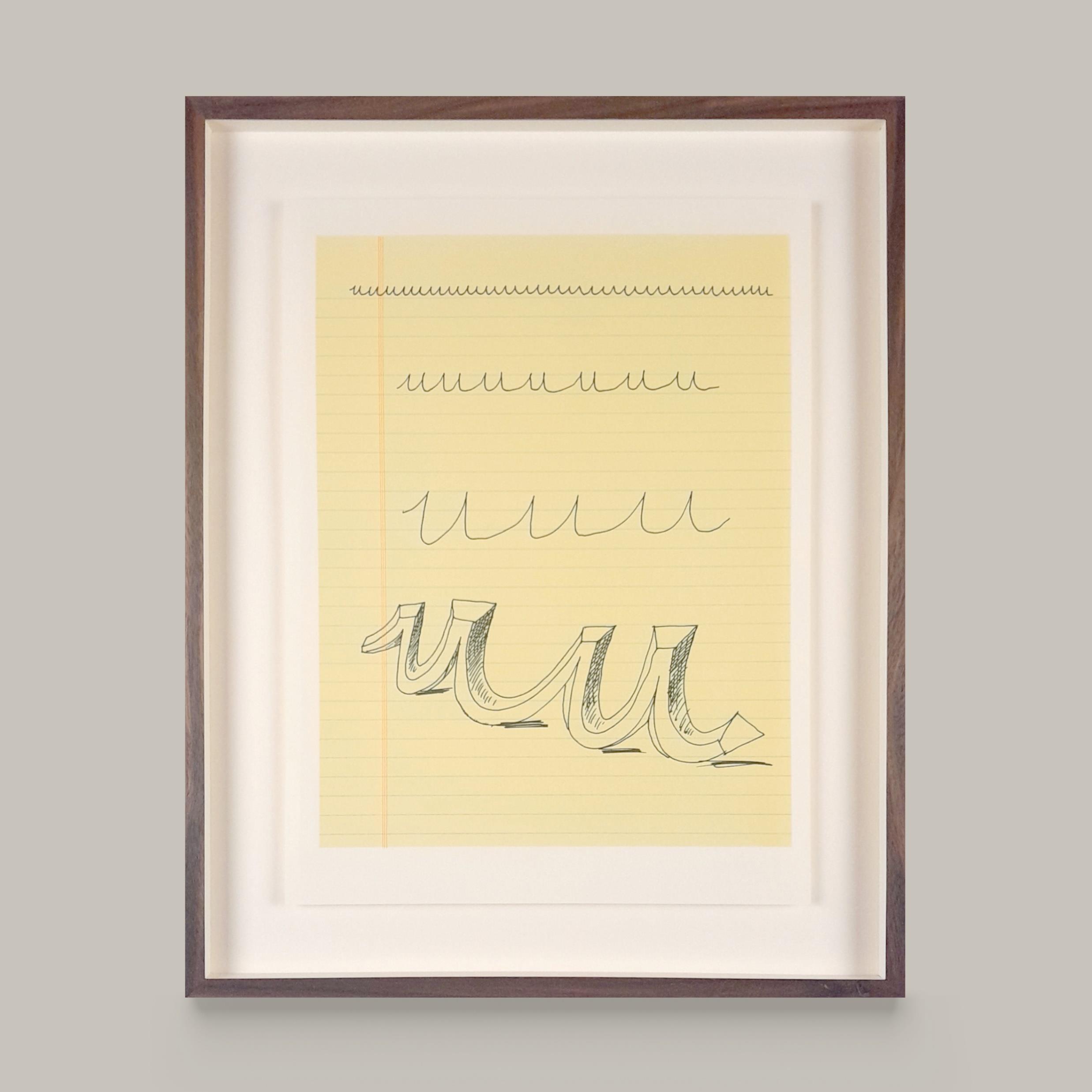
DAVID HOCKNEY
U by Julian Barnes
We were trying to decide the most sinister word in the English language. We started, unsurprisingly, with horror-movie stuff: necromancer, holocaust, rabies, syringe, gout. Soon we realised that this was mere representationalism: bad thing, bad word. So we became adjectival: crepuscular, curdled, inspissated, fetid. Then we tried suggestiveness: ought, ganglion, ukaz. We got skittish: gherkin, someone suggested, and VAT, twinset, virtue; what about sinister itself – isn’t that pretty sinister? We got stuck and went back to bad things again: wen, oven, plague. Finally one of our number said, ‘Unless…’ We all looked at her. ‘Yes?’ ‘No, that’s the answer,’ she replied. ‘Unless…’ It’s the oiled hinge of a sentence, a slick clunk of the points. Remember it from frightening stories in childhood: Unless this isn’t the door we came in by Imagine it in bankruptcy: Unless I’ve misread the figures. Fear it close to home. Unless, of course, I don’t love you any more. It remains menacing even in clichés: Unless I’m very mistaken. Whereas but is a short-arm jab in the face; unless is a subtle creak from underfoot which tells you that you’re standing on a trap-door. Its often attendant trail of dots (whether written down or not) extends that moment anguishing: Unless… Then the padded thump and your echoing wail as you fall through all you’d believed, known, replied upon. Unless: the most sinister word in the English language.
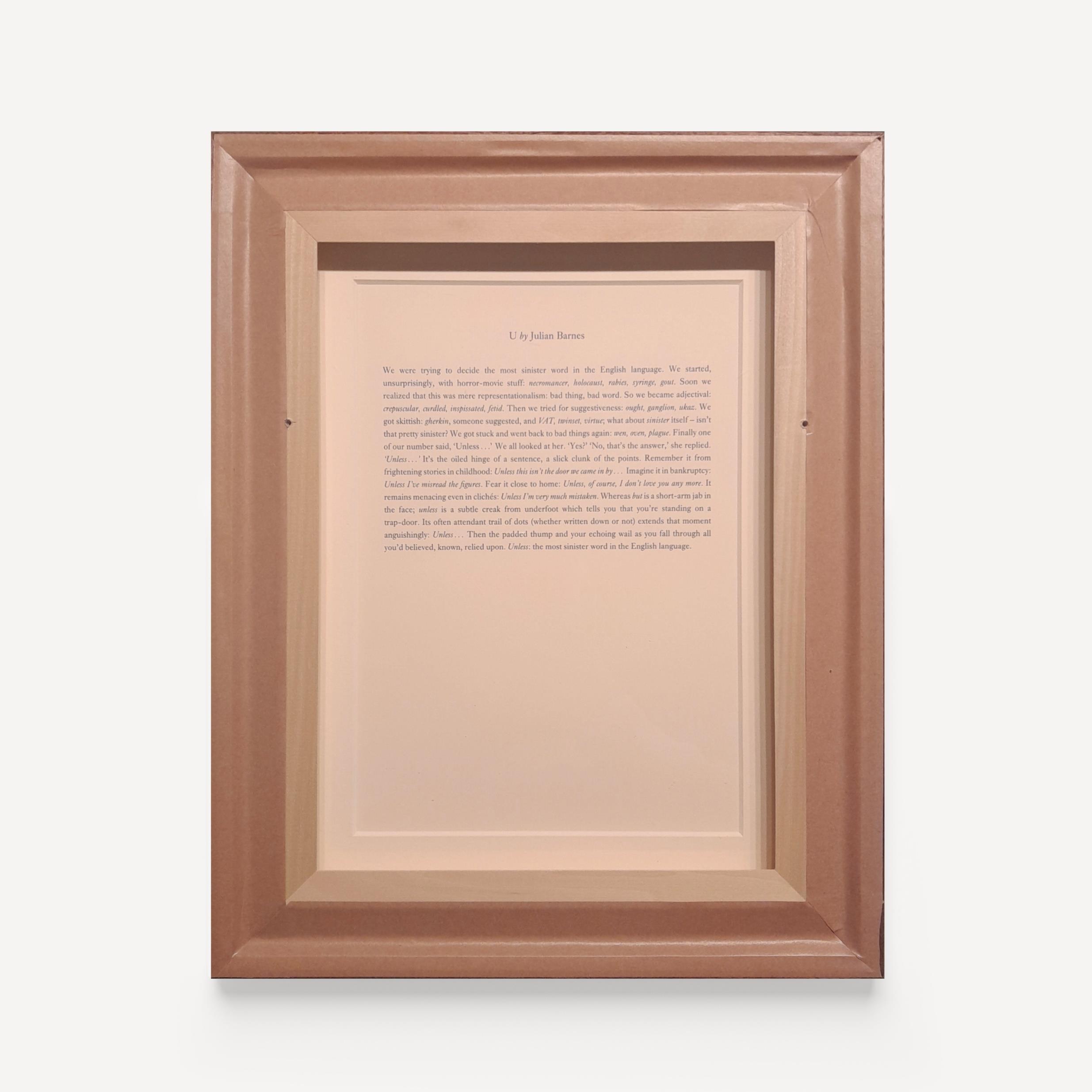
DAVID HOCKNEY
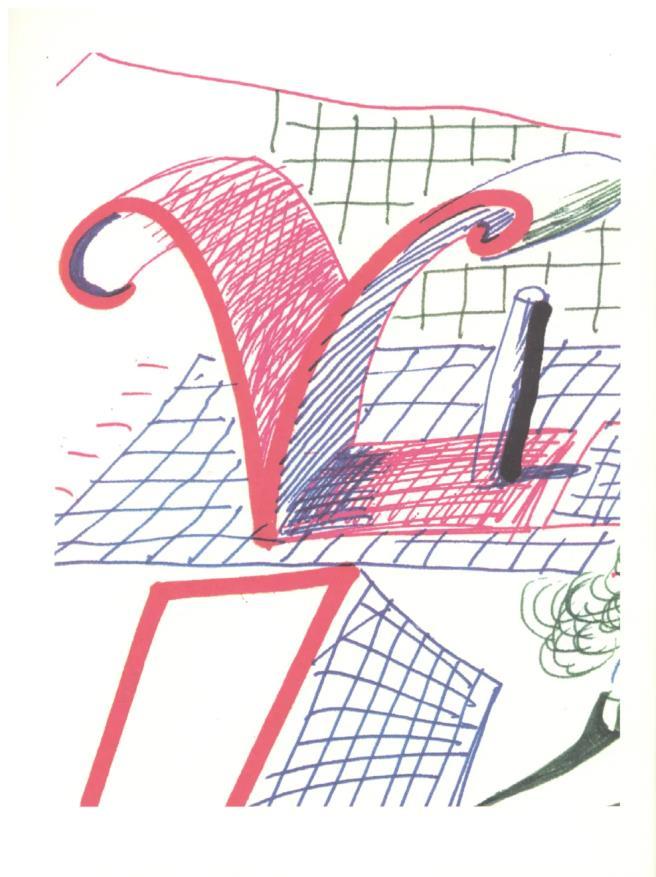
Lithograph on cartridge paper
Sheet size: 24 x 32 cms | Frame size: 28 x 36 cms
Presented in a natural walnut box frame
Accompanied by the prose 'V' by John Updike
Price framed: £850 | Price unframed: £550
Enquire about this item
V
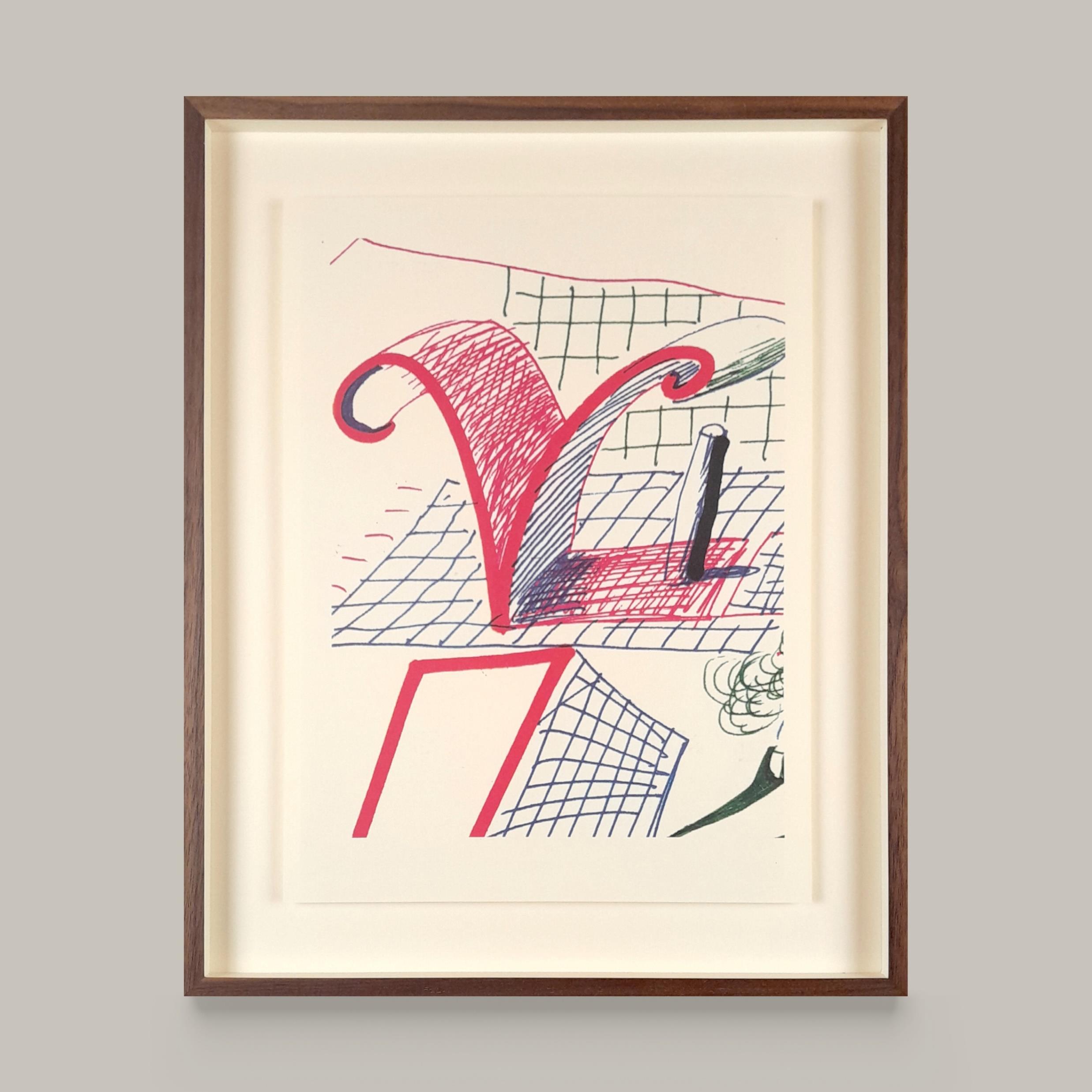
DAVID HOCKNEY
V by John Updike
V for venereal, of course, and for victory. These days it is the venereal diseases which are achieving victory: these few decades after penicillin banished syphilis and gonorrhea to the backwash of history. AIDS and herpes, both with palliations but without cure, have reattached a high price tag to sex. The existence of venereal disease at all argues against Providence and on behalf of a demonic Nature, which hormonally incites us to mate then invents a spirochete, a gonococcus, and a viral group that thrive at the thrilled point of contact. ‘Love has pitched his mansion in,’ Yeats wrote, ‘the placement of excrement.’ The place, certainly, of humid and susceptible membranes. As the Encyclopaedia Britannica puts it in its usual level-headed fashion, it all seems natural and mild enough: the micro-organism behind gonorrhea simply has a ‘predilection for the type of mucous membranes found in the genito-urinary tract and adjacent area’; the ‘delicate’ syphilis microbe, like all of us, is saddled with ‘a requirement of moisture for life and transmission’. The HIV virus, in its complicated transactions with the human immunity system, just can’t help itself, and is doing, in rhythm with its macrocosmic carriers, what comes naturally. In the meantime, or venery, rather freshly armed with Freud’s blessing, feels inextricably bound up with our vitality and even our virtue, as well as our vanity and, in love’s cause, occasional villainy. It does not seem hard that, having so recently absorbed Freud’s blessing, we should now have to flinch from Nature’s curse.
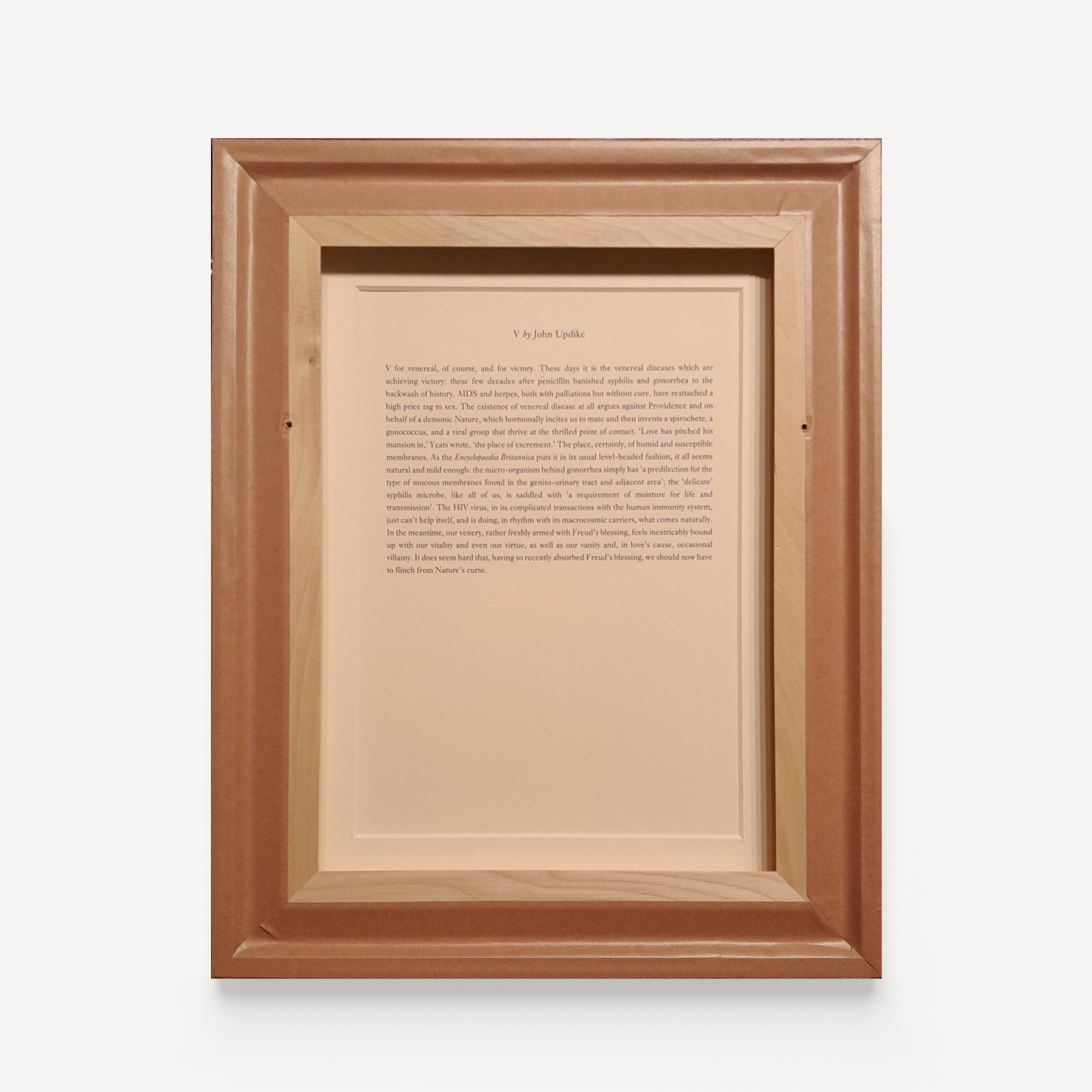
DAVID HOCKNEY
WLithograph on cartridge paper
Sheet size: 24 x 32 cms | Frame size: 28 x 36 cms
Presented in a natural walnut box frame
Accompanied by the prose 'W' by Susan Sontag
Price framed: £850 | Price unframed: £550 SOLD
Contact us if you are interested in the letter ‘W’, so that we give you priority notice if another becomes available.
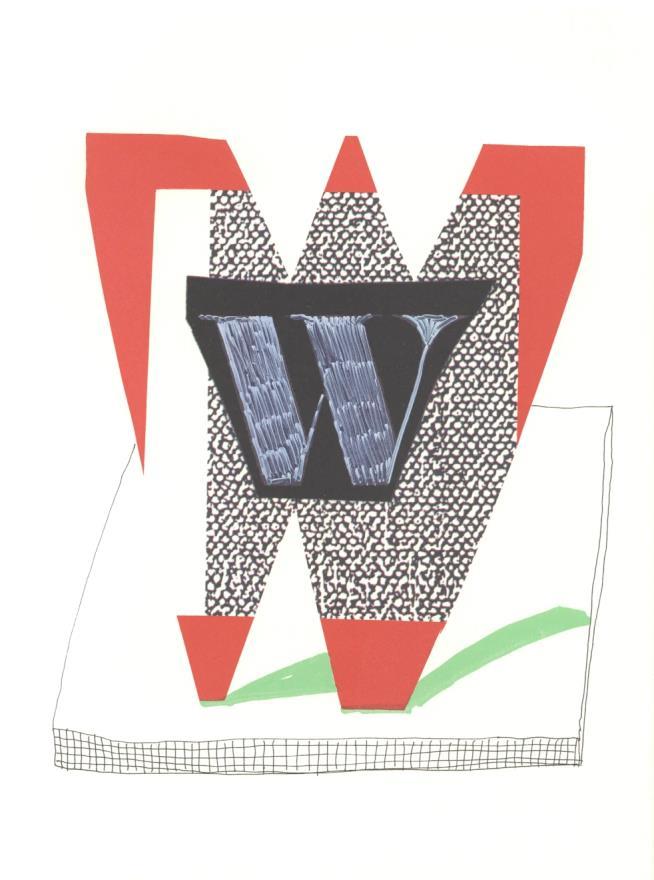
Enquire about this item
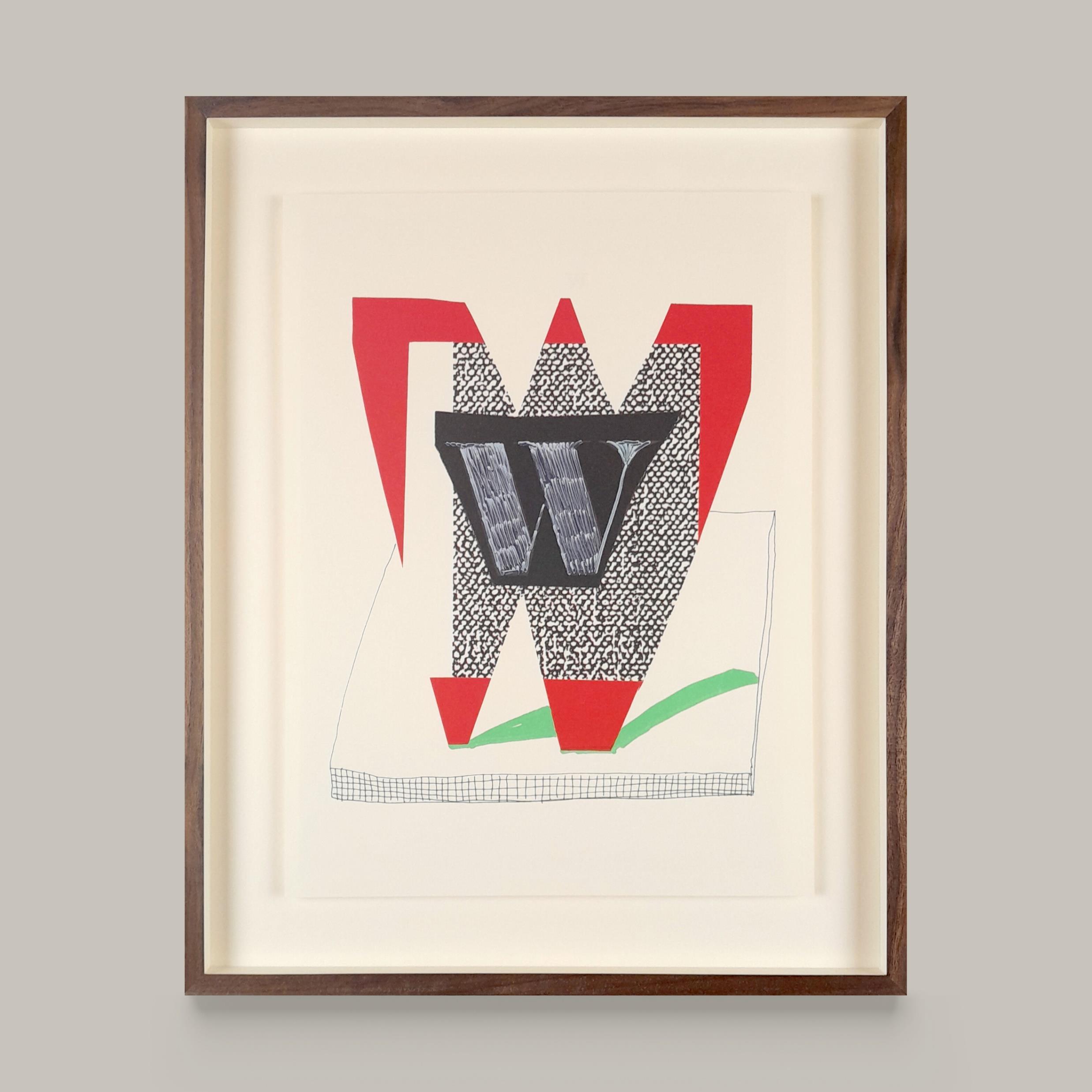
DAVID HOCKNEY
W by Susan Sontag
W might be for weather, an accordion topic of proven use in avoiding the not supposed to be mentioned or dwelt on. Imagine worse circumstances. Still worse. Even then the W-word may effect a change of mood, providing a welcome respite from weeping and wailing. That works better when we stick to real weather: north winds, say, rather than winds of change.
I usually don’t want to talk about weather. I have my wear weak wide eye on the whole picture. The will assists. When I don’t feel, I wilt. I don’t want to withhold. I don’t want to be well-defended.
(As I write these words, it occurs to me they’re women’s words.) I don’t want a mind of winter. And whimsey seems whorish.
But why not have a white topic, one that carries as much or as little weight as we wish?
Weather is always happening, always changing. What’s going to happen, we ask fearfully. Whatever happens, it will be something else.
When we’re talking about the weather, well, we’re giving ourselves a break.
The wonder is that one thing does not succeed another. Distracting us from the wound, from awareness of what co-exists. I am walking in the woods or gulping fresh water or encircling a child with watchful tenderness. And at that very moment, at this very moment, in the final agonies of a torture session in the wicked war a nearby government is waging against its citizens, inside a cardboard box in the doorway of the windward corner of my street, someone is, someone has just…
I know, it’s been explained, it’s called having a whole world.
I was sleepy. I’d stayed up all night working on my book. But I went to the museum. It was the last day. It was worth it, the paintings were wonderful. Then came the news we were waiting for. She wept. He wept. I wept. What amazing weather we’ve been having. Then we wondered over to a bar (this is Berlin) very near where the wall was (how we rejoiced) and drank some wine (and went on weeping). We move from one mood to another, giving due attention to each. (‘Our moods do not believe in one another,’ Emerson said.) There is no final mood. It is winter now.
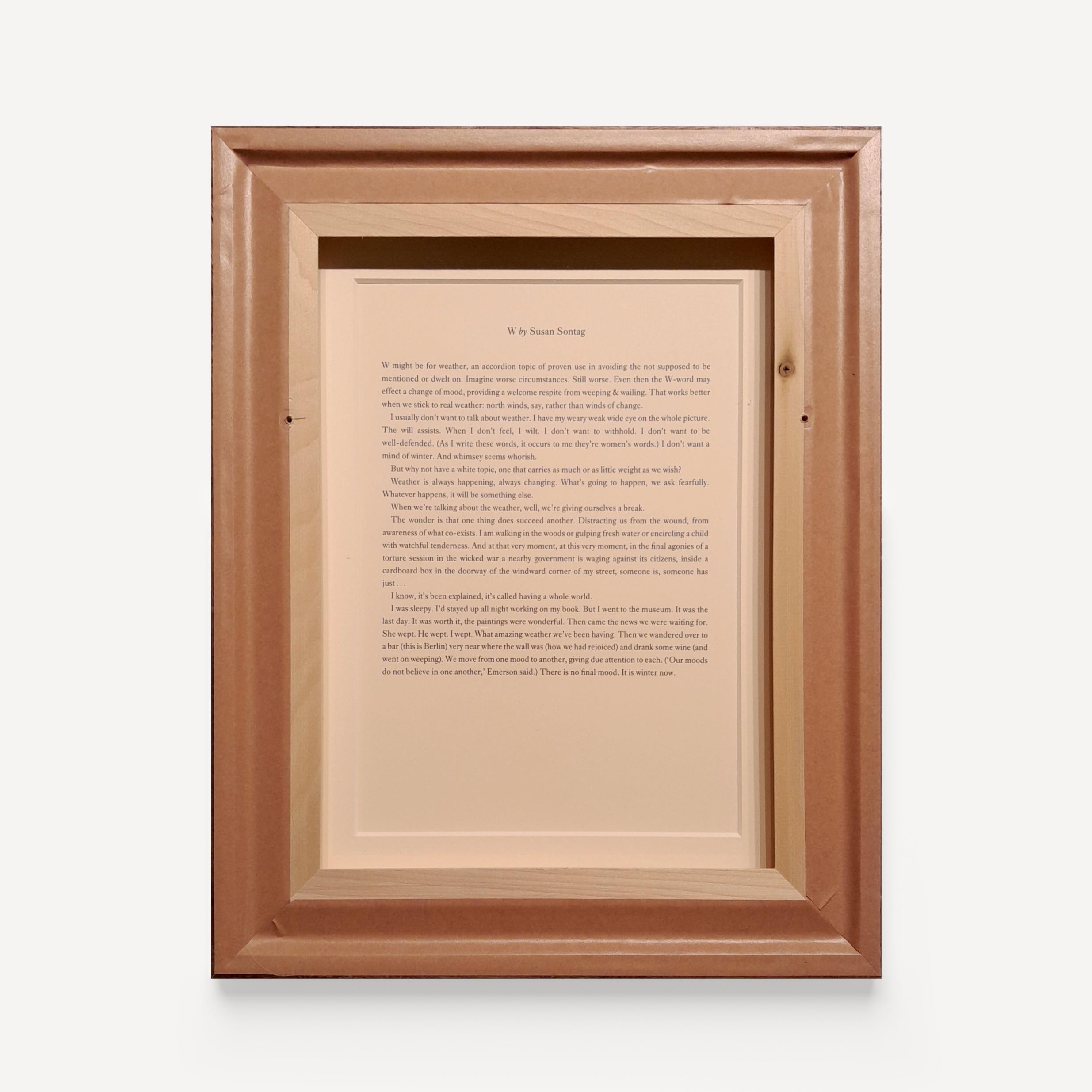
DAVID HOCKNEY
Lithograph on cartridge paper
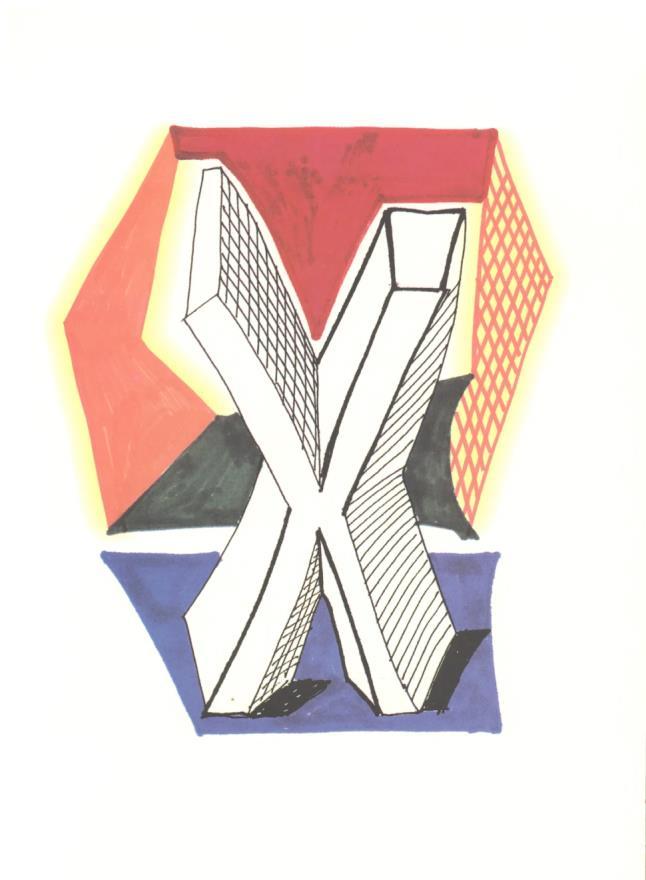
Sheet size: 24 x 32 cms | Frame size: 28 x 36 cms
Presented in a natural walnut box frame
Accompanied by the poem 'An Elegy for X' by Anthony Burgess
Price framed: £850 | Price unframed: £550 RESERVED
Enquire about this item
X
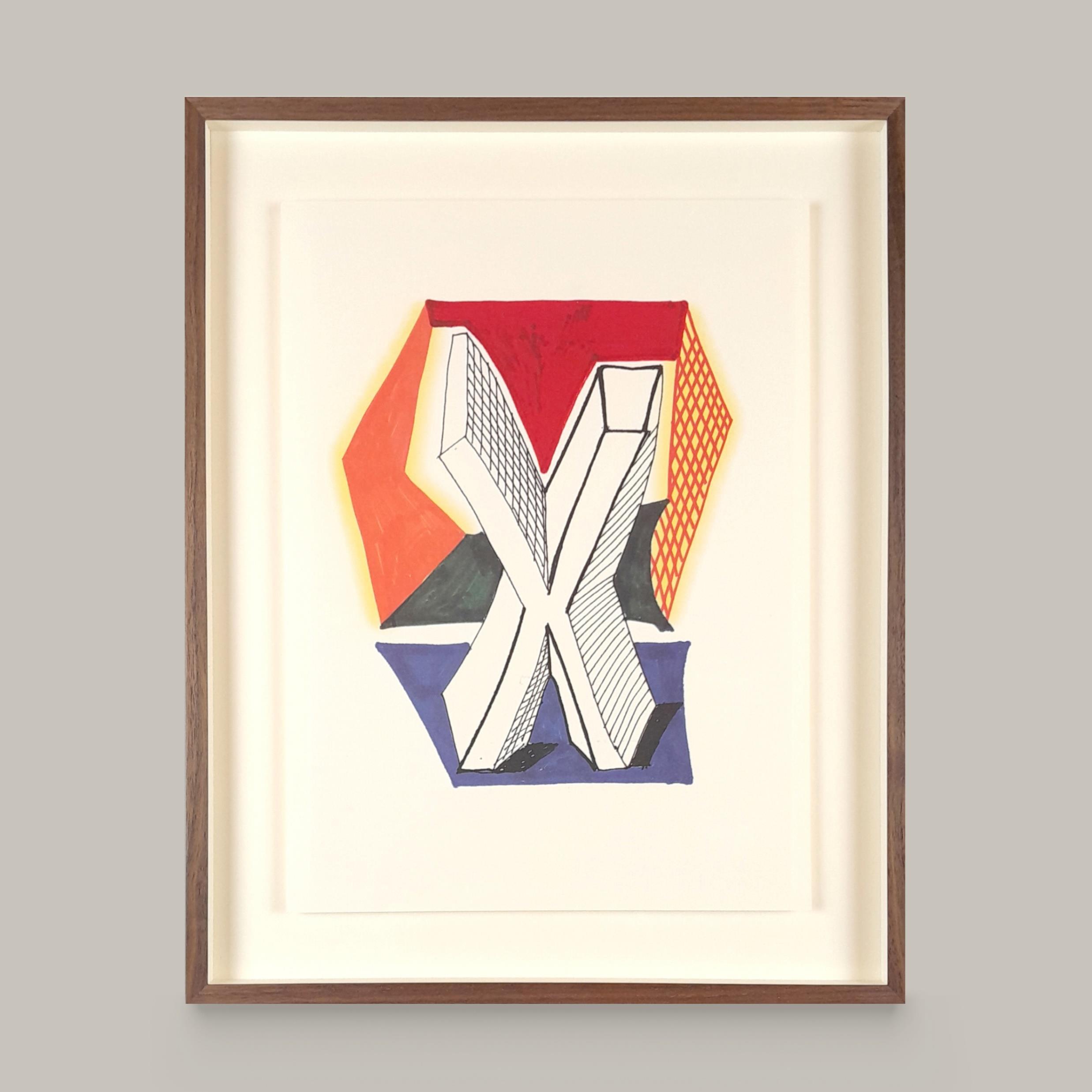
DAVID HOCKNEY
AN
ELEGY FOR X by
Anthony Burgess
X is unnecessary, like his brother
That ‘whoreson zed’ (King Lear) or like the other That stands between these two – the Grecian i, As Latins call it. You may ponder why
We need an X in taxi when you queue (There’s Norman tyranny. C double U
Will do, and did do for the Saxons when A queen had not dethroned a native cwen), Lugging your luggage from a train or bus, For tacsis at a Cymric terminus.
In Russia, if you have the time to wait, a taкcu is delivered by the State.
St Cyril gave the barbarous Russians X
For a good Grecian purpose. Even sex, A Western import, has a K and C.
The Welsh, though far from sexless, like to be X-less. And yet that letter was a brand
Of Celticness when Claudius stormed the land, Raping and pillaging, firing farmer’s ricks, Subduing what he thought were knavish tricks –
Asterix, Obelix, Vercingetorix.
X stands for sh in Malta; try Taxxbiex.
Venetians, scornful of the Roman leash, Mock X in rex and lex, bidding it dance
In place of voiced and unvoiced sibilants. Only in Xmas do we pay our dues
To the harsh velar Greeks and Russians use, For Christ is Xristos, and who spoke or wrote
The sacred name paid homage in his throat.
Now phoneticians sensibly denote
That fishbone-clearing phoneme with the letter
Which marks the sounds that K and S do better.
Was XXXXXX the ghastly agonizing rasp
St Andrew uttered in his final grasp
Spreadeagled on his special, chi-shaped cross?
It’s a sad letter. We won’t mourn its loss,
Let it be buried, vapourised or drowned
At least when it essays a double sound.
X is a cypher, X the great unknown, The sign of the analphabete, alone,
Along with brewing strengths, the pseudonyms
Of spies and co-respondents. Sing no hymns
Save frog-croaks. Only note where it is not
With this sole epitaph: ‘X marks the spot’.
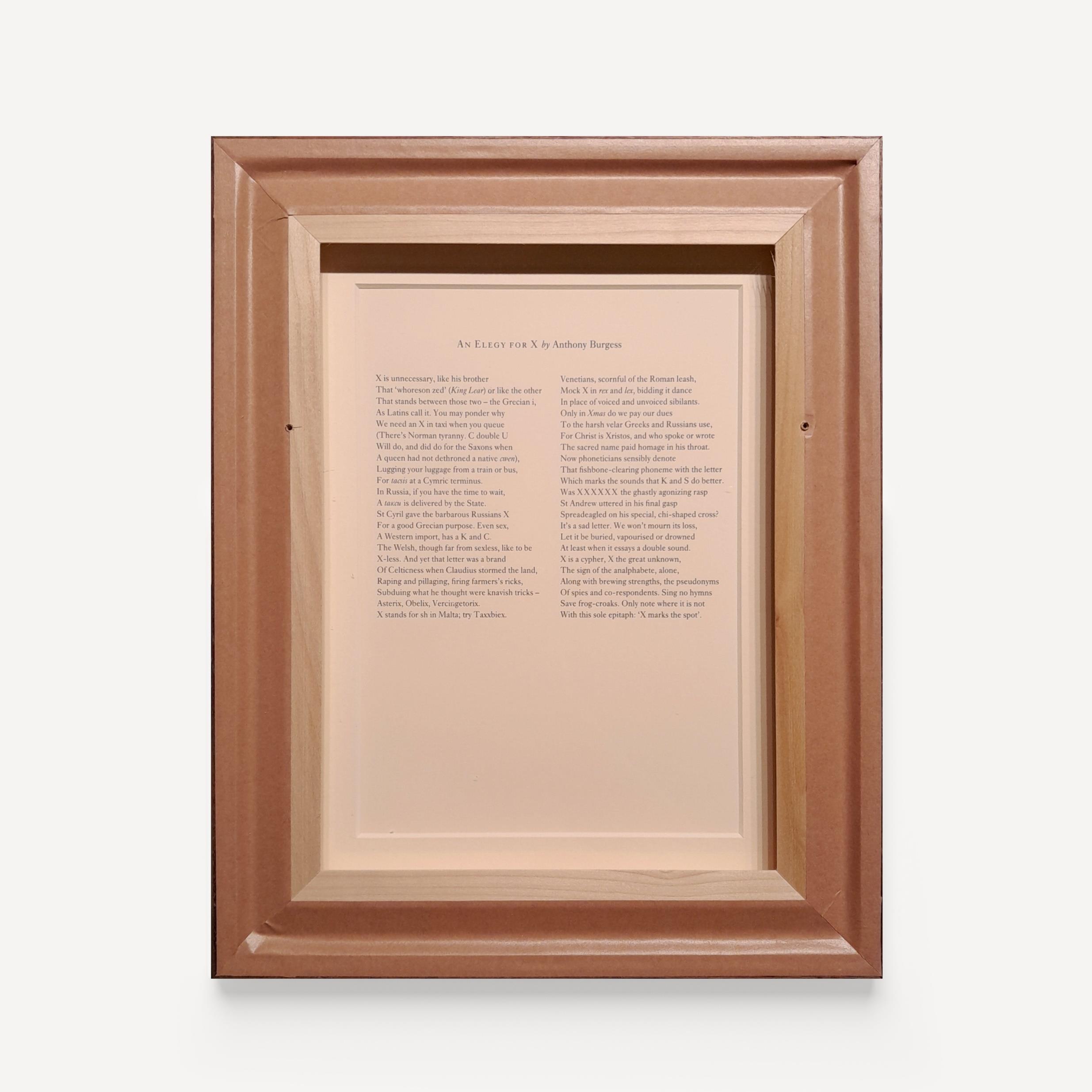
DAVID HOCKNEY
Lithograph on cartridge paper
Sheet size: 24 x 32 cms | Frame size: 28 x 36 cms
Presented in a natural walnut box frame
Accompanied by the prose 'Y' by Douglas Adams
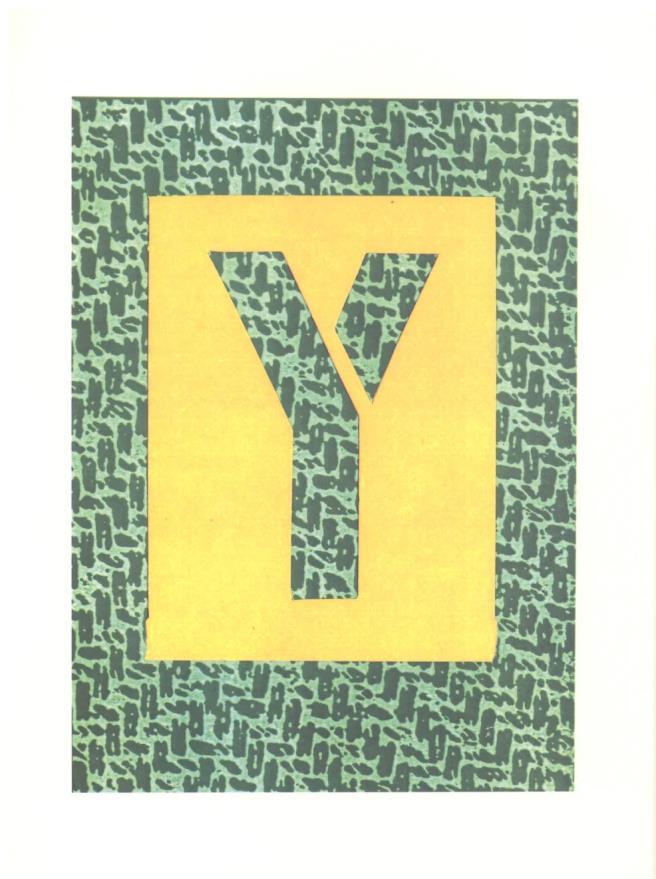
Price framed: £850 | Price unframed: £550
RESERVED
Enquire about this item
Y
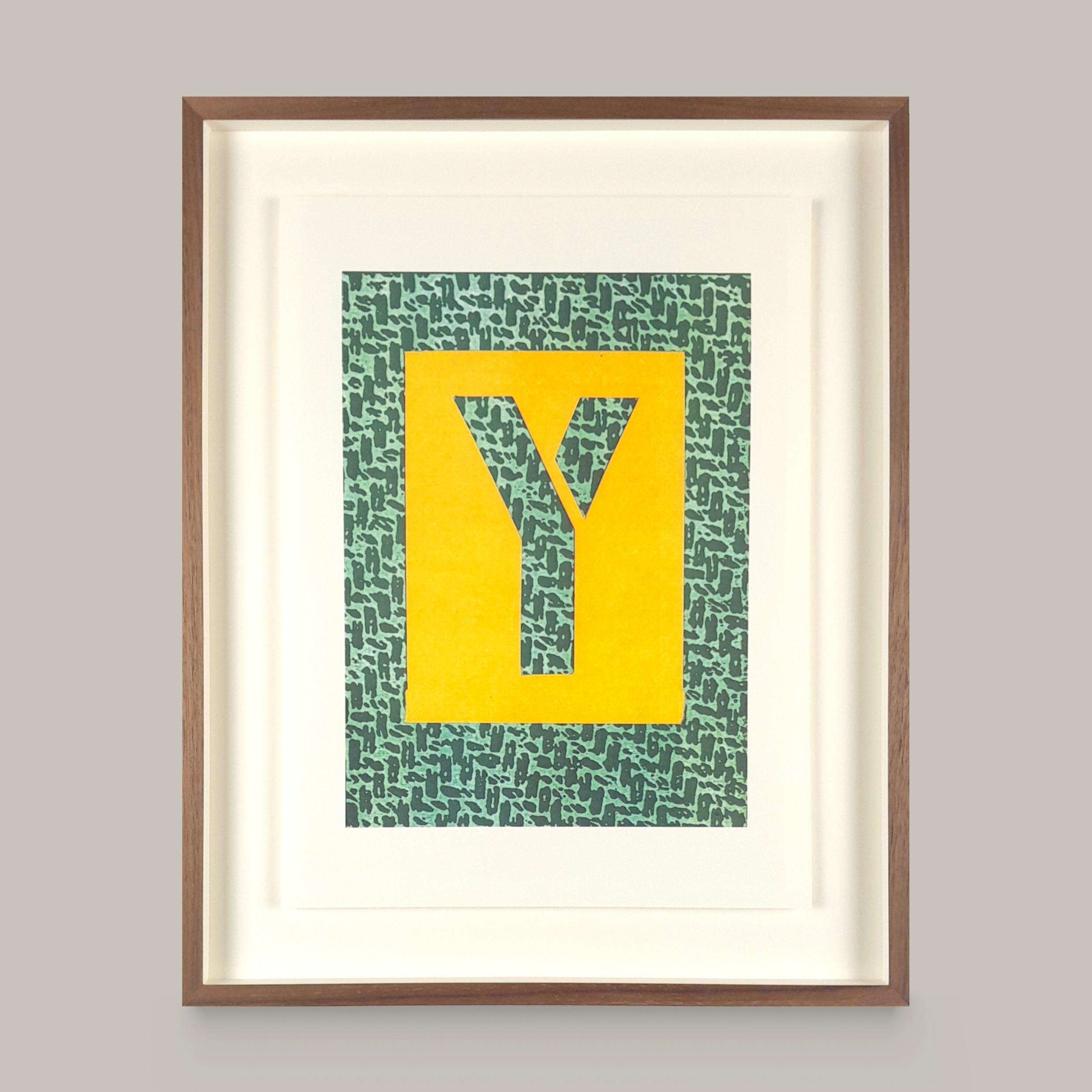
DAVID HOCKNEY
Y by Douglas Adams
‘Why’ is the only question which bothers people enough to have an entire letter of the alphabet named after it.
The alphabet does not go ‘A B C D What? When? How?’ but it does go ‘V W X Why? Z’.
‘Why?’ is always the most difficult question to answer. You know where you are when someone asks you ‘What’s the time?’ or ‘When was the Battle of 1066?’ or ‘How do those seat belts work that go tight when you slam the brakes on, Daddy?’ The answers are easy and are, respectively, ‘7.35 in the morning,’ ’10.15 in the morning,’ and ‘Don’t ask stupid questions.’
But when you hear the word ‘Why?’ you know you’ve got one of the big unanswerables on your hands, such as ‘Why are we born?’ or ‘Why do we die?’ and ‘Why do we spend so much of the intervening time receiving junk mail?’
Or this one:
‘Will you go to bed with me?’
‘Why?’
There’s only ever been one good answer to the question ‘Why?’ and perhaps we should have that in the alphabet as well. There’s room for it. ‘Why?’ doesn’t have to be the last word, it isn’t even the last letter. How would it be if the alphabet ended, not ‘V W X Why? X’, but V W X Why Not?’
Don’t ask stupid questions.
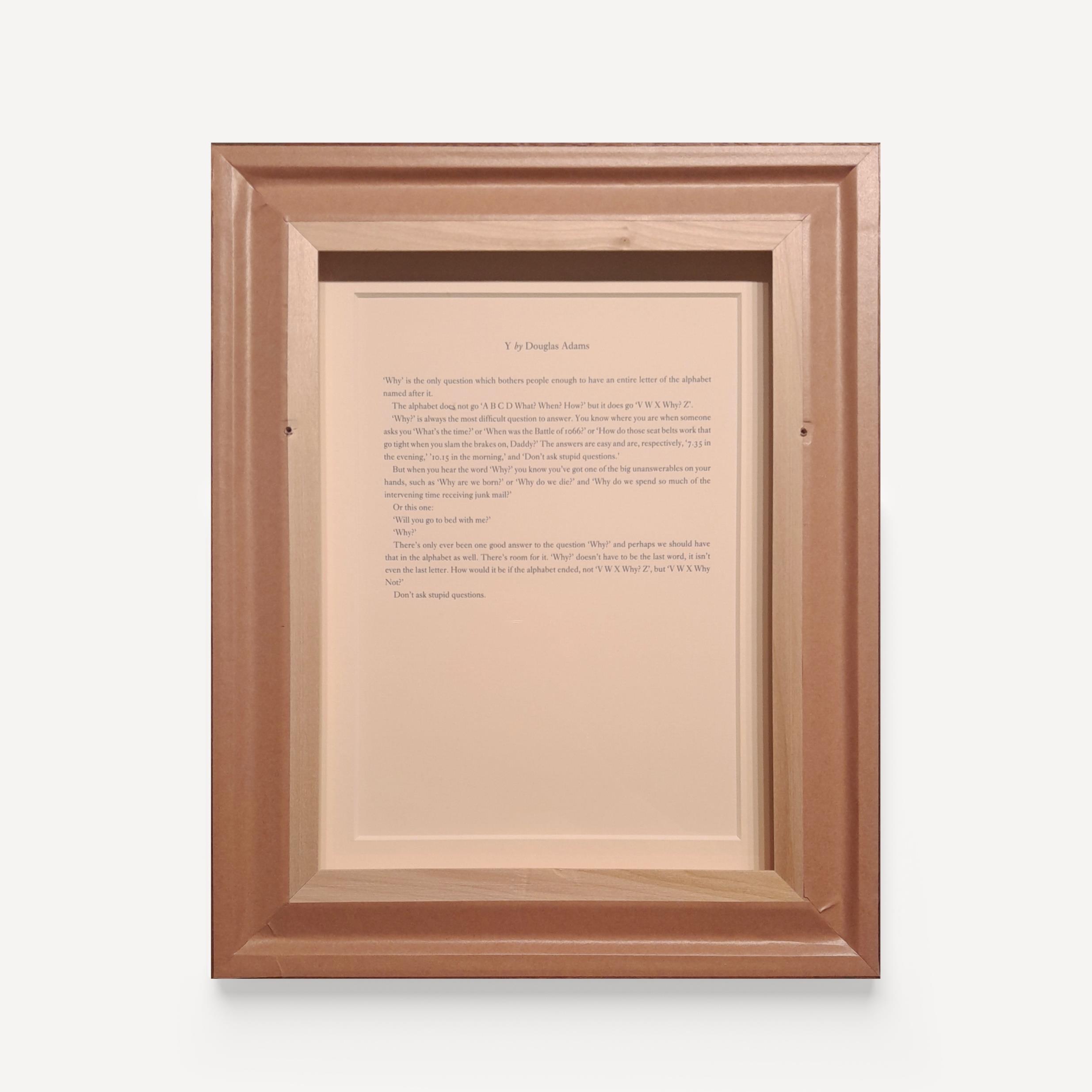
DAVID HOCKNEY
Lithograph on cartridge paper

Sheet size: 24 x 32 cms | Frame size: 28 x 36 cms
Presented in a natural walnut box frame
Accompanied by the poem Fête Champêtre by Patrick Leigh Fermor
Price framed: £850 | Price unframed: £550
RESERVED
Enquire about this item
Z

DAVID HOCKNEY
FÊTE CHAMPÊTRE
by Patrick Leigh Fermor
‘Zummerzetshire-zider’-zonked, zen zombies zig-zag… zippy
Young yob-yahoos yeastily yap-yelp-yell-yowl: ‘Yippee!’
Xerodermatic xiphoid xenophobes x-ray Xantippes, While wanton, woad-wet, wasp-waisted whip-wielders wallop willing whippees.
‘Vain, vapid voluptuaries vie vacuously:’ (Voltaire)
(Underground, Uniat underdogs unlace used underwear…)
Toxic tipsy tympanists tirelessly tap trite tattoos,
Sleazy soloists suck straws, swig sherry, swill shandy. Some stir stews, Rousing red-headed roughneck ravenous Ribena-fed retinues.
Quaint quirky queues quaff quarters. Quiet, questing queens Pathetically pursue puce pederastic palanquins, Obsessively out-Oscaring Oscar’s otiose Notions. Now noisome nymphomaniacs nobody knows Misguidedly manhandle mildly mascara’d matelots.
Look! Lords lambaste ladies! Ladies lords lacerate!
(‘Kossacks kidnap kappelmeister!’ ‘Kalmucks kybosh Kate!’)
Jeep jangles jeep, Jehu jolts Jezebel, Jack jostles Jill, Idle idiots imbibe ideas idler imbeciles instil.
Harmless homosexual hedonists hold heterodox hey-day, Gregarious gay gadabouts gather, gracefully going grey. Furtive fops follow fleetingly flaked-out fairies’ feuds, Eager ears eavesdrop. Every eye extrudes.
‘Dentist deflowers dons, dairymaids, duchesses, dingos, dudes… ’
(Cling close! Clasp cobber! Cool! Clap-clear clinch concludes…!)
Bogomils broach bashful burglars, but bent burglars bungle blast, And all, after acid’s acrid aftermath, abscond aghast.
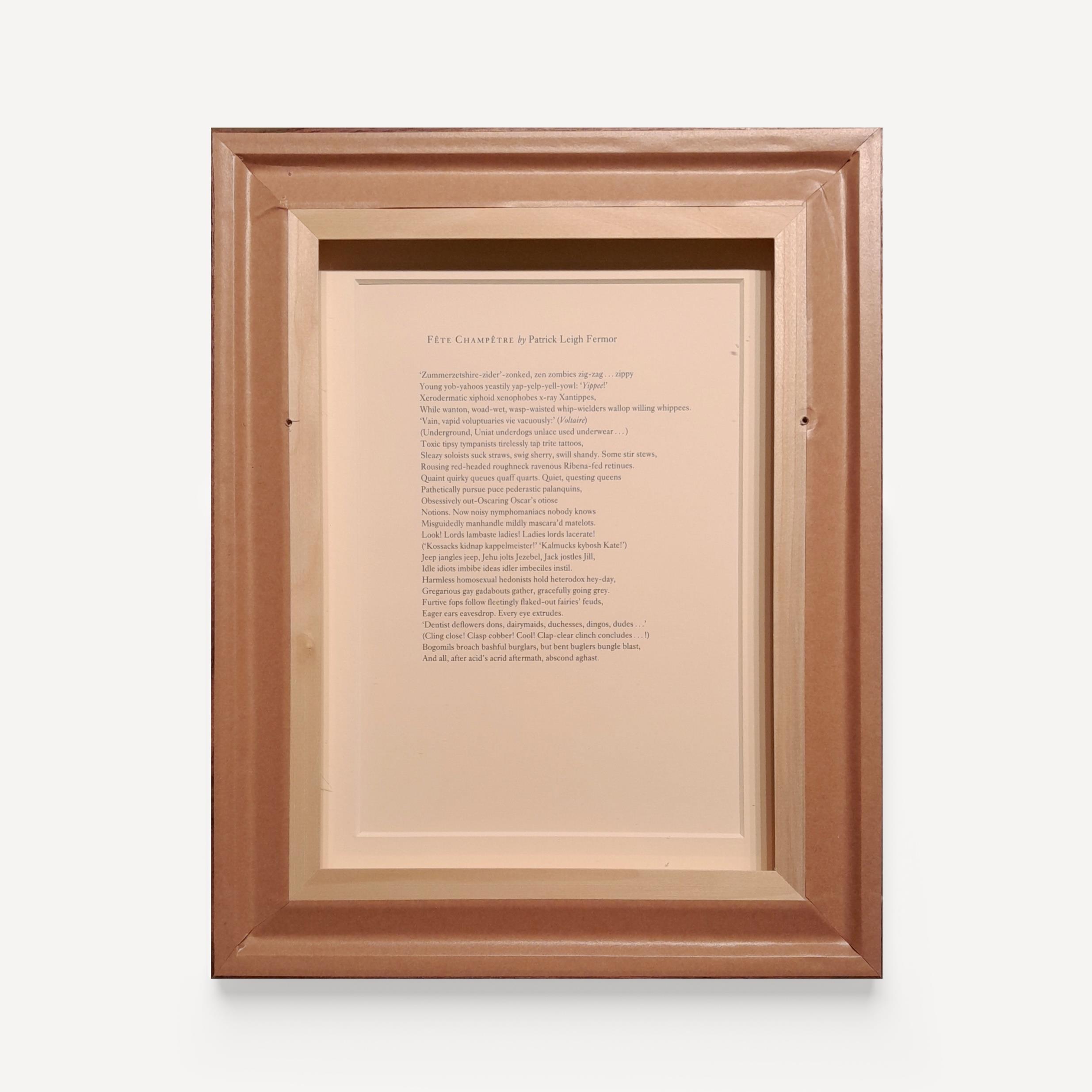
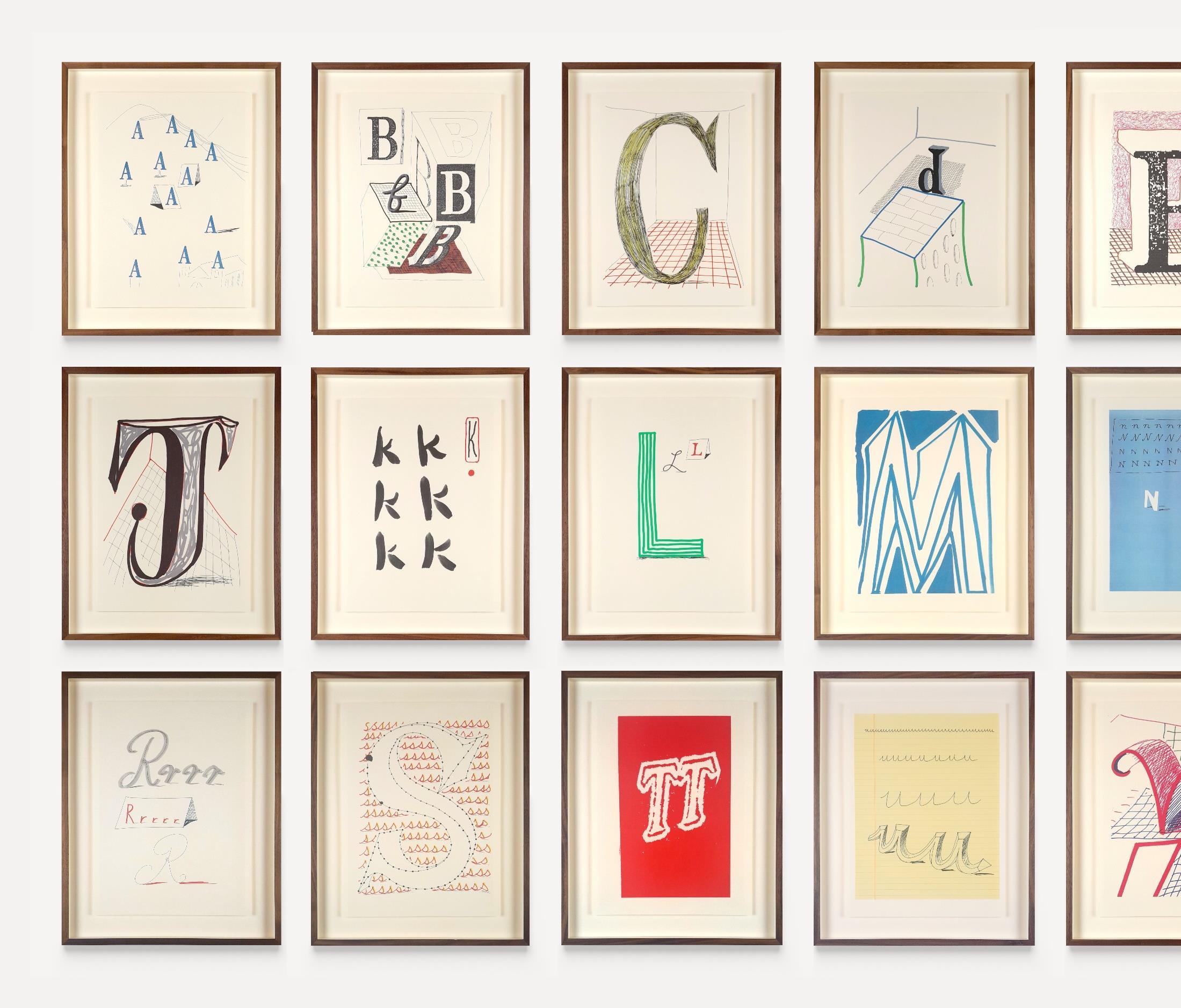
Enquire about this item
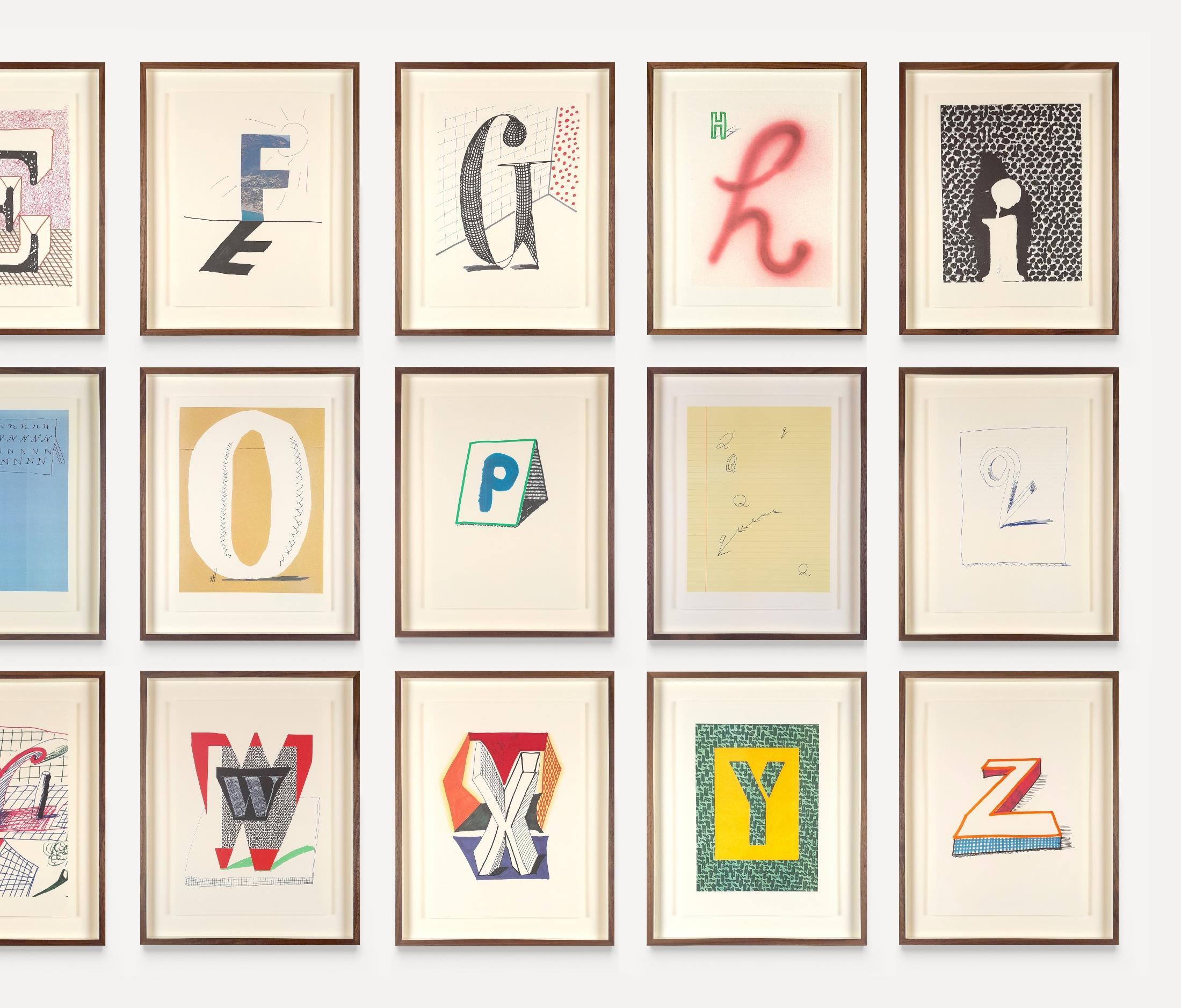
Enquire about this item
by both David Hockney and Stephen Spender
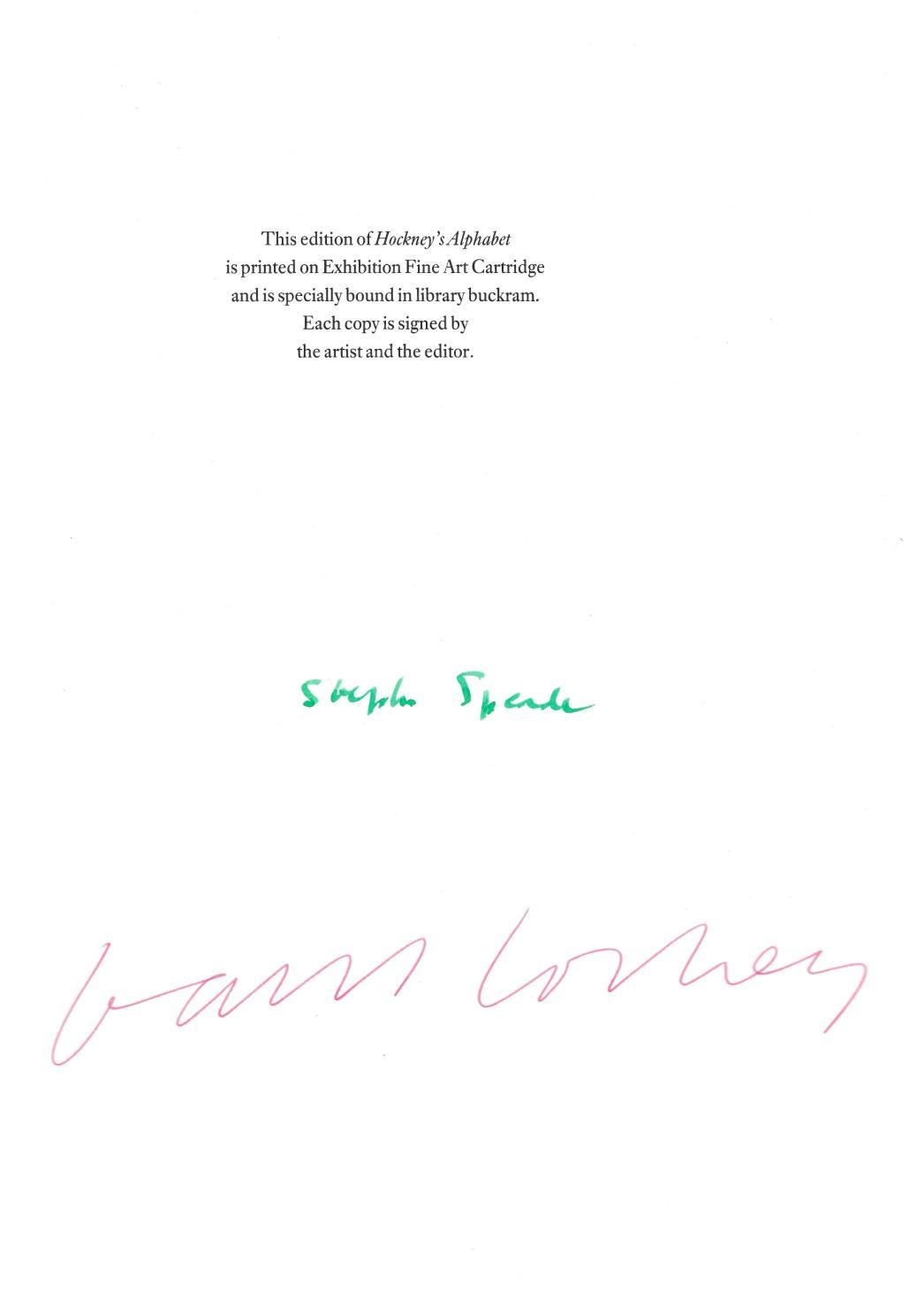
The Justification
signed
page
DAVID HOCKNEY
Complete A – Z Set
Lithographs on cartridge paper
Each Sheet size: 24 x 32 cms | Frame size: 28 x 36 cms
Presented in a natural walnut box frames
We are also offering an opportunity to acquire a complete framed set of Hockney’s Alphabet.
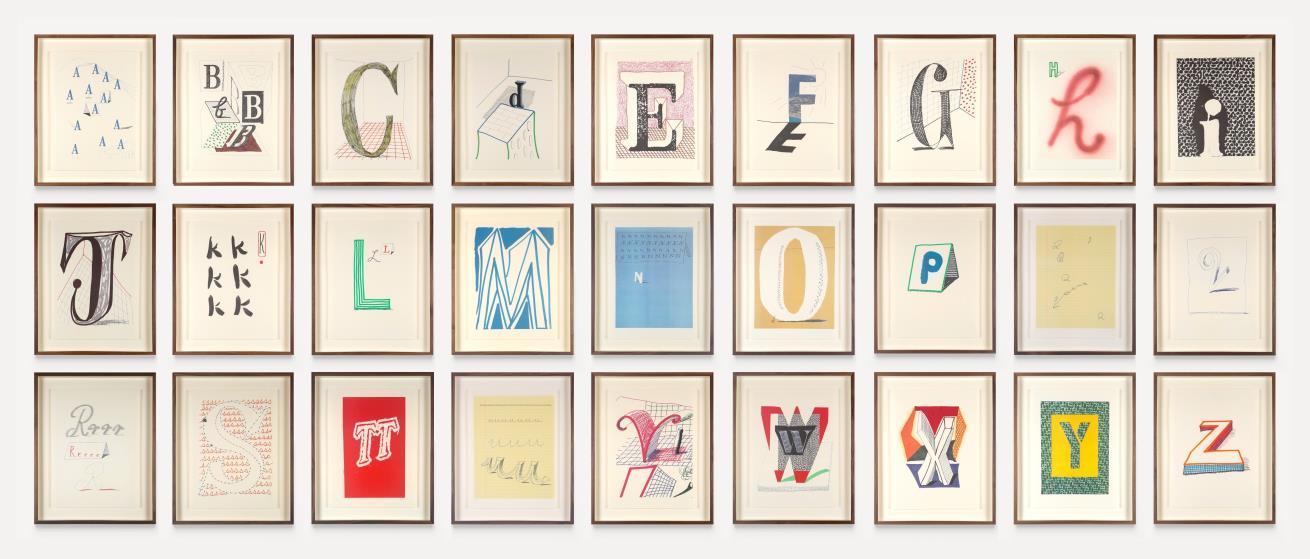
Comprising 30 framed artworks in total, including 27 Alphabet letters (there are 2 illustrations of the letter ‘Q’) and their accompanying texts. There are 3 additional pages of framed text, including the justification page which is signed by both David Hockney and Stephen Spender.
Please contact the gallery for more details.
Enquire about this item

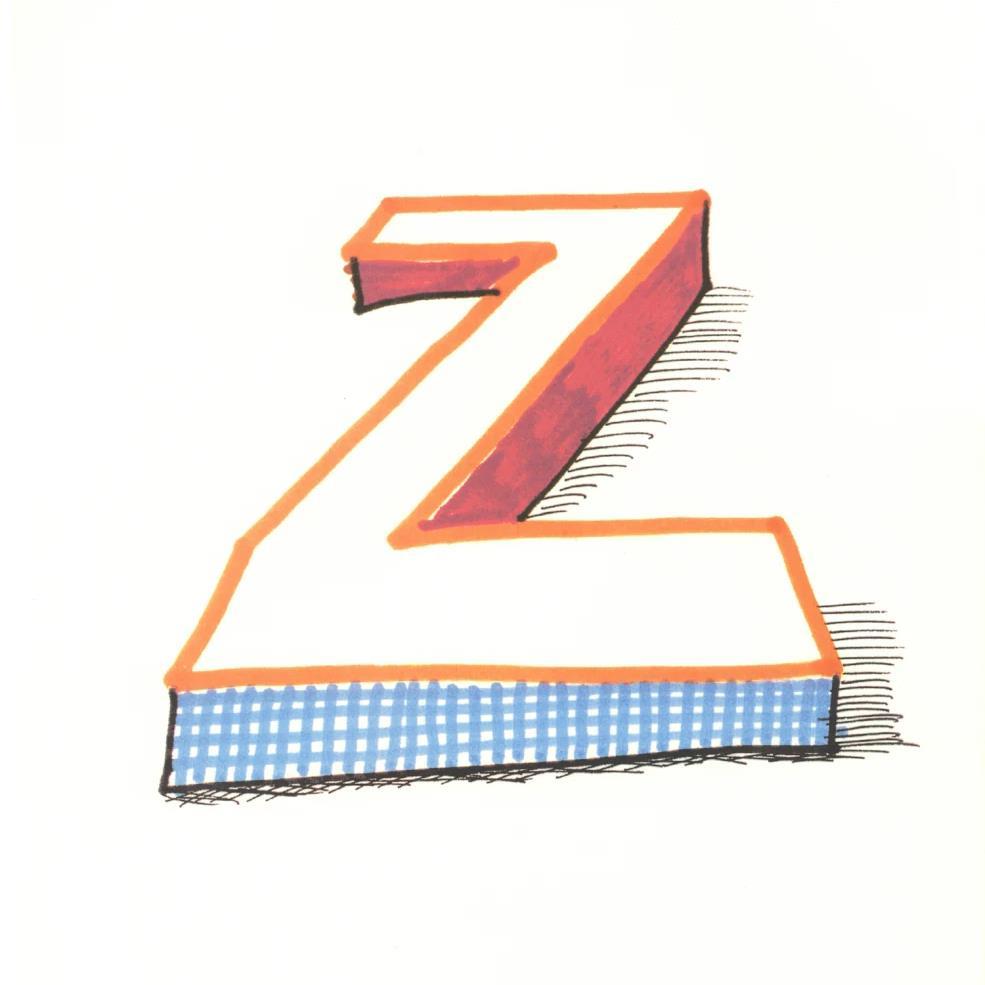
D A V I D H O C K N E Y
David Hockney was born in Bradford, England, on July 9, 1937. He loved books and was interested in art from an early age, admiring Picasso, Matisse and Fragonard His parents encouraged their son’s artistic exploration and gave him the freedom to doodle and daydream.
Hockney’s early paintings incorporated his literary leanings, and he used fragments of poems and quotations from Walt Whitman in his work. This practice, and paintings such as We Two Boys Clinging Together, which he created in 1961, were the first nods to his homosexuality in his art
Because he frequently went to the movies with his father as a child, Hockney once quipped that he was raised in both Bradford and Hollywood. He was drawn to the light and the heat of California, and first visited Los Angeles in 1963 He officially moved there in 1966 The swimming pools of L A were one of his favorite subjects, and he became known for large, iconic works such as A Bigger Splash. His expressionistic style evolved, and by the 1970s, he was considered more of a realist.
In the late 1980s, Hockney primarily started painting seascapes, flowers and portraits of loved ones He also began incorporating technology in his art, creating his first homemade prints on a photocopier in 1986. The marriage of art and technology became an ongoing fascination he used laser fax machines and laser printers in 1990, and in 2009 he started using the Brushes app on iPhones and iPads to create paintings A 2011 exhibit at the Royal Museum of Ontario showcased 100 of these paintings
In a 2011 poll of more than 1,000 British artists, Hockney was voted the most influential British artist of all time. He continues to paint and exhibit, and advocates for funding for the arts.
D A V I D H O C K N E Y ‘ S ALPHABET
The complete set of A-Z Hockney lithographs may be viewed at our gallery in Marylebone.
The Letters may be bought individually, unframed or framed.
We are also offering an opportunity to acquire a complete Set, comprising 30 framed artworks and their accompanying texts. Please contact the gallery for more details about the complete Set.
To arrange a viewing or to enquire about reserving or acquiring any of the artworks, please call the gallery on 020 7935 1114 or email Thomas@gloucesterroom.com.
Prices are quoted inclusive of VAT (UK Sales Tax). For information about Net Export prices, please contact the gallery.
G L O U C E S T E R R O O M 5 New Cavendish Street London W1G 8UT 020 7935 1114 info@gloucesterroom.com @gloucester_room_london
